
THE DETECTION PROBLEM:
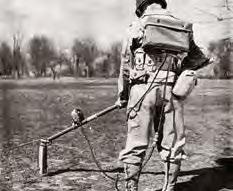
An Eight-Decade Challenge
Localization in Mine Action
Emergency EORE: Lessons from Ukraine
Inclusive Data Management
Coordinating HMA and Emergency Trauma Response
Surveying Battlefields in Solomon Islands
Reducing Armed Violence in Coastal West Africa










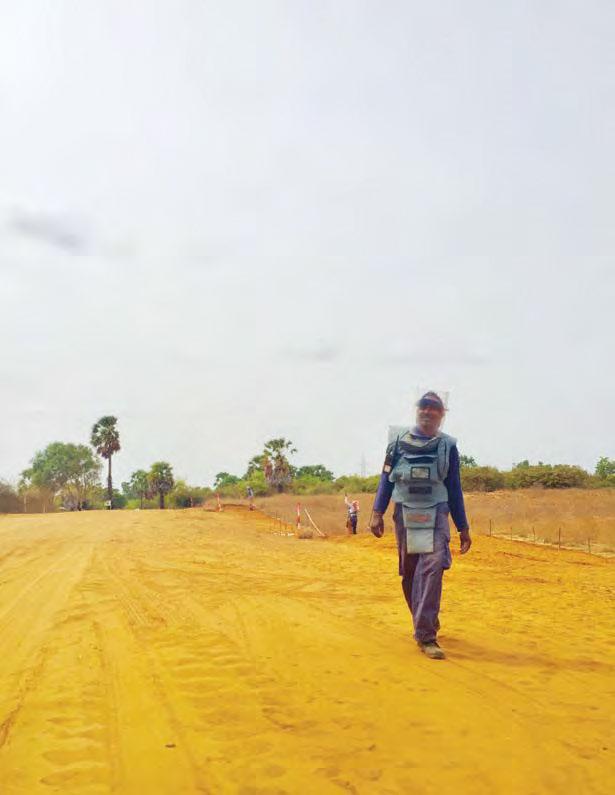

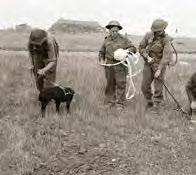
Issue 28.1 | Winter-Spring 2024 THEJOURNAL
Conventional
SOS SURGEONS OVERSEAS
of
Weapons Destruction
Special thanks to our contributing organizations
The Journal of Conventional Weapons Destruction
Center for International Stabilization & Recovery (CISR)
James Madison University - MSC 4902
Harrisonburg, VA 22807 / USA
Email: cisr-journal@jmu.edu
https://www.jmu.edu/cisr
ISSN: 2469-7575
• The Journal of Conventional Weapons Destruction
• Issue 20.1 ongoing: (print) ISSN 2469-7575; (online) ISSN 2469-7605
• For previous ISSN numbers visit www.jmu.edu/cisr/journal/about.shtml
The Journal of Conventional Weapons Destruction is a professional trade journal for the humanitarian mine action/conventional weapons destruction community, including but not limited to mine action, physical security and stockpile management, small arms and light weapons, and other conventional weapons destruction related topics.
The editorial board reviews all submissions for content and accuracy, as well as suitability for The Journal. The editorial board reserves the right to reject articles.
Authors who submit articles to The Journal are expected to do so in good faith and are solely responsible for the content therein, including the accuracy of all information and correct attribution for quotations and citations.
Please note that all rights to content, including images, published in The Journal are reserved. Notification and written approval are required before another source or publication may use the content. For more details please visit our website or contact the managing editor.
This publication is funded by grants from the US Department of State. The opinions, findings, and conclusions stated herein are those of the author[s] and do not necessarily reflect those of the US Department of State, the US Department of Defense, James Madison University, or the Center for International Stabilization and Recovery.
ON THE COVER:
Historical photos of demining being conducted after World War II. Courtesy of IWM, Imperial War Museums and the War Department, US Government.”. A deminer walks on an area fully excavated by means of raking and mechanical excavation. Courtesy of Roly Evans. (See article page 58).



Issue 28.1, Winter/Spring 2024
*CISR website: https://jmu.edu/cisr/journal/current-issue.shtml
*JMU Scholarly Commons: https://commons.lib.jmu.edu/cisr-journal
*ISSUU.com: https://issuu.com/cisr-journal
*accessible html or pdf available
TOPICS FOR VOLUME 28 (2024)
28.2 SUMMER 2024 | 28.3 FALL 2024
• Accessibility, Diversity, and Gender
• Clearance & Technology
• Countries/Regions
• Environmental Mitigation
• Funding & Sustainability
• Health and Safety
• Physical Security and Stockpile Management
• Risk Education & Victim Assistance
For detailed topics see
https://www.jmu.edu/cisr/journal/cfps.shtml
CISR Staff
SUZANNE FIEDERLEIN, PhD, Director
NICOLE NEITZEY, Assistant Director Publications Staff
SABRYN HEBERT, Assistant Editor
HEATHER HOLSINGER, Communications & Publications Manager
JENNIFER RISSER, Managing Editor
BLAKE WILLIAMSON, Communications & Publications Specialist Programs and Support Staff
AMY CZAJKOWSKI, Senior Project Manager/Program Coordinator
CAROLYN FIRKIN, Office Operations Manager
ADRIENNE HARMON-GRIGGS, Project and Program Specialist
LETITIA TURNER, Program/Financial Assistant
CHARLIE EICHELMAN, Graduate Assistant Editorial Board
MICHAEL BUTERA
SUZANNE FIEDERLEIN, PhD
STEPHANIE PICO
JENNIFER RISSER
KRISTIN SKELTON
JABIN VAHORA Center for International Stabilizational and Recovery
Follow us on LinkedIn: https://linkedin.com/company/ jmucisr
Like us on FACEBOOK: https://www.facebook.com/cisrjmu
Follow us on INSTAGRAM: https://www.instagram.com/cisr.jmu
Follow us on X: @cisrjmu
The Journal
A NOTE FROM THE DIRECTOR
This issue of The Journal is different than the norm in that we feature more in-depth studies and articles on a variety of important issues currently affecting our mine action community:
• Markus Schindler (FSD) presents a thoughtful reflection on the concept of localization in mine action, highlighting its unique challenges and proposing solutions to enhance local capacity while ensuring long-term sustainability of local actors.
• Hannah Wild (University of Washington), Loren Persei, Elke Hottentot, Sebastian Kasack (MAG), Firoz Alizada (APMBC Implementation Support Unit), Adam L. Kushner (Surgeons Overseas), and Barclay T. Stewart (Global Injury Control Section) discuss the Mine Action Trauma Care Collaborative’s initiative to foster collaboration between the mine action sector and health responders, capitalizing the sector’s field presence in conflict and post-conflict environments to enhance trauma care provided to those injured by explosive weapons.
• Simon Conway (HALO) highlights how The HALO Trust is addressing the legacy of unexploded ordnance and abandoned unexploded ordnance in Solomon Islands.
• Nick Vovk (DRC) discusses lessons learned from the application of explosive ordnance risk education (EORE) in Ukraine from February 2022–September 2023, gathered from the DRC Lessons Learned workshop on emergency EORE, highlighting coordination and monitoring, digital materials, EORE for displaced persons, and the integration of EORE within a broader humanitarian response.
• A study from Maysa Hajjaj, (GICHD), Lauren Burrows, Teia Rogers (JRNY Consulting), Natalia Lozano, Sarah Kamal, and Samban Seng looks at current data management methodologies, highlighting how a contextually nuanced approach informed by gender, diversity, inclusion, and protection perspectives is needed in the mine action sector.
• Clément Meynier’s (MAG) study of SALW proliferation in Coastal West Africa discusses the need to apply an armed violence reduction lens in addressing SALW activities while incorporating SALW control within holistic development and peacebuilding frameworks.
• Roly Evans, Tracey Temple, and Lt Col (Retd) Liz Nelson (Cranfield University) analyze the “detection problem,” asserting that despite the vital importance of mine detection and clearance, humanitarian and military actors struggle to reliably detect and discriminate victim operated explosive devices, antivehicle mines, improvised explosive devices, and booby traps.
We hope these insightful articles inspire reflection and discussion amongst our readership. And in looking toward the months ahead, we look forward to meeting with our colleagues at the upcoming mine action conferences in Croatia, Geneva, and Azerbaijan.
IN THIS ISSUE
Localization in Mine Action: Where the Possible Meets the Necessary
By
Markus Schindler [ Fondation suisse de déminage ]
The Mine Action Trauma Care
Collaborative: Enhancing Coordination Between Humanitarian Mine Action and the Emergency Health Response to Civilian Casualties of Explosive Ordnance
By Hannah Wild, Christelle Loupforest, Loren Persi, Elke Hottentot, Sebastian Kasack, Firoz Alizada, International Blast Injury Research Network, Adam L. Kushner, Barclay T. Stewart, PhD
Surveying Eighty-Year-Old Battlefields in Solomon Islands
By Simon Conway [ The HALO
Trust ]
Emergency Explosive Ordnance Risk
Education: Lessons Learned from Ukraine
By Nick Vovk [ Danish
Refugee Council ]
Inclusive Data Management: Reporting, Storing, and Sharing of Information on Beneficiaries in the Mine Action Sector
By Maysa Hajjaj, PhD [ Geneva International Centre for Humanitarian Demining ], Lauren Burrows, Teia Rogers [ JRNY Consulting ], Natalia Lozano, PhD, Sarah Kamal Elias, and Samban Seng
Working to Prevent and Reduce the Impact of Armed Violence in Coastal West Africa
By
Clément Meynier [ Mines Advisory Group ]
The Detection Problem: An Eight-Decade Challenge. The Difficulty of Practically Detecting and Discriminating Mines, Booby Traps, and Victim Operated Improvised Explosive Devices
By Roly Evans, Tracey Temple, PhD, and
Sincerely,
Suzanne Fiederlein, PhD

Lt Col (Retd) Liz Nelson [ Cranfield University ]
4 12 18 24 32 47 58 74 80
3 ISSUE 28.1 | WINTER/SPRING 2024
Endnotes Call for Papers
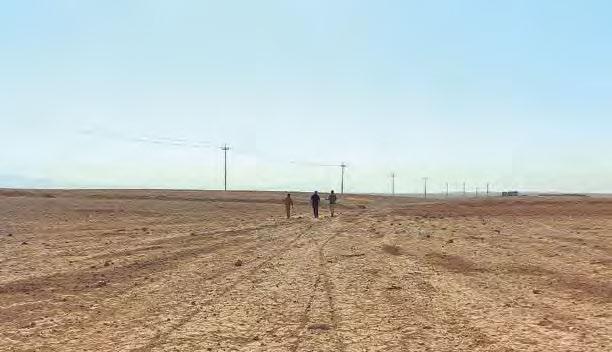
Localization in Mine Action: WHERE THE POSSIBLE MEETS THE NECESSARY
By Markus Schindler [ Fondation suisse de déminage ]
While arguments for greater localization in humanitarian aid are strong, in humanitarian mine action (HMA) the case is not always as clear and requires detailed discussion. Despite these challenges, however, the development of national nongovernmental organizations (NNGOs) in mine action is advocated for, as they can offer local knowledge, reduce costs, improve efficiency, and contribute to national ownership. HMA stands out from other sectors due to its resource-intensive and highly regulated nature, often necessitating the use of expensive equipment and specialized expatriates. This article discusses the concept of localization in HMA, emphasizing its distinct challenges compared to other humanitarian sectors. It further outlines the existing barriers to localization from the perspective of international donors, national authorities, international NGOs (INGO), and NNGOs while proposing solutions to enhance the capacity of national actors and ensure long-term sustainability of local HMA efforts.
Fondation suisse de déminage (FSD) and Shareteah Humanitarian Organization (SHO) staff walking outside an SHO hazard area, Iraq, August 2021.
Courtesy of Fondation suisse de déminage.
DEFINITION OF LOCALIZATION
The call for greater localization of humanitarian aid has been emanating from various directions. Many of the world’s leading donors, together with major INGOs and countless national counterparts are demanding more substantial national ownership in humanitarian action—exemplified in the Grand Bargain,1 where signatories have committed “to making principled humanitarian action as local as possible
and as international as necessary.”2 Despite its burgeoning appeal, however, the term localization is lacking a universally agreed definition. 3 In the context of this article, localization is understood as efforts that seek to increase local ownership within the humanitarian system by “empowering local responders in affected countries to lead and deliver humanitarian aid.”4
THE CONCEPT OF LOCALIZATION IN THE MINE ACTION SECTOR
While there is a growing concert of voices from the global south and many allies from the global north that are demanding change in the form of localization and “decolonialization” of aid, many of the arguments brought forward appear more akin to moral appeals than to evidencebased business cases that would convince donors to make substantial changes to their funding mechanism. 5 Given the modest advancements observed to date, it is imperative to address a fundamental question: Is localization a solution in search for a problem? This issue gains even more importance in the mine action sector, where many of the arguments for localization from the field of humanitarian action appear to carry less weight than in other sectors.
HMA is often considered an outlier within the field of humanitarian action, with sector-specific peculiarities that impact the justification, nature, and scope of localization. Most notably, HMA is particularly resource-intensive, necessitating high budgets to accommodate the costs associated with its execution. This expense is in part due to the procurement of specialized, often expensive equipment that can be challenging to import due to various regulatory and logistical constraints. Furthermore, the high-risk nature of mine action often demands the recruitment of highly specialized expatriates, whose expertise in this niche field commands premium remuneration. These factors, coupled with the heightened insurance costs intrinsic to high-risk
THE JOURNAL OF CONVENTIONAL WEAPONS DESTRUCTION 4
operations, underscore the substantial financial investment required for HMA.
Th e regulatory landscape of HMA is uniquely robust, characterized by stringent oversight from dedicated government bodies, such as National Mine Action Authorities (NMAA) and Centers (NMAC). These entities set out national strategies and enforce compliance with a framework of National Mine Action Standards (NMAS), in addition to adherence to relevant national legislation. NMACs are usually directly involved in tasking HMA operators with specific activities in clearly defined areas that are in line with national priorities. Moreover, HMA organizations are required to comply with International Mine Action Standards (IMAS) and internal standard operating procedures (SOPs). This regulatory environment ensures that mine action operations are executed within a rigorously controlled and standardized system, which is essential for both the safety of personnel and the effectiveness of the mine action efforts. As a consequence of such unique features, many of the justifications for the call of greater localization in humanitarian action do not carry the same weight when applied to HMA.
Lack of contextual understanding. Proponents of localization often argue that international actors may lack an indepth understanding of local contexts, including cultural,
social, and geographical nuances, which can lead to ineffective or inappropriate responses. However, HMA responses are often not only specifically prescribed by national authorities, but also highly regulated and standardized, leaving only limited room for adjustments to local contexts. Where such adjustments are possible, best practice recommends that they are developed and carried out by HMA organizations’ local staff with knowledge of the cultural context.
Unsustainability. Some argue that externally driven humanitarian interventions tend to struggle to maintain long-term impact after international organizations leave due to a lack of local ownership and involvement. While this may be the case for certain sectors in the humanitarian field, HMA differs in some fundamental aspects. INGOs in this field have displayed remarkable staying power, from Afghanistan to Laos—as long as funding is available. When there is a shortage of funding, INGOs may leave the country, returning once funding is available again. NNGOs lack this option, leaving them less resilient to funding shortages than INGOs. They stand to lose both equipment and staff, and in many cases become unable to operate and cease to exist, unless they also engage in humanitarian activities other than HMA where funding is available.
Insufficient local capacity. Another common concern is that without localization, there is a missed opportunity to build the capacity of national actors, local organizations, and communities, leaving them dependent and less equipped to
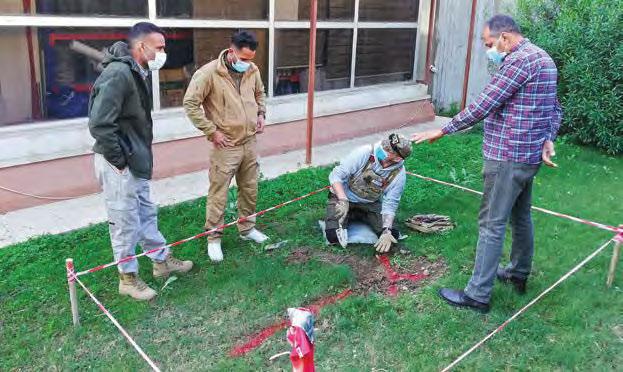 FSD Technical Advisor conducting capacity development activity on render safe procedures for SHO staff, Iraq, January 2021.
FSD Technical Advisor conducting capacity development activity on render safe procedures for SHO staff, Iraq, January 2021.
5 ISSUE 28.1 | WINTER/SPRING 2024
Courtesy of Fondation suisse de déminage.
handle future challenges, particularly in emergency situations where a quick response is essential. However, unlike many other humanitarian action sectors, HMA is already considerably national. In most explosive ordnance (EO)-affected countries, the sector is tightly regulated by national authorities (NMAA/ NMAC) that are staffed by national bureaucrats and experts. These institutions set and ensure the implementation of national standards, prescribe strategies, lead the prioritization of areas and activities, and regulate the mine action sector under their jurisdiction in many other ways—effectively exercising control over the design and delivery of HMA. Moreover, the vast majority of most HMA organizations’ staff are well-trained local employees who will use their knowledge, skills, and experience to improve the lives of their countrymen. Through this particular setup, mine action already entails a large degree of national ownership.
This is not to say, however, that localization of HMA would not be beneficial. On the contrary, there are good reasons to support the development of national mine action NGOs. For one, HMA efforts led by international actors without local involvement can face significant inefficiencies, higher costs, and delays, as well as a mismatch between services provided and actual needs. Thanks to local knowledge and networks as well as a lack of cultural or language barriers, local actors often
WHAT HAS BEEN DONE SO FAR?
The most straightforward approach to localization in HMA is the direct funding of NNGOs. Some intermediary funding institutions, particularly those with the capacity to manage numerous small grants, have applied this method for considerable time. However, the funding is usually of low quality in terms of size, duration, and predictability, generally includes no provision for indirect costs (“overhead”), and often requires a contribution from the NNGO. Such an approach does not allow NNGOs to build an operational, management, and support structure independent of individual grants, and it usually prevents NNGOs from venturing past explosive ordnance risk education (EORE) and non-technical survey (NTS), leaving the far more sizable clearance grants to INGOs and commercial mine action actors.
A second approach to localization in HMA is the provision of sub-grants by INGOs to NNGO partners, who are then responsible for the implementation of specific activities.

manage to build highly positive relationships with national authorities that can help in avoiding delays and addressing potential issues early on. More importantly, once local capacities are built, true humanitarian spirit should espouse the notion that national actors should be enabled to address national challenges. In addition, where NNGOs are able to receive national funding, this presents an ethical exit strategy for many international donors.
However, many such sub-grants suffer from similar shortcomings as small direct grants, as they are usually small in both size and scope and do not include funding for indirect costs or equipment. 6
In recent years, a new approach has been tested and has shown great promise. Capacity development partnerships between INGOs and NNGOs, such as the United Nations Mine Action Service’s explosive hazard management partnership grants in Iraq, transform the principal-agent relationship described previously into a mentor-mentee relationship.7 Rather than merely evaluating the mine action outputs of their grantees, some donors of capacity development partnerships have begun to measure the success of a grant in terms of the NNGO’s growth as an organization, including its technical capabilities, financial accountability, quality management, administrative functions, among others.
CHALLENGES TO LOCALIZATION
For localization in HMA, and in the humanitarian sector more broadly, to take root, three key stakeholders must be satisfied: institutional donors, INGOs, and the governments and relevant authorities of affected countries. Additionally, NNGOs harbor
a set of internal obstacles that equally require addressing for meaningful localization to ensue.
International donors. International donors and intermediary funding institutions face a particular set of challenges that
FSD Technical Advisor conducting capacity development activity on render safe procedures for SHO staff, Iraq, May 2021. Courtesy of Fondation suisse de déminage.
THE JOURNAL OF CONVENTIONAL WEAPONS DESTRUCTION 6
remain a key obstacle for localization of HMA, including legislative and political constraints, accountability concerns, and administrative issues. 8
These issues are further compounded by the fact that donors often lack clarity on how to measure success in localization efforts.
• International donors must navigate regulatory and political constraints in determining the eligibility of recipients for fund disbursement.
Before merging the United Kingdom’s Department for International Development with the Foreign and Commonwealth Office, former British PM Boris Johnson elaborated on his views about aid and foreign policy: “They are one and the same endeavour, and they’re designed to achieve the same goals, which are right in themselves and serve our national interest.”9
Statements and actions such as this make evident the connection between many states’ foreign policy objectives and their involvement in international humanitarian efforts. While this correlation is by no means ubiquitous among international donors, foreign policy considerations appear to have gained greater prominence in shaping decisions regarding humanitarian aid, particularly in the period following 9/11.10

INGOs are at times perceived as better suited to pursue a state’s national objectives through humanitarian action, and as a result, certain international donors seem reluctant to move away from INGO implementing partners. This is further compounded by some donors’ legislative requirements to spend a certain percentage of grant funding within their respective country, often resulting in the ineligibility of national NGOs.
International donors are concerned about NNGO capacities in risk management and the assurance of accountability. In uplifting NNGOs, the international donor community faces a major conundrum. On the one hand, entrusting their money to small, relatively unknown organizations, in unfamiliar and often opaque jurisdictions, that lack the stringent accountability standards of large, established INGOs of the global north
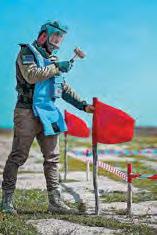
poses a major risk of financial mismanagement and outright corruption. On the other hand, imposing extensive financial management and reporting standards that took decades to develop and refine—which established INGOs had the opportunity to adapt to over this lengthy
Iraq, April 2023.
Courtesy of Shareteah Humanitarian Organization.
period—on fledgling NNGOs in the global south has little promise of feasibility. In the mine action sector, this dilemma is further compounded by the sheer size of grant funding that is required for impactful clearance operations.
One barrier has proven particularly prohibitive to the growth of NNGOs: To merely be considered for funding, many international donors require NGOs to provide audited financial accounts for at least three financial years. For young NNGOs in the global south, financial reporting requirements such as these are often beyond onerous for several reasons:
• Financial constraints: Local NGOs often operate on limited budgets and may not have the resources or funding to conduct formal audits, which can be expensive.
• Funding status: In the early stages of their development, NNGOs are often implementing partners on sub-grants from INGOs. As such, their international partners often hold the budget and fulfill the audit requirements, leaving local NGOs without audited accounts.
• Manpower: Smaller NGOs may not have dedicated large accounting or financial departments capable of maintaining the level of financial reporting required for audits.
• Technical knowledge: NNGOs often lack the technical accounting expertise and understanding of the specific regulatory and legal requirements needed to prepare financial statements that comply with donor demands, making it difficult to even begin the process.
• Administrative burden: The time and effort required to prepare for an audit can divert valuable resources away from an NNGO's core humanitarian activities.
• Local context: The financial practices and reporting
FSD Technical Advisor and SHO Team Leader jointly inspecting hazard area, Iraq, June 2021. Courtesy of Fondation suisse de déminage.
SHO staff conducting marking,
7 ISSUE 28.1 | WINTER/SPRING 2024
standards in the global south may differ from what international donors are accustomed to, leading to misunderstandings or the perception of financial mismanagement even when none exists.
Stringent financial requirements are often based on standards and practices common in the global north, without consideration for the different operating environments in the global south. Such requirements act as a significant barrier for NNGOs that have not been in operation or received direct funding for long enough to meet the financial reporting criteria. This often means that only larger, more established INGOs can qualify for funding, perpetuating a cycle of inequality and impeding localization within the HMA sector.
To circumvent the risk of financial mismanagement, international donors often resolve to providing low quality funding that bears lower risks. Such funding usually does not cover provisions for NNGO indirect costs, but often includes requirements for matching funds, potentially transforming the implicit expectation that NNGOs misappropriate funds that then must be used for matching funds into a self-fulfilling prophecy. Low quality funding for NNGOs also regularly excludes the permission to purchase assets—a crucial aspect of most HMA activities. Naturally, risk mitigation measures are understandable. Foreign and development ministers must answer to their respective parliament. Any NNGO mismanagement such as the diversion of funds or donorfunded assets being used against donor interests creates
significant problems for political decision-makers that donor agencies are obliged to consider.
International donors face logistical and capability challenges associated with managing numerous small grants directly as opposed to channeling larger grants through intermediaries. As a consequence of accountability concerns, international donors and intermediary funding institutions are often unwilling to provide quality funding (sizable, long-term, predictable, flexible, including indirect costs) to NNGOs. These funding restrictions prevent NNGOs from engaging in high-cost mine action activities such as clearance, making it difficult to establish a sustainable national mine action capacity. In turn, small NNGOs with little means to pay for indirect costs face serious challenges when confronted with delays in the provision of funding installments. While INGOs may be able to cover grant expenses until delayed funding installments arrive, this presents a major obstacle for most NNGOs.
Capacity development is difficult to measure. In the absence of a clear set of indicators to measure the success of localization initiatives, donors often rely on quantitative rather than qualitative indicators. For example, capacity development projects often focus on trainings for NNGOs, many of which may be unnecessary, irrelevant, and timeconsuming, when less measurable but more material activities such as on-the-job mentoring may yield far better results but are more difficult to evaluate.
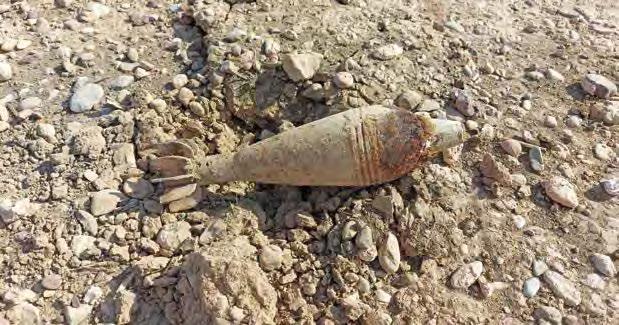
THE JOURNAL OF CONVENTIONAL WEAPONS DESTRUCTION 8
Unexploded ordnance found at an SHO clearance site, Iraq, August 2021. Courtesy of Fondation suisse de déminage.
NATIONAL AUTHORITIES AND REGULATIONS
Despite international agreements and eager NNGOs in the global south, many governments in countries affected by EO have not yet displayed serious commitment to support the localization of HMA or are uncertain how to best do so. For example, in many EO-affected countries there is a notable absence of national funding for local HMA actors— a feature that could have the potential to drive sustainable HMA localization. However, there are also risks involved in national funding for local HMA actors, as some of the most EO-affected countries also find themselves grappling with issues related to financial mismanagement, corruption, and nepotism. With money flowing into national mine action bodies, concerns include the risk of fiscal malpractice and outright fraud due to subpar due diligence measures, and the possibility that skilled staff might be replaced with clients of political patrons.
INTERNATIONAL NGOS
Successful capacity development projects have proven that INGOs can be important allies in NNGOs’ pursuit of greater localization in HMA. However, INGOs, like all organizations, also have a vested interest in selfpreservation and overcoming their competition rather than adding to their ranks. Expecting INGOs to eagerly neglect their organizational imperative for maintaining funding streams would be exceedingly optimistic. Unless donors can find ways to mitigate competition over funding and provide serious incentives for INGOs, reliance on good-will and humanitarian commitments alone will at times face the
NATIONAL NGOS
One of the key challenges for NNGOs is the complexity of international donor requirements. Whereas INGOs often had decades to develop alongside donors’ evolving funding mechanisms and accountability requirements, young NNGOs are confronted with a seemingly impervious web of serpentine regulations. Fulfilling such complex administrative requirements is often beyond the capacity of even more established NNGOs. However, many national HMA organizations may also face challenges with seemingly routine tasks, such as preparing high-quality proposals that meet international donor standards, be it due to language barriers or a lack of experience and knowledge of donor priorities. The latter is, in many instances, a consequence of NNGOs’ limited access to networking opportunities with international donors, which in turn often stems from NNGOs’ lack of visibility, who don’t possess the ability to reach international donors.
In addition, there are also regulatory challenges. The applicable laws for NGOs in many developing countries differ significantly from those in the global north. As a result, NNGOs are often set up in ways that are incompatible with international donor requirements, for example lacking an independent board. Moreover, NMAS stipulations and NMAC procedures can present an impediment for nascent NNGOs, for example when activities such as NTS—a traditional entryway into the mine action sector for NNGOs—require more technical applications, such as the ability to install semi-permanent markings, which usually requires clearance-related accreditations that require significantly more expertise to obtain. In addition, accreditation procedures can often be onerous, expensive, and time-consuming, thereby further raising the bar for NNGOs to enter the HMA sector.
risk of only producing moderate results in HMA capacity development and localization efforts.
In the past, some INGO have proven to be inflexible in their approach to capacity development, requiring NNGO partners to adhere to unnecessary, unhelpful, or even counterproductive standards and practices that do not match the size, scope, or context of their NNGO partner. This is in part a result of an imbalance in the partner selection process, where INGOs often hold all the power, while NNGOs are in many cases merely recipients with little leverage of their own.
When global events shift donor interests, and subsequently funding streams, INGOs might face problems in specific country programs—and opportunities in others—whereas NNGOs in the same situation find themselves confronted with more existential issues. Moreover, NNGOs are exposed to a host of other issues that affect INGOs far less, including ethnic divisions, political pressure, clan dynamics, land conflicts, or customary expectations. For example, in some countries it is common practice that family members in high positions are expected to extend patronage to their relatives, by providing money, contracts, or jobs. INGOs and their international management staff are often not at the same risk of such external influences and expectations.
Lastly, the uncomfortable truth is that there have been instances of NNGOs engaging in financial mismanagement. Such cases often unfairly taint the image of an entire group of organizations and erode trust and the progress that was built upon it.
9 ISSUE 28.1 | WINTER/SPRING 2024
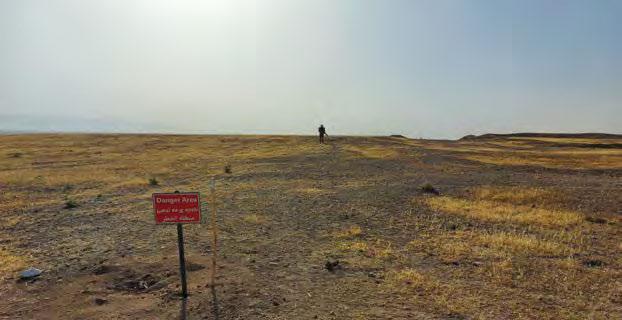
WAYS FORWARD
There is little doubt among practitioners that HMA localization faces a host of challenges, but there are also significant shimmers of hope. NNGOs are increasingly organizing, sharing experiences and best practices, and unifying their voices in demanding greater participation. Moreover, there are various actions that all stakeholders can take to overcome obstacles on the way to meaningful, sustainable localization.
International Donors: As identified previously, one of the key concerns of international donors is NNGO accountability. To ensure that NNGOs are compliant with basic accountability standards and on a sincere path to full compliance with all donor requirements given the right support and training, international donors could vet NNGOs, either directly or through a contracted partner, and create a roster of eligible NNGOs. Those organizations that pass the vetting should be afforded more leniency during their development of accountability standards that meet the full donor requirements.
To help NNGOs in developing their knowledge and ability to comply with complex donor requirements, international donors could fund the embedding of INGO or commercial finance staff within NNGOs, who will support the latter in maturing into organizations that can comply with the required standards in accountability and transparency. This may also include funding for NNGOs to contract finance functions and training therein to specialized service providers.
To ensure sustainability, promising NNGOs should be provided with funding for indirect costs and key HMA assets.11 This should also extend to capacity development partnership grants, where funding for indirect costs should be split evenly
between INGO and NNGO partners. Allowing NNGOs to establish project-independent managerial and support functions is a crucial aspect in making sure that localization will yield long-term results.
To achieve growing national ownership and work towards the goal that local actors are increasingly able to address local issues, NNGOs should be able to count on some funding provided by their national governments, particularly in countries that have the means for it. International donors can buttress this transition, by advocating for national funding, supporting national mine action bodies in anti-corruption efforts, and by providing matching funding to national funding that is accessible solely to NNGOs and linked to strong accountability mechanisms. Such measures would significantly help to ensure the sustainability of localization efforts.
Another key issue to address is the risk that INGOs, a vital partner in the capacity development of NNGOs, feel constrained to act against their own organizational interests, for example by creating competition or sharing their funding streams. Rather than solely relying on goodwill and INGOs’ humanitarian ethos, international donors should appreciate INGOs’ organizational constraints, and work towards developing incentives for INGOs to commit to effective, serious capacity development efforts with clear and reasonable objectives. For example, separate funding streams for national and international HMA actors, respectively, would reduce the perception of competition. The implementation of successful capacity development projects could also be rewarded with preferential status in future proposal evaluations.
SHO clearance team member deploying to hazardous area, Iraq, June 2021. Courtesy of Fondation suisse de déminage.
THE JOURNAL OF CONVENTIONAL WEAPONS DESTRUCTION 10
To reduce the entry barriers for NNGOs, international donors should simplify their proposal formats and, where possible, start to accept NNGO proposals, reports, and general communications in the respective national language. They can also be important allies in working towards a greater balance between national and international organizations in coordination structures, and in putting local voices in the lead. This should also include an increased participation and role of local actors from the global south at high-level events.
Finally, international donors should work with INGOs and NNGOs in developing better ways of measuring success in capacity development and localization efforts. This will require increasing awareness that many aspects of NNGO capacity development are better understood in qualitative rather than quantitative terms—a measure that requires closer interaction with NNGO partners on the ground.
National authorities. National governments and their mine action regulatory bodies have numerous tools to support localization of HMA. By providing funding for NNGOs, working towards improving financial management, and tackling issues such as corruption and nepotism, national mine action bodies can be a key driver of sustainable national ownership. They should also review and adjust their regulatory frameworks to support NNGOs in complying with international standards, and to remove obstacles for nascent local actors that seek to gain a foothold in the HMA sector. Moreover, national governments
CONCLUSION
should fully commit to localization efforts, pledge to support the implementation of relevant international agreements such as the Grand Bargain, and most importantly, listen to local voices, for example by involving all national stakeholders in the development of clear localization action plans.
INGO. With the right incentives, INGOs can be vital partners to NNGOs and a key driver in the localization of HMA. They should transform patron-client relationships with sub-granted NNGOs to mentor-mentee partnerships focused on genuine capacity development. Committed INGOs should also be open to sharing the funding for indirect costs with NNGO partners, and should accept that sustainable capacity development must go beyond operational aspects and manifold trainings— becoming a whole-of-organization approach that involves all departments of both partners.
NNGO. Many NNGOs have come a long way, and some have developed accountability measures, operational expertise, and donor relations that rival those of long-established INGOs. As a sector, however, NNGOs still must overcome negative perceptions and stereotypes. NNGOs have to show that they are serious and open about their efforts in improving accountability, transparency, and compliance with international donor requirements. They should actively work on improving visibility, engage national authorities, international donors and INGOs, and not be hesitant to ask for help and support, for example through capacity development partnerships.
Despite many challenges, mine action has started seeing impactful localization efforts, particularly when earnest INGONNGO capacity development partnerships are subsequently followed by donor trust and sustainable, quality funding, ideally to an increasing degree through national funding streams. When all stakeholders commit to work together and listen to each other more closely, increased participation of local HMA actors will undoubtedly enrich and invigorate the mine action sector.
MARKUS SCHINDLER Program Manager
Fondation suisse de déminage (FSD)

See endnotes page 74

Markus Schindler is currently a Program Manager for Fondation suisse de déminage (FSD) in Ukraine, where he is leading the implementation of a mine action grant. His experience spans a decade working with FSD in various roles spread across multiple countries, including Iraq, Afghanistan, Tajikistan, and the Philippines. Schindler holds a Master’s Degree in Strategic Studies from University College Cork, a Master’s Degree in Social Science and Ethics
Ruhr University Bochum, and a Bachelor’s Degree in Philosophy
FSD and SHO staff at control point, Iraq, August 2021. Courtesy of Fondation suisse de déminage.
11 ISSUE 28.1 | WINTER/SPRING 2024
from
from the University of Regensburg.
The Mine Action Trauma Care Collaborative:
ENHANCING COORDINATION BETWEEN HUMANITARIAN MINE ACTION AND THE EMERGENCY HEALTH RESPONSE TO CIVILIAN CASUALTIES OF EXPLOSIVE ORDNANCE
By Hannah Wild,1 Christelle
Loupforest, 2 Loren Persi, 3 Elke Hottentot, 4 Sebastian Kasack, 5 Firoz Alizada, 6 International Blast Injury Research Network,7 Adam L. Kushner, 8
Barclay T. Stewart, PhD1,9
[ University of Washington,1 UNMAS, 2 Independent Expert, 3 Independent Expert, 4 Mines Advisory Group, 5 Antipersonnel Mine Ban Convention Implementation Suppot Unit, 6 International Blast Injury Research Network,7 Surgeons OverSeas, 8 Harborview Injury Prevention and Research Center 9 ]
1. Department of Surgery, University of Washington, Seattle, WA, USA
2. United Nations Mine Action Service (UNMAS), Geneva, Switzerland
3. Victim Assistance Specialist, Melbourne, Australia
4. Victim Assistance Specialist, Geneva, Switzerland
5. Mines Advisory Group, Manchester, UK
M6. Antipersonnel Mine Ban Convention Implementation Support Unit, Geneva, Switzerland
7. International Blast Injury Research Network (IBRN), University of Southampton, Southampton, UK
8. Surgeons OverSeas, New York, NY, USA
9. Global Injury Control Section, Harborview Injury Prevention and Research Center, Seattle, WA, USA
odern armed conflict is characterized by the use of a wide variety of explosive weapons (EW), creating complex injury patterns with the need for rapid first aid including hemorrhage control close to the point of injury. Yet, in many places where these injuries occur, formal trauma systems are weakened by conflict and resource limitations. In conflict zones, where immediate trauma care is often challenging to access for civilian casualties of EW, the humanitarian mine action (HMA) sector’s unique position and capabilities present a critical opportunity to bridge this gap—a potential that has been realized with the creation of the Mine Action Trauma Care Collaborative (MA-TCC). By fostering collaboration between the mine action sector and health responders, the MA-TCC aims to leverage HMA’s extensive field presence and expertise to enhance trauma care delivery, ensuring a more coordinated, effective response to the urgent medical needs of those injured by EW.
BACKGROUND
Twenty-first century armed conflict is characterized by the use of explosive ordnance (EO), such as landmines and improvised explosive devices (IEDs), as well as groundlaunched and air-dropped EW with wide area effects including cluster munitions and barrel bombs that disproportionately impact civilian populations.1,2,3 In particular, the threat posed by IEDs has grown, accounting for nearly half of the 9,198 casualties recorded by UN programs in 2022 (46 percent from 38 percent in 2021.) 4 The blast mechanisms and penetrating fragmentation effects of such weapons create complex, multidimensional injury patterns with the need for rapid first aid close to the point of injury (e.g., hemorrhage control). 5 Yet, in many places where these injuries occur, formal trauma systems are weakened by conflict and resource limitations. Epidemiologic analyses of civilian casualties of EO estimate a
39 percent case fatality rate, approximately five times higher than that observed in military treatment facilities or civilian trauma centers in high-income countries. 6,7
While responsibility for the provision of medical care to civilian casualties during active conflict lies with parties to the conflict under international humanitarian law, this burden often falls to local and multilateral health authorities, as well as nongovernmental organizations (NGOs). HMA stakeholders have an organized presence in many hard-to-access settings where local health infrastructure is disrupted by conflict and frequently located far from points of injury. Such resources and capabilities include extensive networks in conflict-affected communities through explosive ordnance risk education (EORE) activities; victim assistance efforts; and the medical expertise of demining teams, with each individual trained to
THE JOURNAL OF CONVENTIONAL WEAPONS DESTRUCTION 12
the level of “basic medic” and at least one paramedic per team to treat deminers in case of illness or accidents. HMA personnel may be the best-equipped medical resource in their area of operation. As such, HMA stakeholders have significant potential to strengthen emergency care in settings with fragile health infrastructure. This can be achieved by supporting local capacity-building through training layperson first responders (LFR), strengthening of referral pathways and prehospital notification systems, and reciprocal “refresher” trainings for HMA paramedics in local health care facilities where trauma team resuscitation drills could be conducted to improve casualty care. Further, the HMA sector sets precedent for high-quality information management standards and platforms for systematic data collection in challenging operational environments. This system creates an opportunity to establish minimum standards for data collection in the context of emergency health care which will lead to the development of benchmarks for effective intervention for the most at-risk populations.
Yet to date, potential for collaboration between HMA stakeholders and emergency care capacity-building for civilian EO casualties has not been explored in a structured manner. While there are multi-mandated organizations engaged in land release and EORE, as well as a continuum of victim assistance services, overarching coordination between HMA and local
health systems could be significantly strengthened to enhance the emergency response to civilian EO casualties.
Numerous recent policy frameworks and sector standards provide momentum to improve coordination between HMA and stakeholders in the emergency health response to civilian casualties of EO, including the recently published Joint Operational Framework on Health and Protection, the implementation of the Oslo Action Plan containing provisions on emergency medical services (Action 36), and the recently adopted International Mine Action Standard (IMAS) 13.10 on Victim Assistance in Mine Action. 8,9,10 Within the health sector, aligned priorities are put forward by the World Health Organization (WHO) Emergency, Critical, and Operative care (ECO) resolution recently adopted at this year’s World Health Assembly (ECO Resolution/76.2), as well as the development of the WHO Red Book, a consensus guideline on the coordination of clinical response teams in armed conflict.11,12 These initiatives coincide to present an ideal opportunity to strengthen cross-sector partnership. MA-TCC was created to serve this purpose. The Collaborative is a multidisciplinary initiative with the objective to realize increased HMA contribution to strengthening trauma care by creating pathways for partnership between the HMA sector and the emergency health response in conflict and post-conflict settings.13
PRELIMINARY STUDIES AND PARTNERSHIP-BUILDING
The MA-TCC began as an exploratory dialogue between researchers at the University of Washington (UW) and the United Nations Mine Action Service (UNMAS) to define highvalue opportunities for enhanced engagement between HMA and emergency health response stakeholders. We undertook preliminary studies to: 1) identify evidence-based trauma care interventions that reduce injury-related mortality in lowresource and conflict-affected settings; 2) evaluate barriers and facilitators to implementation; 3) model the cumulative mortality reduction potential of these interventions; and 4) establish an integrated chain of post-blast care from point of injury to definitive treatment at a health facility with explicit opportunities for engagement by mine action stakeholders.
We built upon a 2017 review conducted by Reynolds et al. evaluating the impact of trauma systems components in lowand middle-income countries.14 The results of this review were expanded and restructured to include contemporary literature, as well as an emphasis on pragmatic interventions for civilian casualties of blast injury. The findings were organized by phase of care: lay first response, prehospital care, definitive care rendered at a health facility, and system-wide initiatives (e.g., data collection, program evaluation, and quality improvement). Findings of this review were then supplemented with qualitative
thematic analysis of key informant interviews (KIIs) with HMA experts, providing insight into current organizational priorities, factors contributing to both successful and unsuccessful prior initiatives, and views on opportunities and obstacles to strengthen coordination between HMA and the emergency health response to civilian casualties of EO. These composite findings were then synthesized into key interventions along a continuum of care from the point of injury to definitive care at a health facility in accordance with the WHO Emergency Care System Framework (ECSF). The mortality reduction potential of these interventions was modeled using existing outcomes data across an integrated chain of post-blast care ( Figure 1). Taking into account interactions across each phase of care, it was estimated that a 68 percent mortality reduction potential would be observed if all interventions were fully implemented.
We designated this innovative output the “Chain of Civilian Casualty Care” (CCCC). This integrated set of practices interfaces with the WHO Trauma Pathway and ECSF but focuses specifically on interventions that can be coordinated with existing activities conducted by mine action operators and the broader mine action sector ( Figure 2 ).15,16 This was first presented at a plenary session, “Fulfilling the rights of survivors, from immediate responsive care to an independent,
13 ISSUE 28.1 | WINTER/SPRING 2024
dignified life,” during the 26th International Meeting of Mine Action National Directors and United Nations Advisers in Geneva in June 2023. Opportunities for enhanced coordination between the HMA sector and emergency health response were explored at a side event at the intersessional meetings of the Anti-personnel Mine Ban Convention (APMBC) in June 2023 in Geneva with presentations by key actors including APMBC VA co-chairs, International Committee of the Red Cross (ICRC), and the WHO. These themes were further elaborated in a main panel session, “Prioritising access to health care services,” during the Third Global Conference on Victim Assistance to the Victims of Anti-Personnel Mines and Other Explosive Ordnance in Phnom Penh, Cambodia, in October 2023. The discussions held in these fora have generated significant momentum toward concrete implementation strategies.
NEXT STEPS: LAYPERSON FIRST RESPONDER TRAININGS
Given the demonstrated mortality reduction potential of LFR trainings and clear implementation opportunities, this intervention emerged as a high-priority target for an initial pilot collaboration. LFR trainings have been used to bring emergency care closer to the point of injury in settings with limited resources and incompletely developed prehospital systems.17,18,19,20 Such interventions are closely related to the objectives of Tactical Combat Casualty Care, the US military’s lifesaving first aid training for all non-medical personnel, which contributed to the reduction of preventable prehospital death by nearly 50 percent during the wars in Iraq and Afghanistan. 21,22 The military’s emphasis on rapid hemorrhage control was translated to the civilian context in high-resource settings through initiatives such as the American College of Surgeons (ACS) Committee on Trauma (COT) Stop the Bleed Campaign. 23 One of the most successful examples of LFR trainings in conflict and post-conflict settings occurred in the context of mine action. In the 1990s, investigators from the Tromsø Mine Victim Center trained LFRs in communities affected by landmines in Cambodia and Iraq, reducing mortality from 40 percent to 15 percent over a five-year period. 24,25,26,27
Despite these positive outcomes, LFR trainings have not been widely adopted or scaled in a coordinated and sustainable manner. Numerous LFR trainings have been conducted in non-conflict settings. These trainings have targeted various populations, often emphasizing commercial drivers, and have demonstrated positive outcomes on trainee knowledge and skill. 28,29,30 However, these trainings were conducted as isolated interventions without clear pathways to scale
or integration with larger health and trauma care systems. Significant implementation gaps exist, including inadequate understanding of sociocultural acceptability and strategies for context-specific adaptation; methods for ensuring adequate representation of women and underserved groups; evaluation of facilitators and barriers to sustainable uptake; and implementation toolkits for deployment of LFR trainings to promote dissemination.
We plan to address these issues by conducting a novel joint delivery model partnering mine action operators with trauma care providers to conduct LFR trainings with a training-oftrainers (ToT) approach in communities affected by EO as the first step in the implementation of the CCCC. Burkina Faso has been identified as a pilot context for a mixed-methods evaluation on the deployment of LFR trauma trainings from which initial implementation toolkits will be developed. This project leverages both local and multilateral partnerships with the Mine Action Area of Responsibility, UNMAS, and Mines Advisory Group (MAG), as well as technical advisory input from the WHO and International Federation of the Red Cross and Red Crescent Societies (IFRC) in close collaboration with Burkinabe partners such as the NGO Pull for Progress. Trainings targeting civil servants and community health workers will include the WHO’s Community First Aid Responders and associated conflict package. For community members, a CCCC version of the IFRC’s Community-Based First Aid trainings will be developed with enhanced content for blast injury such as burn first aid and a context-appropriate adaptation of the ACS Stop the Bleed training for hemorrhage control.
Mortality reduction None Phase 1Phase 2Phase 3 Phase 1+2 Phase 1+3 Phase 2+3 All 0.6 0.4 0.2 00 Interventions 18% 16% 21% 37% 43% 40% 68% Interquartile Range Median mortality reduction Legend
Figure 1. Mortality reduction potential of interventions in the Civilian Casualty Care Chain. Phase 1: Layperson First Response; Phase 2: Prehospital Care; Phase 3: Facility-based Care. Courtesy of Benjamin Huynh/Mine Action Trauma Care Collaborative.
THE JOURNAL OF CONVENTIONAL WEAPONS DESTRUCTION 14
CHAIN OF CIVILIAN CASUALTY CARE
Layperson First Responder Training
First aid training for bystanders (e.g., community members, commercial drivers, police)
Layperson Transport Systems
Organized networks of community-led transport via private vehicle, motorcycle, bicycle, donkey
Facility-Based Trauma Training
Advanced trauma care training for physicians, surgeons, health officers, nurses, and hospital personnel
Prehospital Notification
Designated pathways to alert health facilities of incoming casualties via phone or radio
Trauma Team Organization and Activation
Structured trauma teams with predesignated roles and mechanisms for activation to prepare and receive incoming casualties
These practices draw heavily from the work of the Tromsø Mine Victim Center. 31 CCCC LFR training content will be crossreferenced with the ICRC provider-focused Blast Trauma Care training course to ensure consistency. 32 LFR trainings will also be delivered through integration with existing EORE activities in partnership with MAG during this initial pilot.
For subsequent initiatives, depending on the organizational structure of the partnering mine action operator, trainings could also be conducted through coordination with team medics in a manner that does not interfere with primary responsibilities at clearance sites. The specific aims of this pilot project are to:
Conduct baseline needs assessment to define the highestyield target populations among communities affected by EO, assess the cultural acceptability of LFR trauma trainings, and elucidate barriers to inclusion among women and marginalized groups. The design of this pilot will be informed by a baseline needs assessment via KIIs, focal group discussions, and actor mapping to define inclusive recruitment strategies, engaging local and HMA stakeholders to ensure the proposed intervention is feasible and context appropriate.
Assess the impact of LFR trauma training delivered in partnership with mine action operators on the first aid practices of LFRs trained in Burkina Faso and the fidelity of subsequent LFR trainings as delivered by local trainers through a ToT model. We will utilize previously validated instruments in conjunction with structured clinical scenarios to assess the impact of LFR trainings on participant knowledge and skill with standardized pre- and post-course assessments, as well as longitudinal follow-up at six months. Based on
Prehospital Trauma Training
Intermediate trauma care training for medics and prehospital personnel
Data Collection and Quality Improvement
these assessments, as well as evaluation of nontechnical skills, ToT candidates will be recruited and trained to ensure local ownership and sustainability of the intervention. Fidelity of trainings led by local trainers to the original curriculum will be assessed to evaluate ToT efficacy. This project phase will also entail development of open-access LFR trauma training materials with enhanced content on blast injury for use in other contexts.
Develop implementation toolkits for coordination between HMA stakeholders and trauma care providers to deliver LFR trainings in communities affected by EW. Using implementation science principles, we will assess the acceptability, feasibility, penetration, and sustainability of LFR trainings delivered through this model. 33 The output of this process will be a toolkit for implementation guidance on community-based LFR trainings in conflict-affected settings via a joint delivery model by partnering mine action operators with trauma care providers. This will include guidance on precautions taken by first responders to avoid becoming victims of EO themselves. Included in this process will be pathways to ultimately transfer ownership of such programs to national mine action authorities, host governments through their Ministries of Health, and other local stakeholders to ensure sustainability. Implementation strategies will build from existing infrastructure to facilitate uptake, with standardized processes for monitoring and evaluation (M&E) to identify opportunities for system-wide improvement. HMA stakeholders are wellplaced to contribute to robust data collection and M&E given the sector-wide precedent for high-quality standardized data
Figure 2. Visual outline of the Civilian Casualty Care Chain, an integrated continuum from layperson first response to definitive care at a health facility with embedded data collection and quality improvement processes. Courtesy of Mine Action Trauma Care Collaborative.
15 ISSUE 28.1 | WINTER/SPRING 2024
collection through IMAS 5.10 on information management. 34 This presents a unique opportunity to extend these practices to the health sector in complex operational environments and newly implemented trauma care initiatives.
Leveraging local and multilateral partnerships with enhanced cooperation between HMA and trauma care providers, this project has system-wide implications for humanitarian response in settings affected by EO. Next steps to advance this initiative will include: 1) scaling and adaptation of co-delivered LFR trainings in other conflict-affected settings regionally and globally, and 2) improved coordination with local health facilities receiving casualties to collect longitudinal data linking
CONCLUSION
The MA-TCC aims to promote strategic cooperation between HMA and the emergency health response to civilian casualties of EO. This initiative has the potential to be scaled across EO-affected conflict and post-conflict settings globally, thereby improving coordination between the health and protection sectors at a broader level within the global humanitarian system. The CCCC is an overarching structure designed to guide this process by outlining opportunities for enhanced partnership through evidence-based interventions to reduce mortality from trauma in low-resource settings.

the impact of LFR trainings with clinical outcomes of casualties of EO and conflict-related injury more broadly. Policy and advocacy targets can focus on adapting research outputs to evidence-based policy briefs encouraging consideration for the inclusion of collaborative LFR trainings and the CCCC into future commitments such as the next action plan of the States Parties 2025–2029 to be adopted by the Fifth Review Conference to take place in Siem Reap, Cambodia, in 2024. These efforts can also inform amendments of IMAS 13.10 regarding an expanded role of HMA stakeholders to include the delivery of LFR trainings to communities affected by EO.
While the ultimate responsibility for strengthening trauma systems in conflict-affected settings lies with parties to conflict and health authorities, the CCCC highlights concrete ways in which HMA stakeholders can potentiate these efforts. At a time when indiscriminate use of EO and its continued impact disproportionately affect civilians in conflicts globally, developing a coordinated mechanism to improve cooperation between HMA and emergency health responders has the potential to significantly reduce preventable death and impairment among casualties.
See endnotes page 74
The International Blast Injury Research Network (IBRN) is a trans-disciplinary network launched by the University of Southampton after identifying that leading blast research was primarily focused on military rather than civilian situations and perspectives. Addressing this gap, the multidisciplinary IBRN team was founded to improve research within the civilian context and at a holistic level. The IBRN catalyzes dialogue between the fields of Blast Engineering & Injury Modelling; Public Health; Epidemiology; Traumatology and Critical Care; Operational Research; and Clinical Informatics. This network fosters collaboration among a range of stakeholders including academics, clinicians, and humanitarian organizations to facilitate a broad portfolio of multidisciplinary research into the humanitarian consequences of blast injury.
HANNAH WILD
General
Surgery Resident
University of Washington

Hannah Wild is a General Surgery Resident at the University of Washington focused on humanitarian response for civilian casualties in conflict settings. She received her undergraduate degree from Harvard University and MD from Stanford University. Her research focuses on improving humanitarian surgical care for civilian casualties in conflict settings, particularly for victims of explosive weapons (EW). In collaboration with the International Blast Injury Research Network and United Nations Mine Action Service (UNMAS), she leads the Mine Action Trauma Care Collaborative (MA-TCC), an effort to strengthen coordination between the mine action sector and trauma care for casualties of EW.
CHRISTELLE LOUPFOREST
Officer-in-Charge of the UNMAS Office in Geneva United Nations Mine Action Service

Ms. Christelle Loupforest is the Officer-inCharge of the UNMAS Office in Geneva. In her twenty-five years of service with the United Nations, she served in the Department of Peace Operations, the Office for the Coordination of Humanitarian Affairs, the UN/OAS Human Rights Mission in Haiti, and at the World Health Organization (WHO). She holds a Master of Political Science and speaks English, French, and Spanish.
THE JOURNAL OF CONVENTIONAL WEAPONS DESTRUCTION 16
LOREN PERSI
Victim Assistance Specialist
Melbourne, Australia

Loren Persi has been conducting research on victim assistance since 2004. Persi holds a double degree in development studies and Asian societies at the Australian National University and a Master of Political Science (Peace Studies) from the University of Belgrade. He is the impact research team leader at International Campaign to Ban Landmines and previously worked as a research consultant with the Geneva Academy of International Humanitarian Law and Human Rights on global conflict casualty recording, with UNDP in Southeast Europe on regional small arms control, Humanity & Inclusion on victims’ rights and disarmament advocacy, and with Standing Tall Australia on the legislation and implementation of victim assistance.
ELKE HOTTENTOT
Victim Assistance Specialist
Geneva, Switzerland

Elke Hottentot has worked in the field of international development, humanitarian action, and community development for thirty years. Her specialization is in the areas of humanitarian mine action, with a specific focus on victim assistance, as well as disability-inclusion, community rehabilitation, and participatory development. Within these areas, she has held a wide variety of roles, including policy lead, technical adviser, university lecturer, researcher, community health center manager, evaluator, trainer, and co-coordinator of the Mine Action Area of Responsibility of the Global Protection Cluster. She has worked with international, national, and local nongovernmental and grassroots organizations, public and private health facilities, as well as the United Nations in Southeast Asia, Africa, South America, the Caribbean, the Middle East, Canada, and Europe, and is currently based in Geneva, Switzerland.
SEBASTIAN KASACK
Senior Technical Advisor
Mines
Advisory Group

Sebastian Kasack holds a master’s degree in geography and has been involved in mine action since 1996, working for international NGOs, UNMAS, UNICEF, and UNDP. In 2016, he joined Mines Advisory Group (MAG) as a senior technical advisor. On victim assistance, he authored the UNICEF publication: “Assistance to Victims of Landmines and Explosive Remnants of War Guidance on child-focused victim assistance.”
FIROZ ALIZADA
Implementation Support Officer
APMBC Implementation Support Unit, Geneva

Firoz Alizada is an Implementation Support Officer with the Anti-Personnel Mine Ban Convention’s substantive secretariat, the Implementation Support Unit (ISU) in Geneva. His work includes supporting States Parties to the Convention in implementing victim assistance provisions. He has extensive experience working in victim assistance/disability rights and humanitarian disarmament including with the International Campaign to Ban Landmines, UNMAS, Humanity & Inclusion, the International Committee of the Red Cross, and local survivors’ networks in Afghanistan. He holds an executive master’s in development policy and practice from the Graduate Institute of International and Development Studies of Geneva.
ADAM KUSHNER
A.L. Kushner & Associates Surgeons Overseas

Adam L. Kushner, MD, MPH, FACS, has worked as a surgeon, educator, and researcher in dozens of countries. He is President of A.L. Kushner & Associates, a global surgery and global health consulting firm. He was a founder of Surgeons OverSeas and a subject matter expert on human rights, humanitarian assistance, and disaster relief for the US military. He has authored over 150 peer-reviewed papers and edited three books on global surgery. He completed his general surgery residency at the University of Texas Health Science CenterSan Antonio; MD at the Mount Sinai School of Medicine; MPH at Johns Hopkins School of Public Health; and BA in History and International Relations at Cornell University. He currently resides in Anchorage, Alaska, where he spends his summers fishing for salmon.
BARCLAY STEWART, Ph D Trauma and Burn Surgeon University of Washington

Dr. Barclay Stewart, MD, PhD, is a trauma and burn surgeon at the University of Washington. His research foci include global injury prevention/control, developing models of care for the injured feasible in low-resource settings, and benchmarking quality of care using longterm patient-reported outcomes.
17 ISSUE 28.1 | WINTER/SPRING 2024
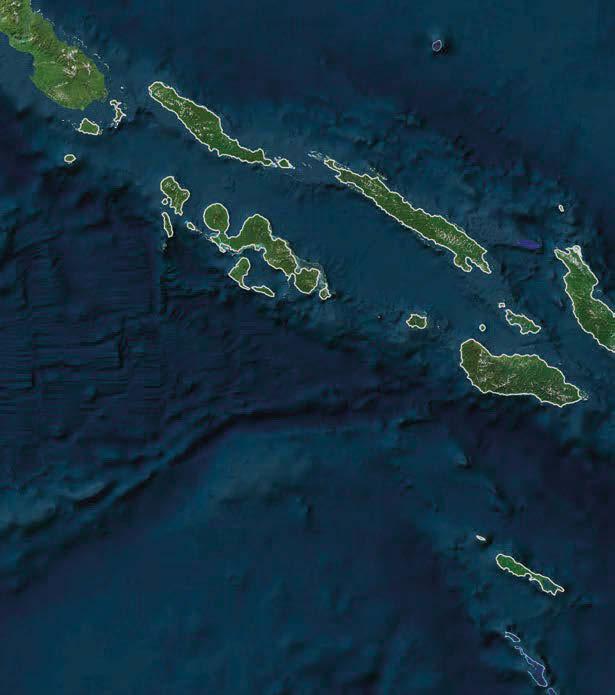
Surveying Eighty-Year-Old Battlefields in
SOLOMON ISLANDS
By Simon Conway [ The HALO Trust ]
Surveying battlefield sites and abandoned ammunition depots eighty years after a conflict presents a challenge. There are few living witnesses, and the land has often changed beyond recognition. In Solomon Islands, the situation is exacerbated by a combination of familiarity and lack of information. Civilians have grown accustomed to the presence of ordnance and concluded that the problem is intractable. At the same time, it is not known how many people have died or been injured because of unexploded ordnance (UXO) and abandoned (AXO) ordnance. Nor is it known where the accidents occurred or what the victims were doing at the time of the accident. This lack of accident data has made it difficult for Solomon Islands to draw attention to the scale of the problem and request help through the assistance clauses of treaties including the Convention on Certain Conventional Weapons and the Anti-Personnel Mine Ban Convention. It makes it nearly impossible to write a national casualty reduction strategy built on solid data.
Solomon Islands is an extended archipelago northeast of Australia and east of Papua New Guinea. It is a strategically important location because whoever controls the airfields and the deep-water ports spread across the nation’s 1,500 kilometer frontage, controls access to the South Pacific, potentially cutting off the United States from its allies in Australia and New Zealand. That is what the Japanese intended when they captured the islands in the aftermath of the attack on Pearl Harbor and it is why the United States and its allies fought so hard to recapture them.
The land battles on Solomon Islands were savage, involving heavy naval, air, and artillery bombardment, and close quarter fighting with mortars and grenades. In addition, storage depots were built to enable combatants to move ammunition closer to the shifting front lines. In many cases, these depots were abandoned or blew up due to the difficulty of keeping them safe and secure. The result has been a legacy of UXO and AXO contamination that exists to this day.
Until recently, the focus of international assistance has been on providing support to the Royal Solomon Islands Police Force (RSIPF). The RSIPF, as the sole organization authorized for the disposal of explosive ordnance (EO) nationally, has a highly effective explosive ordnance disposal (EOD) unit, which has successfully destroyed 48,000 items of EO since recording keeping began in 2011.1 A review of the information for the period 2011 to 2020 by The HALO Trust (HALO) revealed that 80 percent of the EO destroyed was US manufactured, 17 percent Japanese, and the remaining 3 percent British, German, and French. 2
 Doreen Noda’s son Charley, an accountant, died in 2021 at a church fundraising event alongside his friend Rasif Hilly, a mechanical engineer who worked at the airport. An eighty-year-old artillery shell exploded beneath a barbecue pit they were tending. The absence of accident data in Solomon Islands means that it is difficult to gauge the true impact of EO contamination. Courtesy of Simon Conway/The HALO Trust.
Doreen Noda’s son Charley, an accountant, died in 2021 at a church fundraising event alongside his friend Rasif Hilly, a mechanical engineer who worked at the airport. An eighty-year-old artillery shell exploded beneath a barbecue pit they were tending. The absence of accident data in Solomon Islands means that it is difficult to gauge the true impact of EO contamination. Courtesy of Simon Conway/The HALO Trust.
THE JOURNAL OF CONVENTIONAL WEAPONS DESTRUCTION 18
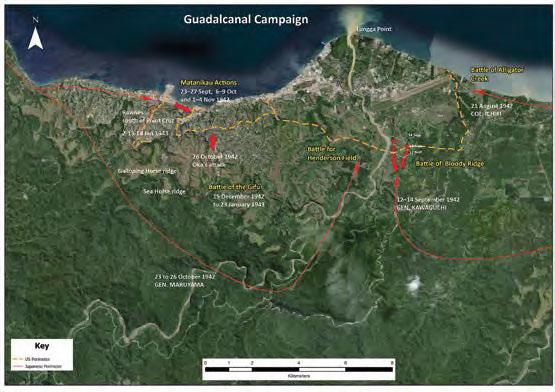
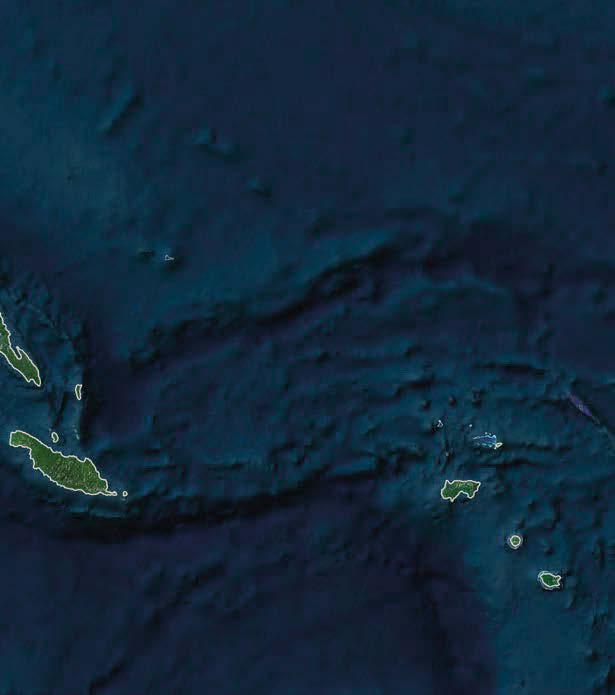
The actions of the EOD unit have undoubtedly saved many lives, but callouts are essentially reactive and rely on the public to continue reporting the discovery of UXO. Reporting tends to peak in the immediate aftermath of a UXO-related fatality but drops again within months. UXO may also be viewed as a financial resource, with people choosing to harvest the explosives and sell them rather than reporting their location to the police (i.e., fishbombers buy and use the explosives to stun and kill fish, destroying the once pristine ecosystem of the reefs). In remote areas, the distance between communities and police stations means that there is a significant, chronic issue of underreporting. The EOD unit does not currently have sufficient staff to conduct technical survey or subsurface clearance.
There is a huge task under the ground waiting to be addressed. One of the few places where sub-surface clearance has happened is the stadium built near the center of the capital, Honiara, for the seventeenth Pacific
Games held in November 2023. A local company staffed by former RSIPF personnel searched the site, which was about 60,000 square meters, and excavated more than 8,000 items up to 4 meters deep, ranging from canon rounds to artillery shells.
HALO was awarded a contract by the Office of Weapons Removal and Abatement in the US State Department’s Bureau of Political/Military Affairs (PM/WRA) to undertake non-technical survey (NTS) of contamination in Solomon Islands. Given the scale and intensity of the bombardment, it would be tempting to draw a series of large circles around the ports and airfields, which are also now the most densely populated areas, and declare everything inside that range a hazardous area. However, HALO is identifying and carefully delineating the boundaries of those distinct areas that are the most contaminated and would yield the most benefit from sub-surface clearance. In doing so, we hope to galvanize international support around a narrative of making the islands a much safer place.
Figure 1 . The fiercest fighting on Guadalcanal Island took place for control of the runway at Henderson field, now the site of the international airport. The map shows the three unsuccessful attempts to break through the US perimeter: the Battle of Alligator Creek, the Battle of Bloody Ridge, and the Battle for Henderson Field. These have been overlaid on a recent satellite photo that shows the density of the current population on the former battlefield sites.
Courtesy of Frank Tabai/The HALO Trust.
19 ISSUE 28.1 | WINTER/SPRING 2024

Courtesy of Frank Tabai/The HALO Trust.
While there may be a paucity of data about the consequences of the fighting—particularly the postconflict impact on civilians—there is plentiful and granular data about the battles themselves. Sources range from US Air Force Theatre Historic Operations Records to the ongoing research conducted by professional and amateur historians, including Dave Holland who runs a Facebook site called Guadalcanal—Walking the Battlefield. Entering the name of the battles in a search engine yields a range of maps that not only show the location of ports and airfields, as well as the movement of military units, but often provide accurate information on the location of trenches, dug outs and bunkers, and even artillery targets.
Local relic hunters make a living from scouring the jungle, selling a range of salvaged items from bayonets to belt buckles, and dog tags to coke bottles. They are valuable sources of information about the location of buried caches of ordnance.
HALO’s approach has been to use battlefield information and the RSIPF clearance records to guide where we initially deploy the five-person survey team. From there, we used a participatory approach, writing to community elders to introduce our work and organizing open meetings at which men and women have been encouraged to share information on the location of “bombs” and to provide contact details. Not long after our arrival in Mbokona, a largely informal settlement known as “the ravine,” a nineyear-old walked up to the HALO survey team and handed over a Japanese Type 91 grenade that was fired from the end of a rifle more than seventy years before he was born. The incident reinforced the need for greater public awareness of the risk. From the beginning of HALO’s operations, we have delivered explosive ordnance risk education (EORE) as a component of those meetings and as a follow-on activity. In December 2023, we started distributing leaflets, posters, and school exercise books
Figure 2 The yellow and blue dots show the location of items of UXO destroyed since 2011 by the Royal Solomon Islands Police Force EOD team in the vicinity of the capital Honiara and the international airport. Each dot may contain multiple items. There is no guarantee that unpopulated areas where there are no dots are free of UXO.
THE JOURNAL OF CONVENTIONAL WEAPONS DESTRUCTION 20
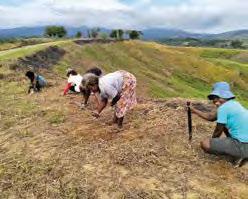
with an EORE message with funding from the German government. All EORE materials include the dos and don’ts stipulated by the police, including “don’t build fires”—such is the density of contamination and the threat it poses.
For survey, HALO decided to save time by dispensing with hand-drawn sketch maps of hazardous areas, instead opting to digitize field data collection and mapping using handheld tablets with Esri ArcGIS Survey123 software and DA2 GNSS receivers with an accuracy of up to 30 centimeters. Being able to collect and assess historical data and map offline has allowed HALO to work unimpeded in areas without mobile data coverage. Using the Trimble receivers—which are easy to set up and use, even in challenging terrain—has significantly sped up survey.
During field activities, four separate reports are completed: Community Assessment, NTS Hazardous Area, EORE, and EOD call-out. Every report undergoes three levels of thorough quality control checks to ensure the data is fit for purpose. The reports are entirely Information Management System for Mine Action (IMSMA) compatible and will be digitally ported into the national database when it is functional in 2024.
When delineating the boundaries of hazardous areas in regions that were the target of industrial-scale bombardment, HALO’s emphasis has been on manageability. We consulted the police and the commercial clearance sector and decided on a maximum size of 60,000 square meters
One of the bloodiest battles on Guadalcanal was for control of the line of three hill tops overlooking the airfield that came to be known as Bloody Ridge. There are plans for the site to become a national peace park. Despite being bombarded from the air, sea, and by ground artillery, and despite repeated assaults involving the use of mortars and grenades, there has never been any sub-surface clearance at the site.
Courtesy of Simon Conway/The HALO Trust.
for each polygon, reflecting the size of land the local commercial clearance companies can clear on average in a two-month period. For the larger battlefield sites, we have created multiple adjoining polygons, each one a distinct task. From June to December 2023, HALO surveyed 206 hazardous areas, covering a combined area of 8,281,979 square meters, averaging just over 40,000 square meters per polygon.
To assist the government with understanding the scope of the problem and to differentiate its impact, we also developed a color-coded system that indicates the current or proposed land use for the hazardous areas. Red areas represent housing and cultivation. Orange areas denote community facilities such as schools, community centers, churches, and the national park area at Bloody Ridge. Yellow areas are earmarked for future development, such as the affordable housing proposed by the National
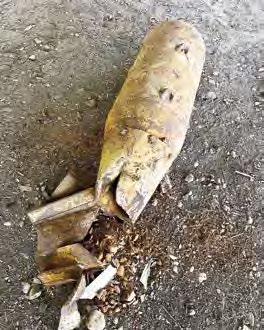
21 ISSUE 28.1 | WINTER/SPRING 2024
A US Navy Mark 29, 650lb depth bomb for use against submarine and land-based targets. According to the Theatre Historic Operations Records, 96 Mark 29s were dropped on a ridgeline in Guadalcanal in 1942. At the time, pilots recorded that six had failed to explode. There may be five others lying unexploded on the ridgeline. Courtesy of Simon Conway/The HALO Trust.
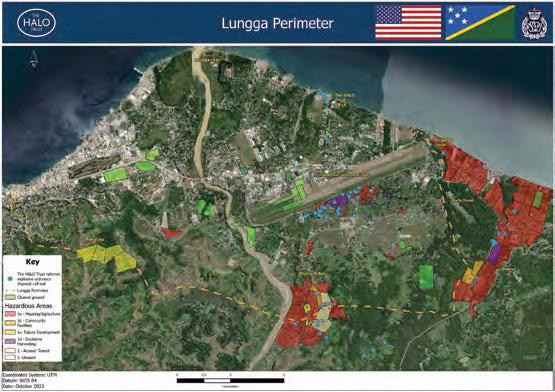

Provident Fund. Areas where explosive harvesting has occurred are marked in purple. Finally, gray areas are not currently in use. Of course, this is just a snapshot as of the date of the survey, but HALO will update the coding as the land use changes.
Inevitably, HALO found items of UXO and AXO during the survey: 731 items between the period of June to D ecember 2023. On Guadalcanal Island, these were reported to the police EOD unit who responded swiftly in every instance. While surveying the battle of Munda Point on New Georgia Islands in the Western Province, HALO was fortunate to have a police EOD officer accompany our team who removed safe-to-move items to a secure location.
Figure 3 HALO’s survey work in the vicinity of Henderson field between June and December 2023, mapping hazardous areas and classifying them by current land use. Green polygons show where clearance has been undertaken by local commercial companies, mostly in aid of infrastructure, the Pacific Games, and the airport. Despite the threat, there has been almost no clearance in support of local populations, under their houses or in their gardens.
Courtesy of Frank Tabai/The HALO Trust.
THE JOURNAL OF CONVENTIONAL WEAPONS DESTRUCTION 22
HALO survey officer Asina Hazekamah using a Trimble DA2 GNSS receiver. The receiver is handportable, durable, and doesn’t require a base station. Courtesy of Simon Conway/The HALO Trust.

out data, showing where
and abandoned ordnance since 2011. It
to be done in just one area of one island in Solomon Islands.
Courtesy of Frank Tabai/The HALO Trust.
The close cooperation with the police and their swift response has undoubtedly given communi ties ren ewed confidence in reporting the presence of EO and is beginning to break down the sense of the problem as an intractable one.
From the outset, HALO sought to apply the principles of good information management, with a strong emphasis on audit and continuous appraisal. We have been working with the Geneva International Centre for Humanitarian Demining (GICHD) and Solomon Islands government to prepare for the monthly digital transfer of good-quality data to the new National IMSMA Core database.
It is important to recognize that the UXO problem in Solomon Islands is never going to be completely solved. Just as in Western Europe, clearance of World War II ordnance will continue for years to come, but it is also important to acknowledge that people in Western Europe are not dying because of building bonfires or having
barbecues. In Solomon Islands, more can be done. The survey is a significant step toward measuring the scale of the problem and identifying the resources required to address it.
See endnotes page 75
SIMON CONWAY
Head of Programme Development
The HALO Trust

Simon Conway starts up new programs for The HALO Trust. He has worked in the mine action sector since 1998.
Figure 4 The HALO survey information has been overlaid with the RSIPF EOD units call
they have responded to the public and destroyed thousands of items of unexploded
gives a sense of the scale of contamination and how much more work is yet
23 ISSUE 28.1 | WINTER/SPRING 2024
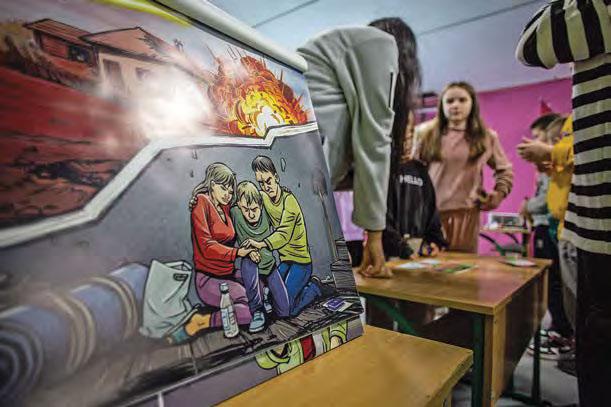
Emergency Explosive Ordnance Risk Education LESSONS LEARNED FROM UKRAINE
By Nick Vovk [ Danish Refugee Council ]
Following the Russian Federation military offensive launched on 24 February 2022, the context and extent of Ukraine’s explosive ordnance (EO) contamination drastically changed, leaving mine action (MA) operators with the need to provide emergency explosive ordnance risk education (EORE). Faced with scarce up-to-date guidance and good practices on the topic, the global EORE Advisory Group (AG)1 produced a refreshed document to support implementation. In September 2023, the Danish Refugee Council (DRC) also surveyed the entire MA community in Ukraine and organized a joint Lessons Learned Workshop to review the past eighteen months of emergency EORE programming. The workshop addressed various aspects of the latter, as prioritized by EORE practitioners: coordination and monitoring, informational materials, provision of EORE for persons-on-the-move and those in hard-to-reach areas, digital EORE, as well as the integration of EORE with the broader humanitarian response. This article is dedicated to summarizing the results and public discussions to inform both the global and Ukrainian EORE community of practice.
INTRODUCTION
After relocating from Donbas to Kyiv on 23 February 2022, my evacuation flight was booked for the next day. In the early hours of 24 February 2022, a Notice to Airmen was circulated as the first shelling hit Boryspil airport.
Despite telltale signs, a war between Ukraine and the Russian Federation in the proportions we know today was unforeseen. In the weeks and months thereafter, millions of Ukrainians became displaced or trapped in besieged
DRC conducting EORE sessions for adolescents in a bomb shelter during air raid alarms in Ivankiv, Kyiv region, Ukraine, 2023. Courtesy of DRC.
THE JOURNAL OF CONVENTIONAL WEAPONS DESTRUCTION 24
cities. The indiscriminate attacks that ensued brought about “a severe disruption of family life and community services that overwhelm[ed] the normal coping capacities of the affected people.ˮ2 From the twelfth floor of a central Kyiv hotel, I watched the emergency unfold before my eyes.
As Russian armed forces advanced through eastern, southern, and northern Ukraine, pitched battles led to the extensive use of EO by both sides. 3 Reports of cluster submunitions, anti-personnel (AP) mines (including the first documented use of seismically-fused POM-3), 4 and other EO surfaced daily. Exposure to shelling, armed violence, and landmine contamination quickly emerged as the top protection risk for civilians. 5 In April 2022, DRC completed a rapid EORE needs assessment across fourteen conflictaffected oblasts. The results revealed that 44 percent of respondents perceived EO contamination in their areas as either dangerous or very dangerous. Almost half (49 percent) had personally encountered EO, mostly identifying long-range munitions such as artillery projectiles, guided missiles, and aircraft bombs. 6 The incredible scale and scope of new EO contamination made it evident that the EORE programming used before February 2022 was no longer fit-for-purpose.
Yet, when EORE practitioners turned to academic publications, guidelines, standards, and reports on emergency EORE delivery for guidance, they were few and far between. Among the community of practice, emergency EORE programming is commonly understood to be the same as the standard EORE provision with certain context-dependent emergency exceptions. The International Mine Action Standards (IMAS) 12.10 give some general directions on the latter.7 Perhaps the most comprehensive resources on the topic are UNICEF’s IMAS Mine Risk Education Best Practice Guidebook 98 and Emergency Mine Risk Education Toolkit;9 however, both were published more than fifteen years ago. The Education in Emergencies sector has likewise been suggested as synergetic with emergency EORE, particularly when it comes to needs assessments, mass media campaigns, and coordination.10 For EORE practitioners in Ukraine, Jones’ and Crowther’s article “Provision of Emergency Risk Education to IDPs and Returnees in Ukraine” in The Journal of Conventional Weapons Destruction also provided contextually relevant findings from the 2014 conflict in eastern Ukraine.11
While thes e resources proved advantageous, there was a growing need for more updated information; in

Representatives of DRC, FSD, and NPA, inter alia, participating in the DRC Lessons Learned Workshop on Emergency EORE in Kyiv, Ukraine, 2023.
Courtesy of DRC.
25 ISSUE 28.1 | WINTER/SPRING 2024
March 2022, that is what DRC proposed to the EORE AG. The EORE AG’s collective efforts culminated in the publication of the Questions & Answers on EORE for Ukraine in a matter of weeks.12 While the existing literature remains a vital, step-by-step guide to emergency EORE programming, this document offers significant updates and good practices from the past decade. These insights could be valuable for the entire MA community, but especially in the context of Ukraine.
Since February 2022, the war in Ukraine has left behind massive casualties and EO contamination, particularly affecting men in southern and eastern parts. From February 2022 to the end of 2023, the United Nations Human Rights Office of the High Commissioner (OHCHR) recorded 29,330 civilian casualties with 10,191 killed and 19,139 injured. While many more incidents await corroboration, 91 percent (or 26,717) resulted from explosive weapons with wide area effect, 1,096 (4 percent) from landmines and explosive remnants of war, and 1,517 (5 percent) from other incidents (i.e., small arms and light weapons).13 Despite ongoing survey, the national mine action authority (NMAA) already recorded 174,000 square kilometers of EO contamination (92 percent on land and 8 percent in water)14 and 2,136 hazardous areas.15 The accounts for the number of various ammunitions found in Ukraine differ—ranging from 176,16 360,17 to 40018 —but all suggest that it is vast. These include AP, anti-vehicle, and sea mines, cluster munitions, thermobaric weapons, and other unexploded and abandoned EO. The wide range and especially the quantity of explosive hazards have particularly “hampered Ukraine’s ability to maintain previous levels of agricultural production”19 as one of the world’s largest exporters of products such as sunflower oil, barley, maize, and wheat. 20 The importance of the agricultural sector for the livelihoods of Ukrainians is also reflected in the casualty statistics.
EO at home)21 in areas that were clearly marked with mine warning signs. According to casualty data, men and boys are most at-risk (87 percent), especially those working in the agricultural and transportation industries (such as farmers and tractor drivers), public sector (i.e., teachers), as well as the unemployed. 22 However, the Knowledge, Attitudes, Behaviors, and Practices (KABP) survey, executed by DRC and Humanity & Inclusion (HI) from August to October 2023 across six oblasts in the north, east, and south of Ukraine, showed that people with disabilities—particularly adult males, young female adults, and elderly males, respectively—display the highest propensity to engage in risk-taking behavior. 23 Thus far, Kharkiv, Donetsk, and Kherson oblasts cumulatively accounted for 68 percent of recorded accidents, 24 but the KABP survey identified the highest percentage of risk-taking behavior in Kyiv oblast.
However, the Knowledge, Attitudes, Behaviors, and Practices (KABP) survey, executed by DRC and Humanity & Inclusion (HI) from August to October 2023 across six oblasts in the north, east, and south of Ukraine, showed that people with disabilities—particularly adult males, young female adults, and elderly males, respectively—display the highest propensity to engage in risktaking behavior.23
Most EO-related accidents happen in the afternoons between spring and early autumn when Ukrainian people work their lands (both commercial and subsistence), spend leisure time and forage in forests or rural areas, or repair roads. Pressured by economic necessity, many accidents transpired as people tried to remove dangerous items without proper safety measures (e.g., storing or dismantling

However, the EORE community in Ukraine has also made significant strides in responding to the emergency. By the end of 2023, the mine action area of responsibility (MA AoR) recorded EORE activities reaching 2,962,664 people25,26 by thirteen EORE-accredited international, national, and commercial MA partners (eight more than before 2022). 27 The State Emergency Services of Ukraine (SESU)—the largest provider of EORE—reported an additional 300 thousand people receiving EORE by the end of September 2023. 28 The Ministry for the Reintegration of Temporary Occupied Territories also supports these efforts, primarily via small media (e.g., distribution of EORE informational materials, etc.). Accounting for 56.4 percent of all MA activities, EORE is currently implemented in twenty-three oblasts of Ukraine, a considerable scale-up since the pre-2022 times of Luhansk and Donetsk. 29 The donor community has likewise substantially increased funding for MA overall: from a combined USD$31.5 million reported between 2015 and 2021 to a total of USD$262 million between 2022 and 2023 alone (a 731 percent increase). 30 However, more is needed as the war continues to affect the lives, limbs, and livelihoods of Ukrainians.
In response to the evolving challenges of delivering emergency EORE activities in Ukraine, DRC organized a Lessons Learned Workshop in September 2023. 31 Its content was collaboratively shaped by the EORE AG and
THE JOURNAL OF CONVENTIONAL WEAPONS DESTRUCTION 26

the EORE working group in Ukraine. In preparation, DRC conducted a survey of key EORE personnel in Ukraine from the nine EORE-accredited MA operators at the time. The workshop not only featured MA operators sharing their specific practices but also fostered a platform for broader discussions. Building on these experiences and mirroring the structure of the workshop, lessons learned in five
major topics are discussed next: 1) EORE coordination and monitoring in emergencies, 2) emergency EORE materials, 3) EORE for persons-on-the-move and those in hard-to-reach areas, 4) digital EORE during emergencies, and 5) integration of EORE with the broader humanitarian response.
EORE COORDINATION AND MONITORING IN EMERGENCIES
Five years ago, Ukraine lacked the national MA structures present today. These include a mine action law, National Mine Action Standards (NMAS), an inter-ministerial NMAA, and several mine action centers (MAC) responsible for information management, quality assurance and control, monitoring, planning, and accrediting MA operators. 32 As before Fe bruary 2022, the MA AoR and its working groups support them in the latter. Furthermore, the MA operators engage in regular coordination with respective oblast authorities and routinely conduct community liaison during field work. During the DRC survey, the MA community evaluated the level of coordination at 3.43 on a scale of five, but only 57 percent believed that these mechanisms also provide information on the emergency context and existing humanitarian capabilities. On the topic of accreditation, while DRC can attest that it
can be arduous, 71 percent of operators did not find it detrimentally affecting their emergency EORE response.
However, all nine MA operators unanimously agreed that there is a gap in the monitoring of non-accredited EORE organizations as well as options to build their capacities. By not ensuring EORE programs are aligned with NMAS and engaging in coordination mechanisms, such organizations face doing more harm than good. On the other hand, these mostly national organizations with deep-rooted local networks could benefit from a simplified and cost-exempt accreditation process coupled with support from established MA operators. Moreover, MACs shared that the NMAS on EORE require some work which affects their monitoring processes, there is a lack of training procedures and documentation, as well as insufficient testing of EORE activities. 33
UNICEF and The HALO Trust presenting examples of emergency EORE materials at the DRC Lessons Learned Workshop on emergency EORE in Kyiv, Ukraine, 2023. Courtesy of DRC.
27 ISSUE 28.1 | WINTER/SPRING 2024
EMERGENCY EORE MATERIALS
As per good practices, all MA operators (100 percent) reviewed and amended emergency EORE materials after February 2022, very often using social and behavior change theory (86 percent). All nine MA operators attested to making their materials gender, age, disability, and diversity inclusive as well as compliant with the Do No Harm principle. The EORE community did not find that process to be expensive, but six out of nine operators claimed it took longer than expected or desired. Adjusting materials should also be a frequently iterated process, as civilians’ informational needs and preferences change over the course of an emergency just as much as the context (e.g., Kakhovka dam destruction in Kherson Oblast). The EORE community tailored emergency EORE materials to a variety of social groups: children, adolescents, adults, students, internally displaced persons (IDPs), farmers, teachers, caregivers, and social workers. As an example, the HALO Trust (HALO) included information on how to request clearance of agricultural land in their materials for farmers 34 while UNICEF increased their practicality by providing a planting calendar. Many EORE materials

integrated QR codes that link the people of concern with more MA information or other humanitarian services (e.g., victim assistance or legal and economic recovery aid). Large quantities of materials were needed in the Ukrainian emergency, and they were best disseminated en masse via the logistics cluster or various humanitarian convoys, especially for hard-to-reach areas.
Among the challenges related to EORE materials, operators reported diminished production capacities of printing companies due to frequent power outages and destroyed paper stocks caused by ongoing shelling. In the first months of the war, field testing was nearly impossible due to safety concerns, resulting in the use of social media surveying as an alternative to allow for rapid, albeit superficial, testing. 35 Existing literature supports practices of ‘mini’ field testing in emergency settings. 36 However, distributing such large quantities of printed materials may also have negative environmental consequences which further substantiates the general need for more collaboration between MA operators and environmental partners. 37
EORE FOR PERSONS-ON-THE-MOVE AND THOSE IN HARD-TO-REACH AREAS
By the end of 2023, 5.9 million Ukrainians continue to seek refuge in European countries 38 and 3.5 million remain IDPs. 39 Displacement flows over a large territory and constant pendular movements between European Union states have been recognized as challenging for 57 percent of the EORE community. One respondent noted the slow population return to areas where the Government of Ukraine regained control, stating, it is “difficult to find and gather people for EORE sessions, especially in Mykolaiv.” Several operators (43 percent) engaged in EORE at refugee and IDP transit points (e.g., collections centers and border crossing points), both inside and outside of Ukraine (29 percent). DRC, for one, launched EORE programs in Poland and Moldova 40 and disseminated small media to Ukrainian refugees in Greece, Italy, and Denmark. Five out of nine MA operators reported evaluating their EORE methodologies and materials for conflict sensitivity and noted that all have been well-received by people on-themove.
The EORE community in Ukraine has found it difficult to operate in areas where the Government of Ukraine regained control (71 percent), not least due to the ban on all MA activities within 20 kilometers of the frontline.41 Therefore, reaching those most at-risk has been assessed as insufficient (57 percent), but the speed of the response as satisfactory (71 percent). SESU, HI, and UNICEF described their experience with mobile EORE teams as a solution to access issues. Targeting those most in need has a higher impact, although it will come at a cost of time, funding, reach, and staff safety. As per IMAS 12.10, “EORE during conflict must bear the security of the EORE teams in mind.”42 Operating in hostile environments has indeed pushed the EORE community in Ukraine to bolster its safety mechanisms, with additional security and medical trainings, ex-ante community desk assessment, deploying after survey, personal protective equipment, trauma firstaid kits, etc. Access to regular psychosocial support is also highly encouraged.43
By the end of 2023, 5.9 million Ukrainians continue to seek refuge in European countries38 and 3.5 million remain IDPs.39
THE JOURNAL OF CONVENTIONAL WEAPONS DESTRUCTION 28

DRC conducting EORE pre- and post-testing of adults at a hospital, Mykolaiv city, Mykolaiv region, Ukraine. Courtesy of DRC.
DIGITAL EORE DURING EMERGENCIES
In the first month of the military offensive alone, digital EORE already reached 3.6 million Ukrainians, 44 proving itself a formidable tool for emergencies. Note that the Ukrainian context is specific—with reliable internet connectivity, marketing quality, ubiquity of Web 2.0 technologies, and high digital literacy favoring these types of EORE modalities. In Ukraine, Youtube, Facebook, Instagram, and TikTok have been the most popular digital channels. For safety messaging, however, the Ukrainian public has heavily relied on Telegram and Viber. The most oft-used device for receiving information was a smartphone. The EORE community in Ukraine deployed several digital EORE initiatives: radio, EORE-dedicated webpages, social media and television messages, mobile applications, chatbots, online courses, augmented reality, and more. Digital EORE initiatives in Ukraine varied in length, ranging from up to five minutes to one hour long (see Figure 1). A large majority of practitioners have tailored messages and content to different medias, as attested to in the DRC survey: “creating radio ads and presenting on the local news has required us to give EORE messaging without any visual aids (…) and on television we focused our messaging on people going on holiday, as it was June at the time of year.”
There are negative aspects of using digital EORE in Ukraine as well—such as vulnerability to external hacking, hate speech, or spreading (often propagandist) misinformation. All those engaged in digital EORE should hence ensure that data privacy and other digital safety mechanisms are adequately in place since failure to do so can put both people of concern and organizations at substantial risk. Furthermore, the joint DRC and HI KABP survey showed that, in fact, “a significant proportion of survey participants express a preference for in-person communication from an expert.”45 This signals the increasing need for more critical engagement with digital EORE in the face of its growing application. To date, standards and research publications on digital EORE— especially in emergencies—remain nascent46 (e.g., references to digital EORE continue to be missing even from IMAS 12.10). That is why the EORE community in Ukraine also encountered other well-known challenges: measuring impact and behavior change, 47 double counting and inflated reporting, coordination, etc.
29 ISSUE 28.1 | WINTER/SPRING 2024
Has your organization discussed digital EORE initiatives with local authorities or other local experts?

What was the general duration of your digital EORE initiatives?
More than 1 hr up to 1 hour up to 30 min up to 15 min up to 5 min
INTEGRATION OF EORE WITH THE BROADER HUMANITARIAN RESPONSE
In Ukraine, MA operators sought integrations of EORE with both governmental and nongovernmental responses, as well as between and within humanitarian and development programs. On a scale of one to five, MA operators rated the support to government stakeholders (e.g., regional and local authorities) at 3.86. Since “[t]he primary responsibility for mine action lies with the Government of an affected state,”48 more efforts should be invested in supporting Ukrainian authorities so that they may assume the full responsibility for EORE.49 However, no emergency EORE guidance to date describes these capacity-building efforts in-depth. Currently, the community depends on adapting strategies used in post-conflict settings.50 On the other hand, integrating EORE with other nongovernmental organizations (NGOs) has been a good practice for strengthening the safety of aid workers, generally, and increasing the reach of EORE, specifically. In Ukraine, MA operators rated the support to other humanitarian
CONCLUSION
In summary, the following lessons learned arise from emergency EORE in Ukraine over a period of eighteen months (February 2022 to September 2023), as collected by the MA operators at the DRC Lessons Learned Workshop on emergency EORE:
• Globally, emergency EORE remains under-explored, with often outdated guidance. It is commonly understood that in such situations standard EORE
organizations at 4.0 on a scale of five. It is noteworthy that the demand for EORE for humanitarian workers has been overwhelming and continuous in Ukraine—the MA AoR helped produce and widely disseminate options for NGOspecific EORE sessions.51
Finally, seven out of nine MA operators had integrated EORE with multi-sectoral emergency and developmental responses and sought useful information from them. One good practice amidst an ongoing war was to integrate EORE with conflict preparedness and prevention (CPP) messaging, as was done by DRC, Norwegian People’s Aid, HI, and HALO. 52 At DRC, EORE informational leaflets were also distributed in all non-food packages, as well as by the protection and legal assistance teams. EORE sessions were additionally provided to construction workers of DRC shelter and settlements programs and people of concern who received economic recovery aid, especially when part of the agricultural economy.
programming with context-specific adjustments should be practiced. However, more critical and current publications, as well as training on emergency EORE should be promoted by the entire community of practice;
• Emergency coordination mechanisms not only play a critical role in coordination; they should also regularly compile and share information on the emergency
57% Yes 43% N o
Figure 1. DRC survey of MA operators in Ukraine on the topics of contextualization and duration of digital EORE. Courtesy of DRC.
0% 20% 40%60%80%
THE JOURNAL OF CONVENTIONAL WEAPONS DESTRUCTION 30
context and existing EORE and other humanitarian capabilities;
• As the need for EORE increases, non-accredited EORE organizations will emerge. In Ukraine, MACs need to ensure a simplified and cost-exempt accreditation process for them as well as conduct regular monitoring. MA operators should support the capacity building of local EORE organizations;
• The process of revising EORE materials in times of emergencies will be lengthy and needs to be frequently reiterated to ensure a people-centered, context-specific design; however, field testing will be limited due to safety issues. Online ‘mini’ field-testing modalities may be employed to bridge this gap;
• Large quantities of EORE materials will be needed in emergency situations but the private sector may not be capable of producing them. In such circumstances, producing materials in neighboring countries could be a viable option. The environmental impact of this modality at such a scale, however, merits consideration;
• International displacement and pendular demographic movements may necessitate regional EORE responses to adequately inform and educate individuals before they return to EO contaminated countries;
• Operating in newly accessible areas will be challenging, resulting in obstructed access to those most at-risk. Targeting the latter has a higher impact, but it will come at a cost of time, funding, reach, and staff safety. Strengthening safety mechanisms for EORE staff in emergencies is highly recommended;
• Digital EORE has proven to be an effective tool in emergency EORE response due to its safety, costeffectiveness, and reach potential. It is, however, open to external hacking, hate speech, or spreading misinformation. Data privacy, inter alia, is therefore a key consideration to ensure the principle of Do No Harm. Moreover, there are unaddressed challenges when it comes to digital EORE due to generally underdeveloped frameworks;
• There will be a high and continuous demand for the provision of EORE to other humanitarian workers, from the start of emergencies onward. It is prudent to develop NGO-specific EORE sessions to best cater to this need in advance and widely disseminate these options among the engaged humanitarian sector;
• Integrating CPP messaging (as well as non-MA humanitarian aid options) with EORE will prove advantageous, especially during the ongoing armed conflicts;
• In Ukraine, more EORE capacity-building efforts ought to be invested in supporting Ukrainian authorities in assuming their primary MA duties. This, in turn, may also lead to a greater integration of EORE in both humanitarian and development activities (e.g., formalization within the educational system). Globally, the EORE community of practice necessitates more precise guidance on and good practices of EORE capacity building of national stakeholders in emergency contexts.

Disclaimer : This article and workshop were possible thanks to the financial support of the Ministry for Foreign Affairs of the Netherlands. The contents of this document are the responsibility of the author. The views expressed in this document should in no way be regarded as the official position of the Ministry for Foreign Affairs of the Netherlands or DRC. The Ministry for Foreign Affairs of the Netherlands and DRC are not responsible for any use that may be made of the information contained in this document.
See endnotes page 75
NICK VOVK
Former Humanitarian Disarmament Program Manager, Ukraine Danish Refugee Council (DRC)

Nick Vovk worked for DRC in Ukraine from 2019 to 2023. During this time, he was responsible for grants management and fundraising, integrated humanitarian mine action and development projects, as well as explosive ordnance risk education (EORE) and victim assistance (VA) portfolios across Ukraine. He has also technically managed DRC’s EORE programs in Poland and Moldova. He served as DRC’s standing member in the EORE AG and was the Ukraine VA working group founder and coordinator. Prior, he was supporting research projects at the Slovenian Research Agency and was the assistant director of an academic think-tank in Slovenia. He also worked for the United Nations Development Programme in Kosovo. He holds a Master of Philosophy in development studies from the University of Cambridge (United Kingdom) and two Bachelor of Arts degrees in cultural anthropology and philosophy from the University of Ljubljana in Slovenia. He is qualified in explosive ordnance disposal IMAS level 3, non-technical survey, and EORE.
31 ISSUE 28.1 | WINTER/SPRING 2024

Inclusive Data Management: REPORTING, STORING, AND SHARING OF INFORMATION ON BENEFICIARIES IN THE MINE ACTION SECTOR
By Maysa Hajjaj, PhD [ Geneva International Centre for Humanitarian Demining ], Lauren Burrows, Teia Rogers [ JRNY Consulting ], Natalia Lozano, PhD, Sarah Kamal Elias, and Samban Seng
The mine action sector has witnessed transformative changes in data management practices, underpinned by international legal instruments such as the Anti-Personnel Mine Ban Convention (APMBC),1 the Convention on Cluster Munitions (CCM), 2 and Protocols II and V of the Convention on Certain Conventional Weapons (CCW). 3 Despite advancements, transitioning from operational to people-centric data practices has presented challenges, especially about gender, diversity, inclusion, and protection. This study explored current data management methodologies, emphasizing sensitive data and its interplay with gender and diverse social identities. Grounded in case studies from Cambodia, Colombia, and Iraq, the research uncovered the state of data management in the sector and identified pathways for improvement. Key findings highlight variances in interpretations of gender and diversity, challenges in data collection due to security concerns and cultural complexities, the influential role of power dynamics in setting data standards, and the importance of ethical considerations in data sharing and use. This study accentuates the need for a contextually nuanced approach, informed by gender, diversity, inclusion, and protection perspectives, to advance toward more inclusive data management in the mine action sector.
INTRODUCTION
The global mine action sector has witnessed significant advances in data management practices, which have underscored the crucial role of data management in supporting the core five pillars of the sector.4 However, the evolution of data management from operationallyoriented practices to a more people-centric approach has introduced new complexities and challenges, particularly in the areas of gender, diversity, inclusion, and protection.
The Lausanne Action Plan of 2021–2026, 5 guiding the CCM, emphasized inclusive approaches. Action 4 urges states to account for the diverse needs and perspectives of all genders and ages and to promote gender-balanced participation in national activities and the CCM’s procedures. Similarly, the Oslo Action Plan (2020–2024) 6 for the APMBC, in Action 3, underlines the importance of considering the needs and perspectives of all genders in both mine action programs and APMBC activities, aiming for a comprehensive approach. Similarly, International Mine Action Standards (IMAS), such as IMAS 7.40 on
Monitoring of Mine Action Organisations,7 emphasizes that the success of a mine action program is dependent on its ability to reflect on the different needs of gender and diversity groups, thus recommending collection, analysis, and reporting of data relating to gender and diversity aspects including the use of sex and age disaggregated data (SADD) in monitoring systems which must be integrated into the information management system. 8 Dedicated guidelines, such as the United Nations Mine Action Service’s Gender Guidelines for Mine Action Programmes also exist to support transitioning principles and theory into dedicated action for more inclusive data management.
Despite recognizing its importance across global conventions and standards, consistent collection and effective use of this data remains an issue. One significant issue is the inconsistent collection and use of disaggregated data, a crucial element for tailoring effective interventions. Additionally, the current lack of guidance on
THE JOURNAL OF CONVENTIONAL WEAPONS DESTRUCTION 32
data protection, particularly in countries where such laws are absent, poses a considerable challenge to the “Do No Harm”9 principle, highlighting a need for enhanced security and privacy measures.
Addressing these gaps, this research investigated the current data management practices, focusing on peoplecentered data and how gender and social identities factor into these practices. It provides a comprehensive view of the state of data management in the mine action sector and reveals potential areas for improvement, contributing
RESEARCH QUESTIONS
The main research questions of this study were:

significantly to this critical yet under-explored area of study.
The research involved case studies in Cambodia, Colombia, and Iraq, each presenting unique cultural, socioeconomic, and political dynamics that influence mine action data management practices. The insights derived from these case studies aim to inform more effective, globally relevant mine action data practices, underlining the necessity of context-specific approaches.
1. What is the mine action sector’s current data collection, storing, sharing, and reporting approach? How does the sector consider intersecting gender and social identities and power dynamics?
2. How are mine action organizations applying the Do No Harm principle in their data collection, storing, sharing, and reporting processes? What challenges can be identified, and why do they subsist?
The study also recommended more inclusive data management practices across the mine action sector.
Key research variables included data collection, reporting, storing, and sharing, all explored through
gender, diversity, inclusion, and protection. The research underscored the significance of adopting a feminist lens and participation to enhance data management transparency, accountability, and ethical considerations.
DATA COLLECTION AND METHODOLOGY
This research utilized a feminist and rights-based approach, considering power dynamics, promoting active participation, adopting a social justice lens, and ensuring cultural responsiveness. Co-design with researchers from across case study countries and engagement with stakeholders and mine action groups were integral to the approach, making the findings accessible, relevant, and actionable.
Data was collected through a comprehensive desk review using computer-aided analysis, semi-structured key informant interviews, and peer-learning sessions across Iraq, Cambodia, and Colombia. The key informant interviews sometimes expanded to group interviews where multiple staff members from the same organization participated. Peer learning sessions were vital for validating findings, knowledge exchange, and co-creating data management improvement strategies.
Four stakeholder groups were consulted: national authorities, national and international mine action actors,
and external experts on gender, diversity, and inclusion. In total, thirty-five interviews were conducted. The sample was chosen using resources like the Landmine and Cluster Munition Monitor 10 and a snowballing technique to ensure diverse perspectives. The diversity and experiences of the representatives were also considered.
The guiding quality framework was the United Nations Evaluation Group Norms and Standards for Evaluation. Quality control involved a collaborative research design, pilot testing of tools, establishing feedback channels, and conducting quality assurance checks during the interviews.
Limitations included a limited diversity of documents for review, English as the primary language, and limited beneficiary involvement. Mitigation strategies included seeking diverse input at local levels, leveraging public data, clearly presenting complex concepts, and recommending consultation with beneficiaries.
33 ISSUE 28.1 | WINTER/SPRING 2024
DATA COLLECTION
Desk review key informant interviews peer-learning sessions
STAKEHOLDER & SAMPLING
Interviews conducted across national and international organizations and mine action experts
GENDER REPRESENTATION
Interviews conducted with people who identify as men and women across countries
FEMINIST & RIGHTS-BASED APPROACH
QUALITY CONTROL
UNEG norms and standards collaborative design pilot testing
POWER & POSITIONALITY
Acknowledging the importance of reflecting on researchers’ placement and power dynamics. It involves understanding complex power and gender relations and the intersectionality of race/ethnicity, socioeconomic status, and past history.
In this research, positionality of the Western-based researchers was critically examined, acknowledging influence in data collection, analysis, and interpretation, and attempted to mitigate bias through participatory reflection and national researcher conducted data collection.
ACTIVE PARTICIPATION
Promoting inclusivity and participation by co-designing and co-managing evaluations with a broad range of stakeholders, building trust, and understanding and promoting sustained ownership.
Active participation was embedded in this research through participatory data collection design with national researchers in Iraq, Cambodia, and Colombia, using Miro, in addition to inviting in-country Mine Action groups to comment on research design and actively participate in peer-learning sessions.
UTILIZATION-FOCUS
Encouraging targeted and robust data collection, making research findings accessible, and promoting engagement across a range of audiences.
The usability of learning and recommendations was prioritized in this research, evidenced through peerlearning sessions that invited mine action actors to reflect on findings and co-create recommendations.
Focusing on what needs to change moving forward ensured the findings were relevant, actionable, and efficiently utilized by various stakeholders.
SOCIAL INJUSTICE
Recognizing that research and evaluation can be a form of activism and should identify and address systemic inequities contributing to the marginalization and oppression of vulnerable communities.
This research adopted a social justice lens, focusing on issues of inequity in the context of gender and diversity in mine action, aiming to bring these issues to the forefront and contribute to meaningful discussions and actions towards social justice in these contexts.
REFLEXIVITY
Regular reflection on one’s assumptions, biases, and positioning to promote self-awareness, critical thinking, and learning. Reflexivity was integral to the approach.
Mine action actors were invited to reflect during the peer-learning sessions, providing an opportunity for critical reflection on the research findings and their implications. This engagement facilitated learning and enhanced the validity of the research outcomes.
CULTURALLY RESPONSIVE & INCLUSIVE
Prioritizing lived experiences, especially those from communities and populations of color, and recognizing the importance of socio-political, demographic, and cultural contexts.
Data collection tools were tailored to the cultural and socio-political contexts of Iraq, Cambodia, and Colombia.
Ç
THE JOURNAL OF CONVENTIONAL WEAPONS DESTRUCTION 34
Figure 1. Research methodology and guiding principles. All figures courtesy of the GICHD.

KEY RESEARCH FINDINGS
Across the research, the following key findings emerged:
• Interpretations of gender vary considerably across organizations within countries and internationally. A prevalent trend equates gender solely with women, thus bypassing its broader scope. Diversity tends to be anchored more in ethnicity than a wider spectrum of identities such as age, disability, and religion.
• Data about beneficiary names, age, and gender is consistently gathered across case study countries (Colombia, Cambodia, and Iraq). However, data on religion and ethnicity is often omitted, presenting potential gaps in understanding diverse needs. These omissions may arise from concerns about possible misuse of sensitive data. Roles in data collection are adjusted according to contexts, exhibiting a degree of sensitivity to local nuances. However, selection criteria for community interviewees do not demonstrate consideration for how to reach diverse or marginalized groups, posing potential challenges for inclusive data collection.
• Colombia and Iraq face significant obstacles in data collection due to security concerns, potential stigmatization, and fears of data misuse. Across all three countries, cultural nuances and entrenched gender roles introduce complexities. Additionally, fluid security concerns and population displacements, especially in Colombia and Iraq, necessitate regular reassessments.
• International and national standards shape data collection in the mine action sector. However, setting these standards is primarily influenced by people with power and financial weight, often sidelining the communities they impact.
• Organizations adopt varied data storage methodologies, from digital databases to paper forms. The commitment to safeguarding personal information is universal, but mechanisms like tablets are not universally used. Storing sensitive data under single-person custody presents potential risks, and confidentiality practices differ in accordance with local laws and cultural privacy norms.
• Data sharing is selective. National authorities shape data-sharing parameters, and organizations must comply for operational continuity within countries. Though there are stringent approval layers for data sharing, beneficiaries are seldom treated as primary rights-holders in decisions, pointing to ethical concerns.
• Collected data finds use in diverse ways . For example, in Cambodia, gender and disability data primarily influence intervention strategies, while in Colombia, it has the potential to recalibrate government awareness about population vulnerabilities. However, there is a degree of vagueness regarding how the information about specific beneficiary demographics (such as gender, age, and ethnicity) directly impacts the planning and execution of mine clearance activities. Furthermore, the research identified a potential gap in beneficiary engagement post-data collection. While data is continually collected and analyzed, beneficiaries’ insights and feedback need to be incorporated into interpreting the data to avoid reinforcing assumptions and biases. When data is used in different ways outside of its original intention, organizations have an ethical

35 ISSUE 28.1 | WINTER/SPRING 2024

UNDERSTANDING GENDER, DIVERSITY, AND DO NO HARM
The investigation into the definitions of gender and diversity within the mine action sector offers essential insights into prevailing organizational interpretations and their implications on data management.
Across various regions and organizations, the concept of gender merges as multifaceted and often influenced by local cultural nuances. While some view gender as a social construct, others adhere more closely to traditional norms and roles. This range of interpretations is further complicated when sex (biological attributes) and gender (identity and societal roles) are used interchangeably. Such overlaps complicate the accuracy of data interpretation and risk oversimplifying individual identities and experiences.
Internationally, bodies like the United Nations and the IMAS advocate for a clear distinction between gender and sex, especially when collating data. Yet, despite such guidelines, these terms are recurrently blended in practice. This conflation potentially misrepresents the lived experiences of individuals. However, it is essential to appreciate that in some contexts, dictated by societal norms and cultural sensitivities, direct inquiries into gender might be deemed inappropriate. This underlines the importance of creating region-specific data collection methodologies and recognizing the intricacies of local perspectives.
The research also indicated that gender is sometimes equated with women. This interpretation overlooks the rich spectrum of gender identities, including non-binary, transgender, and gender non-conforming individuals. Even in regions where the dialogue on gender is progressive, consistent acknowledgement of this spectrum is not always evident. Similarly, when considering diversity, the emphasis often tilts toward ethnicity, sometimes
fluidity of gender identities, as highlighted by sociologist Dr Raewyn Connell,11 is essential for organizations operating in diverse contexts, necessitating constant adaptation to ever-changing realities. Feminist scholar Dr. Chandra Talpade Mohanty12 also cautions against adopting Western-centric interpretations of gender in non-Western contexts, underscoring the importance of respecting unique cultural constructs and understandings of gender. While it is beyond the scope of this research, the study suggests future consideration of beneficiary-led definitions, reflecting on where mine action takes place and whose interpretations take precedence.
The Do No Harm principle, stemming from medical ethics, holds significant weight in humanitarian activities, including mine action. It mandates that every part of data management, from collection to dissemination, should not inflict harm on individuals or communities. While universally acknowledged in principle, its application within the mine action sector varies across countries and organizations. The IMAS mention it, primarily in the context of data privacy, but more explicit representation is limited to specific technical notes. In all mine action contexts, there is a pronounced emphasis on physical safety, particularly in mine clearance. However, there is room to address data collection’s more nuanced psychological and emotional aspects. Understanding the potential trauma or mental health implications of revisiting certain experiences is crucial, emphasizing the importance of a sensitive approach to ensure the emotional well-being of participants.
In Iraq, the landscape is diverse, with some organizations prioritizing data anonymity and others underscoring participant consent. Colombia stands out with a focus

THE JOURNAL OF CONVENTIONAL WEAPONS DESTRUCTION 36

• Advance consent process: Establish a clear and comprehensive consent process with multiple options for beneficiaries.
• Share with beneficiaries & enhance transparency: Enhance transparency in data-sharing practices and inform beneficiaries of changes.
• Implement a trauma-informed approach: Train data collectors in trauma-informed care, redesign tools, and assess their effectiveness.
• Prioritize diversity: Treat diversity as crucial as gender, adapting tools as needed.
• Expand gender categories: Include non-binary and transgender individuals where relevant, with updated tools and sensitivity training.
• Recenter beneficiaries as key stakeholders: Reframe beneficiaries as ‘rights-holders’, encourage feedback, and involve them in decision-making.
• Start with a conscious & critical approach to data usage: Approach data strategically, ensuring clear communication with beneficiaries and regular updates.
WHAT DATA IS COLLECTED?
Core demographic data collected by mine action organizations include age, gender, and location, and are collected consistently across mine action activities. This data forms the foundation for understanding and assessing the needs of beneficiaries and monitoring representation.
For explosive ordnance risk education (EORE), the number of beneficiaries, their age, gender, and in some cases, location and name are recorded. This aids in understanding the differences in mine risk awareness and comprehension among different age groups, informing targeted interventions. However, collecting names necessitates some ethical questions about why this is needed. For victim assistance activities, data extends to beneficiaries’ familial status, economic situation, and life before and after injury. This provides a greater picture of the survivor’s life and helps in supporting effective assistance provision. In certain contexts like Cambodia, specific information is collected about the cause of disability, the status of the individual, and detailed information about the incident that resulted in the disability.
Despite the importance of inclusivity, current data collection practices often do not accommodate non-binary
• Enhance beneficiary engagement: Involve beneficiaries in data interpretation, use inclusive methods, hold feedback sessions, and train staff in participatory engagement.
• Improve data utilization: Use demographic data for better mine action planning and cross-departmental collaboration.
• Provide data analysis training: Focusing on gender, disability, and demographics.
• Implement “Do No Harm” approach: Create a checklist to ensure data processes prioritize beneficiaries’ safety and well-being.
• Adopt a conflict-sensitive data strategy: Regularly analyzing the context to avoid harm.
• Incorporate intersectionality: Consider intersectionality in all project stages to better serve diverse communities with multiple social identities.
• Design flexible frameworks: Design standardized frameworks with flexibility for diverse experiences and participant agency.
and transgender individuals. While some guidelines, for example, the United Nations Gender Guidelines for Mine Action Programmes,13 also suggest that data on ethnicity or religion could be useful, it is typically not collected. There is a need for an increased understanding of why collecting information on a person’s ethnicity or religion is necessary or how it could be used in supporting mine action activities. Only essential data, such as the number of participants, is recorded in sensitive security zones for safety reasons.

Organizations usually report to the National Mine Action Authority regardless of context. Sometimes this extends to standardized reporting requirements, for example in the case of Colombia, providing information via standardized forms that heavily influence the data collected.
The data types collected in mine action activities vary and largely depend on each activity’s specific requirements and the overarching security context. There are, however, areas for improvement, particularly in collecting data beyond the gender binary and on other diversity factors such as ethnicity and religion.
Figure 2. Inclusive data management model.
37 ISSUE 28.1 | WINTER/SPRING 2024
WHO COLLECTS THE DATA?
Data collection in mine action operations is typically carried out by dedicated teams or individuals explicitly trained for this task. The selection of these data collectors largely depends on the following:
• Security considerations: The safety of data collectors and respondents is paramount. Individuals familiar with the terrain and cultural context are often chosen in areas with high-security risks.
• Local cultural norms: Understanding and respecting local customs and norms is vital for effective data collection. This often determines the gender composition of the teams, as demonstrated in Iraq, where men and women are present in data collection teams depending on cultural acceptability.
• Project requirements: Different projects have unique data requirements, influencing who collects the data. For instance, Cambodia’s Mines Advisory Group (MAG) reported using a specialized information management team for risk education, impact assessment, and victim assistance programs.
• Community acceptance: The community must accept the role of data collectors to gather accurate and reliable data. Fundación Barco uses community staff managers to collect information in Colombia, leveraging their acceptance within the community.
Despite these practices, the research found that there needs to be more consideration for including data collectors’ insights and perceptions about the data collection processes, potentially missing out on critical perspectives. Furthermore, the need for explicit guidance on who should conduct data collection and training for sensitive topics suggests that further attention is required to enhance these teams’ capacity and ensure comprehensive and ethical data collection practices.
It is also worth nothing that all individuals involved in data collection carry assumptions and biases and, in future research, a deeper understanding of how these may affect data collection is needed. For example, if a certain group were viewed as powerholders, this could impact community members’ willingness to share information on sensitive topics.

WHO IS INTERVIEWED?
Deciding who to interview in mine action interventions is a complex process that reflects cultural, societal, and operational factors across different communities.
In Cambodia, organizations reported that interviews are closely associated with the relevant activities being carried out in that community at the time. Authorities and direct beneficiaries are frequently consulted, yet women
An organization in Colombia stands out for its effort to incorporate Lesbian, Gay, Bisexual, Transgender, Queer, and Intersex (LGBTQI+) community leaders in discussions. The threat from mines is not the sole determining factor; instead, these leaders’ broader role in communities is acknowledged. However, to avoid potential stigmatization, specific orientations are not overtly highlighted.

THE JOURNAL OF CONVENTIONAL WEAPONS DESTRUCTION 38

DATA COLLECTION CHALLENGES
Data collection in mine action operations encounters many contextual challenges, ranging from sociopolitical dynamics to technical and logistical issues. These challenges impact levels of inclusivity within data collection. Following are examples from Colombia, Cambodia, and Iraq.
Security concerns: The security situation often influences data collection operations, particularly in conflict-affected regions. For instance, armed groups’ ongoing conflict and territorial control in Colombia often obstruct demining efforts and risk education initiatives. In Iraq, a similar situation exists, with concerns over physical safety making data collection a complex task.
Stigmatization and privacy concerns: Fear of stigma, potential misuse of personal information, or political affiliation can lead to underreporting. This issue is pronounced in Colombia, where people often hesitate to share information due to fear of identification by armed groups. Ensuring data privacy and trust-building within communities is vital to overcome this challenge.
Cultural diversity and gender issues: Cultural norms and gender-related issues can also impede data collection efforts. In Colombia, fixed government data collection forms that fail to accommodate the diversity of identities are a significant concern. In Iraq, societal norms often prevent women from interacting with outsiders, particularly men, which limits access to comprehensive data. On the other hand, in Cambodia, the perception of gender data is skewed toward women only, overlooking the balance and roles between men and women, boys and girls.
Language and communication barriers: In countries like Colombia with indigenous populations, language
DATA MANAGEMENT STANDARDS
Most organizations reported international, national, and organizational standards guiding data management practices. The IMAS was a central element recognized globally for setting foundational standards. The research indicates that these international standards are often viewed as adaptable frameworks, not rigid rules, enabling contextual adaptations. Alongside the international standards, the standard operating procedures (SOPs) of individual organizations and national standards also hold significant importance.
can become a significant barrier. This issue is particularly acute in cases where certain groups prohibit women from speaking in group settings unless women are on the working team.
Logistical challenges: Physical access to remote communities can be a significant challenge, especially in regions prone to environmental hazards. Cambodia, for instance, used to face difficulties accessing remote communities, although this has improved over the years. Seasonal factors like flash floods sometimes still hinder access to certain areas.
Fluctuations in target populations: The presence of displaced populations or demographic movements due to conflicts can complicate data tracking and evaluating intervention progress. This is a significant challenge in Colombia and Iraq, with large, displaced populations.
In examining challenges across different contexts, organizations attempt to integrate principles of conflict sensitivity and Do No Harm. However, the practical application of knowledge concerning conflict dynamics, especially in data management and beneficiary consultation, is often inconsistent and lacks depth. The Do No Harm approach is generally applied more reactively than proactively. Immediate security concerns may lead to altering or canceling actions, yet subtler issues, like fears of retribution for participation, are sometimes overlooked.
These reflections suggest that while there is an awareness of conflict sensitivity and the need to Do No Harm, applying these principles is inconsistent and often reactive.

Donor requirements and government mandates significantly shape the standards for data management. For instance, the attention given to gender equality and inclusion by donors has a considerable impact on data collection methods. Some donors request data disaggregation by disability status, thereby actively promoting inclusivity within their funded projects. This approach aligns with a broader agenda, where the contribution of mine action to various priority areas such as livelihoods, food security, and the environment, including the “triple nexus” of humanitarian, peacebuilding, and
39 ISSUE 28.1 | WINTER/SPRING 2024
development sectors, is acknowledged and illustrated through data.14
Power dynamics are influential in determining these standards. Standards are frequently defined by those wielding financial and structural power, such as international bodies, national policymakers, and donors. The extent to

which community members or affected populations can influence these standards remains uncertain, though there are opportunities for influence, such as joining technical working groups. However, the accessibility of these groups and the languages in which they operate may limit participation.
THE DO NO HARM PRINCIPLE IN DATA COLLECTION AND USE
In the research context, the Do No Harm principle guides how data should be managed to prevent negative consequences—such as breach of privacy, stigmatization, or any other form of harm to the people whose data is being collected and used. Understanding and applying this principle is critical for building trust and cooperation with local communities, ensuring data quality and accuracy, and upholding the rights and well-being of the people directly or indirectly involved in mine action
work. Earlier, this research revealed a varied understanding of the Do No Harm principle within the sector across Cambodia, Iraq, and Colombia. While the principle is recognized, its interpretation and application could be more consistent, indicating a discrepancy between the theoretical acknowledgement and practical execution of the principle. Despite the inconsistency, the study also surfaced the following strategies in practices to adhere to the Do No Harm principle:
• Organizations emphasize understanding community needs, vulnerabilities, and capacities before initiating activities. For example, the Colombian government mandates the need to assess a population’s needs before starting any activity, underscoring a policy-driven push for this practice.
• Engaging local communities is a common practice. Fundación Tierra de Paz in Colombia and Tetra Tech in Iraq, for example, engage and consult with community leaders, pointing to the importance of trust building. However, the involvement of community leaders or persons of power could also have negative consequences if certain agendas dominate community consultation over others. This is a delicate balance of inclusion for mine action organizations in respecting local structures while ensuring that individual perspectives are not excluded.
• Consent stands out as a universally acknowledged necessity. Organizations across the case studies all seek consent from respondents, though the methodology varies. While some rely on verbal confirmations, others have moved to more structured consent processes, reflecting an evolving understanding of its importance.
• Training data collectors is prioritized by organizations. Both the Directorate of Mine Action in Iraq and The HALO Trust (HALO) in Cambodia emphasize the importance of comprehensive training for data collectors.

• Following international guidance, some organizations highlighted that they collect only necessary data, placing emphasis on avoiding excessive data collection and ensuring the process is not burdensome for participants.
However, areas for improvement emerge upon examining data collection tools. For instance, while consent is sought initially, it is only sometimes reconfirmed at the end of an interview once the data has been collected. Additionally,
there are concerns regarding handling sensitive questions and whether respondents or participants are provided with psychological support in recounting traumatic experiences.
THE JOURNAL OF CONVENTIONAL WEAPONS DESTRUCTION 40

DATA STORING
IMAS 5.1015 details that data storage involves careful data management, protection against unauthorized access, and stringent data security policies. Given the potential for data misuse, such as a person’s name or location, particularly in conflict-affected countries, there is a legal and ethical obligation to safeguard personal data.
Mine action organizations approach data storage with varying methods yet share a commitment to protecting personally identifiable information (PII). Organizations in Cambodia collect data digitally and protect it via password settings and secure storage. However, the occasional reliance on paper forms due to technical malfunctions raises data security concerns. In Colombia, the most sensitive data, such as that from survivors, is stored on paper with access limited to a single individual, reflecting stringent security measures. Personal data remains confidential across organizations, securely uploaded to government systems in compliance with national policies.
Diverse data protection practices in Iraq include secure data storage, employee training, and data anonymization. Organizations are moving toward digital data storage with heightened security measures, potentially aiding future compliance with data protection regulations. Globally, data anonymization and secure server storage are
DATA SHARING
Data-sharing practices within mine action organizations commonly embrace the principles of selective sharing, protocol adherence, and caution in external sharing. In Iraq, entities like the Iraqi Health and Social Care Organisation and the Danish Refugee Council tend to restrict data dissemination to instances directly benefiting the community or to comply with specific requests from other organizations or national authorities.
Similarly, in Cambodia, groups such as MAG and HALO retain data for internal use, sharing only when required and following multilevel approvals. Parallels can be drawn to the practices of Colombian organizations, which upload data directly to the national authority’s platform and rely on the latter’s discretion for subsequent data sharing.
Despite these safeguarding strategies, certain practices warrant closer scrutiny. The research found evidence of organizations acquiring consent before publicizing beneficiary-specific data. However, ensuring
common practices. In line with the Global Data Protection Regulation, Norwegian People’s Aid does not share data across different projects or countries, emphasizing cloudbased infrastructure for better protection.
However, the methods of achieving data protection vary among organizations. The heavy reliance on digital tools and databases in Iraq contrasts with the emphasis on personal responsibility for data custody in Colombia. While assigning data custody to a single individual could risk a single point of failure, organizations still adhere to IMAS. Some organizations, however, gather excess personal data against advisement, underlining a potential risk if such data falls into the wrong hands.
Data confidentiality is a shared priority across countries, varying due to local data protection laws and cultural norms around privacy. Understanding international and national standards is crucial for adequate data protection. In countries such as Cambodia and Iraq, which lack robust data protection laws, organizations shoulder the burden of data safety. Conversely, in countries with strict data laws, such as Colombia, organizations must comply with both local requirements and international standards. In such a multifaceted landscape, ensuring data protection requires a country-specific approach.
a comprehensive beneficiary understanding of potential data-sharing implications remains inadequately addressed. While protocols appear robust in Cambodia, there is a notable absence of explicit references to obtaining beneficiary consent during data-sharing. Equally, the data handling strategy in Colombia may inadvertently introduce a single point of failure risk due to its heavy reliance on the national authority for data access and distribution.

Reflecting the IMAS, these selective sharing, controlled access, and approval protocols appear generally adherent. Nevertheless, a more pronounced emphasis on beneficiary consent and comprehension of data-sharing practices may further endorse the Do No Harm principle. Notably, recognizing beneficiaries’ agency in data management must be more present. This concern invites critical reflection on the level of engagement of beneficiaries within the mine action sector’s data management processes overall.
41 ISSUE 28.1 | WINTER/SPRING 2024

CASE STUDIES & LESSONS LEARNED
GOOD PRACTICES
DATA COLLECTION
DO NO HARM
DATA STORAGE
DATA SHARING
DATA REPORTING & USE
DATA REPORTING AND USE
Data reporting and use in mine action operations serve four purposes: planning and designing interventions; reporting; evaluating activities; and coordinating new interventions. This study reveals considerable variation in these practices across different contexts.
For instance, in Cambodia, organizations reported that data related primarily to gender and disability status is collected and used to tailor interventions, select target areas, and develop risk maps. However, some ethical questions arise from the re-use and re-sharing of data without additional consent, especially if the data’s subsequent use significantly differs from what was initially agreed upon.
COLOMBIA
• DATA COLLECTION : The community itself identifies community liaisons to address sensitive topics and build trust. Women and people with disabilities are encouraged to apply. Data collection teams are sought to reflect the demographic majority of the population, for example, Afro-Colombian, indigenous, and women, among others.
• DO NO HARM: Forms must be filled out detailing population needs, vulnerabilities, and capacities. This is a government requirement in Colombia and suggests that higher policy mandates can influence good practice when considering vulnerable community needs.
• DATA STORAGE: Personal information is kept private across organizations, with access limited to a select few and data uploaded to government systems securely aligning with national policies.
• DATA SHARING: Standard practice includes uploading the information directly to the national authority’s platform. This information cannot be shared amongst the organizations, but permissions for sharing or information requests must go to the authorities for a final decision.
• DATA REPORTING & USE: When needs or risks are identified within populations, the data collected can act as a catalyst, linking to other programs that can help meet these needs or take action toward risks. Additionally, this information can alert the government about specific population vulnerabilities, enhancing its potential for socio-political impact.

In Iraq, organizations reported that data is essential for strategic planning and service provision. Despite this, demographic variables such as gender or ethnicity do not significantly impact mine clearance prioritization, suggesting an approach primarily based on immediate risk and threat without thorough and inclusive needs assessment.
Data also functions as an instrument of transparency and accountability, fostering trust with donors and authorities. However, the extent of beneficiary engagement beyond the data collection stage, as well as the influence of their feedback on data interpretation and subsequent actions is limited.
THE JOURNAL OF CONVENTIONAL WEAPONS DESTRUCTION 42
Figure 3. Good practices from countries featured in case studies.

CAMBODIA
• DATA COLLECTION: Comprehensive data collection system that includes tailored impact assessment and non-technical surveys across eleven forms.
• DO NO HARM: Data is only collected if required and with utilization in mind. This demonstrates an awareness of Do No Harm through the necessary time that can be taken from beneficiaries to collect information that will not be used, thus exacerbating the extractive nature of data collection.
• DATA STORAGE: Organizations collect data digitally using tablets, ensuring data protection through password settings and secure storage once data collection is completed.
• DATA SHARING: Organizations reported keeping data for internal use; when data sharing is required, it goes through multiple levels of approval.
• DATA REPORTING & USE: Most beneficiary data is collected on gender and disability status and used for tailoring interventions, developing case studies, raising awareness about mine risks, informing target area selection, and developing vulnerability and risk maps.
IRAQ
• DATA COLLECTION: Data collection sometimes focuses on specific groups, such as women landowners, widows, or families impacted by accidents.
• DO NO HARM: Community leaders are involved in identifying who to talk to in the communities. This is a delicate balance of inclusion for mine action organizations in respecting local or village structures while ensuring that individual perspectives are not excluded.
• DATA STORAGE: Organizations reported using a range of practices for data protection. These include secure data storage, access control, employee training, regular audits and assessments, and anonymizing data using age ranges instead of specific ages. Data is stored digitally, often instantly saved on servers with highly restricted access.
• DATA SHARING: Data sharing appears to be more selective and controlled. Organizations only share information that benefits the community and often only with national authorities or in response to specific requests from other organizations.
• DATA REPORTING & USE: Organizations implement practices such as using age ranges instead of specific ages to anonymize data. Similarly, global best practices involve removing sensitive personal information when possible, thus minimizing risks to individuals.

In Colombia, data plays a critical role in identifying needs or risks within populations, alerting the government about specific vulnerabilities, and planning future activities that account for these specificities. Information derived from victim assistance activities is utilized to devise complementary victim support plans.
Despite these varied data uses, the study found a degree of ambiguity regarding how demographic data directly impacts the planning and execution of mine clearance activities. Similarly, while data is continuously collected and analyzed, including beneficiaries’ feedback in interpreting this data appears to be insufficient.
These findings suggest the need for better utilization of Sex, Age, and Disability-disaggregated data (SADDD)— as IMAS 5.10 recommends—to design, prioritize, and implement interventions.16 Additionally, a more proactive role for beneficiaries in data management practices could strengthen the overall effectiveness and responsiveness of mine action operations.
43 ISSUE 28.1 | WINTER/SPRING 2024

1. 2.
to reporting, indicates an evolving dedication to inclusivity. While there are robust efforts in capturing diverse identities, simplification of gender and binary interpretation prompts further reflections. Through further acknowledgement of the spectrum of identities and an understanding of power dynamics, the sector can enhance its engagement with diverse mine-affected communities. The goal is to ensure that every piece of data serves operational needs and respects and represents the rich mix of individual experiences and stories.
RESEARCH QUESTION TWO.
The mine action sector’s Do No Harm principle application has genuine intent, but integration is inconsistent. Its application leans more toward remediation than prevention. Integrating a forward-thinking approach can contribute more toward increased effectiveness and empathy. Inconsistencies may not necessarily denote systemic failings but may reflect diverse cultural, socioeconomic, and political contexts. For example, beneficiaries’ involvement (or lack thereof) in data-sharing decisions underscores the ongoing conversation on ethics within the sector. These observations suggest a need for deeper dialogue, training, and flexible guidelines that resonate with varying realities.
RECOMMENDATIONS
Reflecting the research findings, the following recommendations are made in support of advancing toward more inclusive data management in the mine action sector:
• Data usage and transparency: Adopt a conscious and strategic approach to minimize the extractive nature of data collection. Clearly communicate to beneficiaries the purpose, process, and rights associated with data collection. Ensure continuous updates and engagement with beneficiaries regarding their data.
• Stakeholder engagement : Recognize beneficiaries as “rights-holders” and central decision-makers. Replace terms like “beneficiary” with “participantaffected persons” or “rights-holder.” Regularly seek
THE JOURNAL OF CONVENTIONAL WEAPONS DESTRUCTION 44

and incorporate feedback from beneficiaries. Engage beneficiaries in data interpretation using participatory methods.17
• Inclusive data collection: Broaden gender categories to encompass non-binary and transgender identities where contextually safe and culturally sensitive. Emphasize diversity as an important dimension in data collection practices.
• Trauma-informed approach: Incorporate principles of trauma-informed care in data management. Provide regular training for data collectors on trauma sensitivity.
• Beneficiary data sharing: Increase transparency and accessibility for beneficiaries regarding data sharing and changes.
• Consent management: Ensure a comprehensive consent process, offering multiple options and ensuring clarity.
• Optimal data utilization: Utilize demographic data for better planning and execution of mine action
ANNEX 1: GLOSSARY
A note on terms used in this article:
• Beneficiary: The term beneficiary is used throughout this article in line with how the mine actor sector currently uses this term, and its original use in the proposed research plan to represent those the mine action sector serves. However, the authors recommend that the sector should consider moving away from the term beneficiary toward other terms including citizens, participants, or rights-holders that better represent the agency of people the mine action sector serves.
• Data: Data refers to numerical and textual information, not imagery or other forms.
• Do No Harm: For this research, Do No Harm references “an approach which helps to identify unintended negative or positive impacts of humanitarian and development interventions in settings where there is a conflict or a risk of conflict.”18
• Diversity: Diversity encompasses the full range of human differences including but not limited to race, ethnicity, gender, sexual orientation, socioeconomic status, age, physical abilities, religious beliefs, political
activities: Encourage interdisciplinary collaboration within organizations.
• Capacity building: Strengthen data analysis skills, focusing on gender, disability, and other demographics.
• Safety and dignity: Apply a Do No Harm checklist, emphasizing the potential impact on beneficiaries.
• Conflict sensitivity: Implement a strategy that recognizes the potential interplay of data processes and conflict dynamics. Regularly reassess data practices to ensure they don’t harm individuals and communities.
• Intersectionality: Infuse intersectionality across project stages to capture the nuances of multiple social identities, allowing a broader range of categories to capture each context-diverse social identity.
• Flexible frameworks: Ensure standardization encompasses diverse experiences and allows for individual agency. Develop frameworks that are adaptive, participatory, and locally responsive.
See endnotes page 75
beliefs, and other ideologies. It also includes diverse ways of doing and being, thinking, working, and communicating.19
• Survivor: A direct victim who has been injured and/ or impaired but not killed as a result of an accident with EO. 20
• Victim: In mine action, victims are persons, either collectively or individually who have experienced physical, emotional, and/or psychological injury; economic loss; whose recognition, enjoyment, or exercise of their human rights on an equal basis with others has been hindered; or whose full and effective participation in society has been restricted by an accident with a confirmed or suspected presence of EO. 21

• For activities and discussions related to support and aid, the article aligns with the victim assistance pillar in the mine action sector. 22 In light of recommendations to elevate the agency of beneficiaries, the usage of these terms may warrant further reflection in future discourse.
Acknowledgements
We want to express our appreciation to all participants in this research. Your valuable insights and experiences can help to advance the mine action sector. We also recognize the significant contributions of Natalia Lozano in Colombia, Sarah Kamal in Iraq, and Samban Seng in Cambodia, who as researchers in their respective nations, brought their expertise and commitment to this study. Finally, we thank JRNY Consulting for managing this research. Your valuable contribution has been instrumental in this significant undertaking.
45 ISSUE 28.1 | WINTER/SPRING 2024

MAYSA HAJJAJ, Ph D
Advisor on Gender and Diversity
Geneva International Centre for Humanitarian Demining (GICHD)

Maysa Hajjaj, PhD, joined the Geneva International Centre for Humanitarian Demining in February 2021 as an Advisor on Gender and Diversity (G&D). Her work focuses on mainstreaming G&D in mine action programs and she is a member of the Inclusive Risk Reduction (IRR) Division, ensuring the GICHD implements processes and strategies for internal G&D mainstreaming. Prior to joining the GICHD, Hajjaj managed the Risk Education and Community Liaison unit with MAG Syria (2020) and MAG Iraq CL, NTS, and EORE teams in Mosul and several contaminated areas of Kurdistan Region of Iraq (2018 –2019). Previously she also worked with several organizations assisting displaced communities in Palestine, Syria, as well as Arab refugees and asylum seekers in Europe, and was an independent gender consultant with Civil Society organizations in Kenya, Syria, Lebanon, Jordan, Turkey, and the European Union. Hajjaj holds a PhD in Public Policy Analysis—Gender and Feminist studies from the UCM University (Spain) and a Master of Management from the VUB (Belgium). She is also a Certified Participatory Gender Auditing Facilitator, ITC ILO.
LAUREN BURROWS
Monitoring, Evaluating, and Learning Specialist
JRNY Consulting

Lauren Burrows is a monitoring, evaluation, and learning specialist. With over nine years of experience, she has proven track record of designing and implementing effective monitoring and evaluation systems, particularly in fragile and conflict-affected environments. Burrows has worked in Afghanistan, South Sudan, Sudan, and Syria for international nongovernment organizations. She now focuses on drawing attention to the power dynamics in monitoring, evaluation and learning through a focus on feminist principles. Find out more about JRNY Consulting’s work at www.jrnyconsulting.com
TEIA ROGERS Development Professional
JRNY Consulting

Teia Rogers is a development professional specializing in organizational transformation, program quality and effectiveness, strategic planning, and change management. As the Managing Director of JRNY Consulting, she has been at the forefront of advocating for feminist and rightsbased approaches to organizational change, driving enhancements in program efficacy within complex environments. Rogers is deeply committed to embedding intersectional feminist and rights-based approaches and believes that transformative change is most effective when organizations and teams are aligned with power-sensitive values, deeply rooted in their visions for change.
NATALIA LOZANO, Ph D

Natalia Lozano has a PhD in Philosophy, Art,and Critical Thought, a Master of Arts inPeace Studies, and a Bachelor of Arts in Political Science. Her main research interests are the Colombian armed conflict and the social, cultural, and environmental effects of violence, as well as the impacts that it has on women, children, and ethnic groups. She has worked for the Comisión Nacional de Reparación y Reconciliación, El Instituto Nacional de Medicina Legal, la Unidad de Búsqueda de Personas Desaparecidas among others. She has been a professor at the Universidad INCCA de Colombia and Universidad del Rosario.
SARAH KAMAL ELIAS

Sarah Kamal Elias is a highly experienced national consultant and researcher with seven years of experience in monitoring, evaluation, and research projects throughout Iraq, collaborating with organizations such as the International Labour Organization, UNICEF, and GIZ. Her key areas of expertise include women’s protection and empowerment, specialized mental health and psychosocial support services for children and adolescents, and addressing child labor. Elias has previously worked with the International Rescue Committee and the Danish Refugee Council, demonstrating her long-standing commitment to humanitarian causes and her substantial impact in the field.
SAMBAN SENG

Samban Seng (he/him) is a specialized development, humanitarian emergency, and disaster risk reduction/climate change adaptation professional with over twenty years of experience in the sector in Southeast Asia and with organizations such as the Cambodian Red Cross, International Federation of Red Cross and Red Crescent Society’s regional delegation for Southeast Asia, Catholic Agency for Overseas Development Southeast Asia, and Save the Children International. Through these positions, Seng has actively promoted gender and other crosscutting themes in the areas of data management and training, developing gender and inclusion mainstreaming guidelines, and conducting training of trainers.

THE JOURNAL OF CONVENTIONAL WEAPONS DESTRUCTION 46
Working to Prevent and Reduce the Impact of Armed Violence in Coastal West Africa
By Clément Meynier [ Mines Advisory Group ]
In recent years, West Africa has experienced an alarming escalation in violence, leading to dramatic cost to human life and political instability in the region. The Sahelian states, encompassing Mali, Burkina Faso, and Niger, have seen a surge in deaths and injuries due to armed conflicts and violence, with a majority of violent events happening within 50 kilometers of their shared borders.1 Conflicts and unrest have caused widespread displacement, with millions fleeing their homes. As part of his New Agenda for Peace, in July 2023, the United Nations Secretary-General highlighted how the proliferation, diversion, and misuse of small arms and light weapons (SALW) 2 “undermine the rule of law, hinder conflict prevention and peacebuilding, enable criminal acts, including terrorist acts, human rights abuses and gender-based violence, drive displacement and migration, and stunt development.”3 C ountries in the West Africa region, particularly in the Sahel, are harsh testimonies of how weapons contribute to the destabilization of societies, and how their proliferation fuels and prolongs conflict, hindering humanitarian, development, and peacebuilding assistance.
THE PROBLEM: SPILLOVER OF VIOLENCE
Coastal West African states, namely Cote d’Ivoire, Ghana, Togo, and Benin, 4 are now increasingly witnessing the effects of the Sahel's crisis in their territory. Violent events in the subregion have increased by more than 200 percent between 2018 and 2022, 5 with a particular increase in armed clashes, attacks, and use of improvised landmines in border areas. While the coastal West African countries are not as fragile as the Sahel, they nonetheless exhibit structural vulnerabilities, perpetuated by a north-south divide in development and economic opportunities. 6 Non-state armed groups (NSAGs) are exploiting mounting grievances among disenfranchised groups in peripheral communities, especially in the north of the littoral region, capitalizing on socioeconomic marginalization, intercommunal violence, and illicit supply chains.7
Sahelian countries’ relationships with their southern neighbors is steeped in history, demography, economics, and politics. Transnational links facilitate regular movement of migrants, herders, and merchants, including illicit smugglers moving artisanal gold, narcotics, and arms. Transhumance— the migration of people and their livestock between grazing land in tandem with the seasons and their respective weather conditions—has been cited in Benin as one of the major problems to be tackled in the fight against the proliferation of weapons. As an extension of the Sahel, these border areas have practical benefits to NSAGs, serving as a rear base for rest and logistics. The region’s topography and border characteristics
play a particular aggravating role due to their remoteness and lack of physical demarcation.8 Climate change, the reduction of arable and grazing land, and climate-driven migration increases movement and exacerbates tensions between farmers and herders.9 Border communities, in areas where the government has a governance deficit10 and where it offers fewer services, are particularly susceptible to the influence of NSAGs and criminal networks navigating between the Sahel and coastal countries.
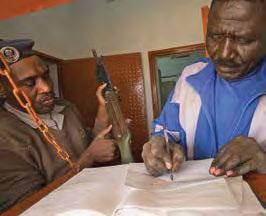
47 ISSUE 28.1 | WINTER/SPRING 2024
Armorer trained by MAG. Courtesy of Sean Sutton/MAG.
The aftermath of conflict in Libya has left a significant impact on the proliferation of weapons in West Africa. Putting an accurate number of weapons in circulation in the region is nearly impossible. Economic Community of West African States (ECOWAS) estimates that about 10 million illegal SALW are in circulation in West Africa.11 The Small Arms Survey estimates that 10,972,000 of the 40 million firearms outside of government control in Africa are spread across West Africa (2.9 firearms per 100 persons).12 Research by Small Arms Survey explored the link between the spread of insecurity and instability across the Sahel region and the increase in the demand for SALW.13 This now seems to be the case for coastal countries, where states’ security providers seek to acquire new weapons to counter insurgencies and where civilians seek to protect themselves against insecurity in areas where governments are less present.

Acquisition by states. Given how the security situation developed in the Sahel, Coastal West African governments are rightly worried about the changing situation. Significant efforts have been deployed on border security and increased military presence in border zones.14 Cooperation between states is increasing, as is the demand for military assistance, equipment, and training.15,16 Faced with increasingly frequent attacks, states are seeking to speed up acquisition of military equipment17 to be deployed in border areas.18 The increasingly lucrative armament market is not immune to geostrategic influence and expanding links with new commercial partners, such as China or Russia and private groups.19
In addition to arming their own military forces, Sahel states have also sought support and have legalized20 and provided weaponry to self-defense groups to compensate for limitations in their military operations against NSAGs in some areas. 21,22 While coastal states have not mobilized such groups, patterns of collaboration between state security forces and pre-existing self-defense groups 23 or traditional hunters' associations 24 have emerged progressively in these regions, 25 with risks that they further involve transfer of state-owned weapons.
Demand for weapons by civilians. Growing insecurity in the region has prompted states as well as residents to arm themselves, 26 initially with hunting rifles and then with more sophisticated weapons. 27 Smugglers and traffickers respond to demand for weapons from communities along smuggling
routes and in border areas who have increasingly sought to arm themselves in response to community tensions, civil conflict, the presence of NSAGs, and banditry. 28 It is estimated that weapons held by civilians account for more than 95 percent of weapons holding in coastal countries. 29 However, this does not inform about the type of firearms possessed, how they are produced, and how they circulate.
Seized weapons in several Sahelian countries originated from Ivorian state stockpiles, which poured out of Côte d’Ivoire in the aftermath of its civil war from 2002–2007. 30 After the postelection crisis, the trust between communities and between the population and authorities remained tenuous, leading to a substantial number of civilians preferring to retain their weapons rather than disarm. 31 To some extent, this is also the case for Liberia and Sierra Leone, where conflicts have had a profound impact on the circulation of weapons among civilians. The high demand for arms and ammunition has given networks, particularly in Libya, an opportunity to continue a lucrative trade. Stocks gathered in southwestern Libya are still sold to civilians for self-defense. 32 But civilians in the region also have other options to choose from outside of this illicit market.
The production of craft firearms is deeply embedded in West Africa’s culture and history with reported craft production in Cote d’Ivoire, Ghana, Togo, and Benin. Fabrication of craft artisanal
PROLIFERATION OF WEAPONS
THE JOURNAL OF CONVENTIONAL WEAPONS DESTRUCTION 48
Findings during a technical armory assessment conducted by MAG. Courtesy of Sean Sutton/MAG.
weapons has been reported as a concern in nearly all countries of the sub-region. In some contexts, the increasing demand for weapons seems to have contributed to the development of a profitable market for craft firearm production. 33 Craft firearms are no longer exclusively rudimentary items, and in several instances, their sophistication appears comparable to military-grade equipment. 34 Reports suggest that gunsmiths in Ghana have the ability to manufacture semi-automatic or fully automatic weapons. The supply and demand for both craft and industrial weapons evolves according to the security context. 35 Inter-communal conflict, between farmers and herders for example, may also contribute to increased demand for craft weapons. 36 The ease of access to and affordability of craft weapons has made them particularly attractive possessions. 37 However, the demand for craft weapons is also influenced by cultural and ceremonial practices associated with firearms. Additionally, traditional gender roles affect the demand for weapons. In numerous cultures, firearms serve as an important marker of masculinity, both as a tool for exercising protection and as a sign of men's adherence to the masculine warrior ideal. Craft weapons are no less dangerous and deadly and do contribute to fueling banditry, organized crime, and inter-communal conflicts. It was reported in both Ghana and Benin that a large majority of robberies were carried out with locally manufactured weapons. 39
Newly marked weapons.
Courtesy of Sean Sutton/MAG.
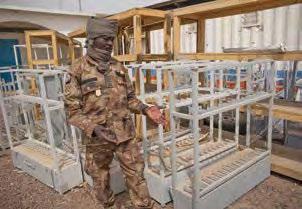

DIVERSION OF SALW, AMMUNITION, PARTS, AND COMPONENTS
Accumulation of weapons in the subregion means more potential sources of diversions are available. Despite African states' increasing efforts since 2020 to collect data on diversion, many states face challenges in recognizing diversification patterns from national stockpiles or international transfers.40
Conflict Armament Research (CAR) classifies causes of weapons diversion into six categories:41 battlefield capture; leakage due to ineffective physical security and stockpile management (PSSM); loss from national custody by undetermined means; state-sponsored diversion; state collapse where states lose or withdraw their control over stockpiles; and unknown causes. Unknown causes is when diversion is “confirmed at a specific point in the transfer supply chain; however, the cause cannot be identified with any certainty.”42 Evidence shows that the diversion of weapons from national armed forces—whether through capture on the battlefield, theft from armories, or purchase from corrupt elements in the military—is the primary source of non-state held firearms in the Sahel countries.43 The majority of industrially produced conventional weapons and
ammunition in illicit circulation within the region were initially manufactured and exported legally.44 Diversion tends to occur further down the chain.45 Weapons circulating in the region can largely be traced back to the breakdown of physical stockpile security following state collapse (e.g., Libya) or to the capture of government arsenals by non-state actors or peacekeeping missions (Mali and Burkina Faso).46,47
Diversions from national stockpiles are a growing concern in coastal countries where military posts in remote areas represent increasing sources of divertible weapons and ammunition for NSAGs and criminal networks. In one of the countries where Mines Advisory Group (MAG) works, it was reported that due to the lack of proper infrastructures, military units had to bury their weapons underground at night to protect them from theft.48
States have particularly highlighted recurring issues in this context. One such issue is the lack of capacity to manage and safely store seized SALW in border areas, a shortfall that increases the risk of these weapons being diverted again. Another significant concern is the availability of parts
(Above) Weapon storage racks provided by MAG. Courtesy of Sean Sutton/MAG.
49 ISSUE 28.1 | WINTER/SPRING 2024
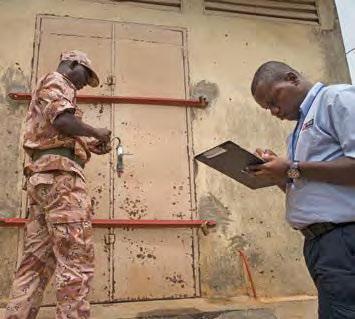
CURRENT SOLUTIONS AND CHALLENGES
SALW remain the primary tool for armed conflict in West Africa. The increasing recognition of the challenges posed by the illicit proliferation of SALW and their impact on security, development, and peace has been accompanied by the establishment of initiatives at the local, national, regional, and international levels. Effective SALW control initiative activities coupled with other initiatives relating to inclusive governance, conflict resolution, poverty reduction, education, etc. will play a critical role in reducing and preventing armed violence.
What resources can states mobilize? Effective weapons and ammunition management (WAM) by coastal West African states has and continues to reduce the number of illicit arms and ammunition in circulation, prevent weapon diversion, and mitigate the risk of unplanned explosions of munitions, thereby contributing to peace and socioeconomic and development efforts in the subregion.
The following are examples of progress made by coastal countries in SALW control efforts and areas where ongoing efforts of collaboration should continue to be prioritized:
National WAM baseline assessments have been used in the subregion to assist states in their efforts to comprehensively assess WAM institutions, policies, and operational processes and capacities. 51 They consist of a national consultative process led by the host government that facilitates dialogue and decision-making among all relevant national stakeholders on WAM and related issues. In Coastal West Africa, national WAM baseline assessments were conducted in Cote d’Ivoire
and components that can be used to fabricate improvised explosive devices (IEDs). A recent study conducted by Small Arms Survey found that most IED incidents involved explosives and precursors made for commercial extractive and construction sectors.49 Chemicals used in mining explosives are often sourced from Ghana and Nigeria and diverted to illicit markets, including for IED construction. Additionally, captured, stolen, or recovered explosive ordnance (EO)—including mines trafficked from Chad, Libya, and possibly Sudan—have been identified as serving as IED components. 50
During the assessment of an armory, a MAG technical expert evaluates the condition of the infrastructure and its surroundings, the condition of the weapons and ammunition stockpiles, and the stockpile management procedures and processes.
Courtesy of Sean Sutton/MAG.
(2016/2022), Ghana (2019), Togo (2021), and Benin (2022). States should continue to update those baseline assessments on a regular basis to further inform prioritization and policy making.
Physical Stockpile and Security Management is crucial as states increase military equipment investments amid growing insecurity. However, there's a notable deficit in securing this equipment within the subregion, leading to risks of diversion and explosions. 52 Coastal states, recognizing the expansive and technical nature of physical security and stockpile management (PSSM), frequently earmark it for assistance. Yet, challenges persist due to a scarcity of trained personnel and limited resources, hampering effective stockpile management and appropriate PSSM measure implementation. At the highest state levels, PSSM is often undervalued as a critical security measure, resulting in financially unattractive positions that elevate corruption risks. Integrating PSSM training with anti-corruption initiatives in partnership with other stakeholders and enhancing the stature and appeal of storekeeper and store managers’ roles can help to mitigate these issues. National focal points, such as National Commissions (NATCOMs), must persist in gaining traction in the prioritization of and investment in robust PSSM policies, procedures, and training. This commitment is essential for managing the accumulating weapons and ammunition and should form a key component of a broader national SALW control strategy.
THE JOURNAL OF CONVENTIONAL WEAPONS DESTRUCTION 50
For the past decade, MAG has sought to develop diverse solutions to ensure safe and secure storage for weapons and ammunition. Initially underestimated for their perceived "temporary" and "frail" nature, containerized armories have become one of the preferred ways forward. These refurbished containers are not only versatile in design, catering to a wide range of needs, but also offer significant advantages in the West African context. They are mobile, allowing for rapid deployment within three to four weeks from contract signing to key handover, and flexible, meeting the urgent demands of the region. Moreover, these containerized armories are costefficient, with expenses minimized to essential equipment and security features, and they boast a lower environmental footprint compared to traditional construction, often utilizing recycled, second-hand containers. This approach also addresses land ownership concerns, as the containers can be easily dismantled and relocated. MAG's implementation of this strategy has led to the delivery of sixty-five containerized armories across Burkina Faso, Mali, Mauritania, Cote d’Ivoire, Benin, Togo, Chad, Gambia, Guinea, Sierra Leone, and Nigeria, proving especially valuable in remote or provisional settings. The adoption of containerized armories has accelerated, driven by their ability to meet MAG's needs for accessible, quick-response solutions in areas with limited access and for short-term projects, reinforcing their standing as a robust solution to the region's storage challenges.
MAG has developed a vast array of trainings to respond to states’ needs. Training packages cover critical areas including weapons and ammunition store house and depot management, explosive and hazardous material handling, bulk ammunition disposal, explosive transportation, standard operating procedures (SOPs) for seized and confiscated weapons, SALW marking, and recording and disposal. In collaboration with Mauritania and Benin, MAG recently developed a training to enhance states’ capacities to lead technical evaluations of armories in line with international standards and to identify safety and security improvements. Training provided by MAG includes guidance and coaching on how to plan (design) and implement (deliver) either new infrastructure or improvements to existing infrastructure. Training needs are jointly identified with the representatives of security actors. The content is then tailored to the specific contextual needs and challenges. MAG conducts the training at central level and in locations where infrastructures are delivered to ensure sustainability of the response. Since 2014, MAG has conducted 395 training sessions across sixteen countries in West Africa, benefitting over 3,900 men and women. On average, women represent 3 percent of participants and although generally low, this rate has increased significantly in the last three years, reaching 6 percent in 2023.
Disposal and destruction. Due to resource constraints and limited technical expertise, obsolete and surplus material is frequently stored in inadequate facilities, elevating the risks of diversion and accidents. As an example, it was reported to MAG that in Benin, weapons and ammunition have been accumulated in depots since at least 1972. 53 However, challenges arise not only from a lack of capacity and technical expertise but also from insufficient awareness at the highest levels about the broader benefits of proper disposal. NATCOMs and their partners can have a significant impact in garnering internal support in states to promote disposal and assist other government agencies with procedures for the handling of weapons and ammunition seized. In 2022, all coastal countries had requested technical and funding assistance to support destruction efforts.
54
Each accident in the region has been a harsh reminder of the critical and lifesaving importance of disposing of obsolete and surplus ammunition. 55 To prevent further risks of accidents and diversion, MAG has supported states in the safe destruction of over 998 tons of ammunition since 2014 (125 tons in 2023 only) and 33,000 SALW.
Marking. Effectively and thoroughly marking weapons supports accountability, helps maintain accurate national inventories, is a prerequisite for tracing, and is therefore a critical measure against diversion. With international assistance, West African countries in the sub-region are making remarkable progress on this in line with the ECOWAS Convention obligations. 56 Imported and stateowned weapons are typically marked before distribution or dispatch. However, if this is not done, mobile marking teams are mobilized, as exemplified by the practices in Cote d’Ivoire and Ghana, which are considered models of good practice in the sub-region. Although marking for state-held weapons has progressed, the marking of civilian weapons, craft weapons, or seized weapons (before they are disposed of) is falling behind. Policy, SOPs, equipment, technical expertise, and resources to mark weapons are common challenges for states needing continued assistance. Policy makers, NATCOMs, and security actors need to closely cooperate to broaden marking strategies and foster in-country capacities to align practices with internationally recognized standards and commitments.
51 ISSUE 28.1 | WINTER/SPRING 2024
Recordkeeping. Despite the focus on marking, progress in recordkeeping has been comparatively slow. The ECOWAS Convention, aligning with international standards, mandates the creation of national and sub-regional computerized registers and databases for state-held SALW. While accounting systems for states are generally in place across the sub-region, the recording and storage of weapons and ammunition data predominantly remains paper-based. Countries like Cote d’Ivoire and Ghana have initiated steps toward digitizing and centralizing their weapons registers but are hindered by a lack of resources and technical expertise. Further cooperation to provide trusted, simple, and affordable solutions is crucial to prevent diversion.
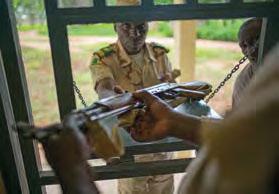
Seeking to provide a more comprehensive response to Armed Violence Reduction, MAG has established strategic partnerships with global stakeholders in the sector. For instance, MAG has teamed up with the Centre for Armed Violence Reduction (CAVR) to assist national authorities in implementing ArmsTracker, a user-friendly, cost-free arms record-keeping system that meets global standards and is especially suited for countries with limited resources and high needs. Moreover, MAG works closely with the Small Arms Survey in several areas, including in the development and review of National Action Plans, and in undertaking research activities in various countries, which inform and refine MAG's policy and strategic focus. These new collaborations have proven to be mutually beneficial and have opened new avenues for addressing armed violence more effectively.
Weapons to be destroyed. Courtesy of Sean Sutton/MAG.
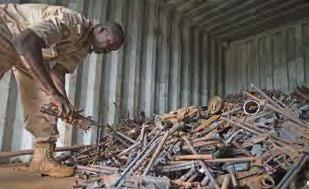
Weapon-collection programs play a crucial role in reducing the quantities of unwanted, illegal, and illicit weapons that could otherwise fuel armed conflicts or violence. In Cote d’Ivoire, two voluntary weapons collection initiatives were established following the end of the conflict in 2011, as part of disarmament, demobilization, and reintegration efforts. Across West Africa, countries including Cote d’Ivoire, Burkina Faso, Niger, Liberia, and Togo have participated in the African Union's "Amnesty month" initiative, aiming to encourage the surrender of illicitly-owned weapons without facing prosecution. While the results have been modest to date, when integrated into broader peacebuilding and development initiatives, weapon collection campaigns can effectively
convey messages regarding the harmful consequences of weapons proliferation. States can work with various actors to ensure that these campaigns are conflict-sensitive, prioritizing community safety and security, while considering the specific needs of local communities.
Institutional arrangements and good governance assume a pivotal role in facilitating effective collaboration in the implementation of SALW control efforts. The ECOWAS Convention requires states to establish a NATCOM for the fight against the illicit proliferation and circulation of light weapons. In 2021, Nigeria became the most recent member state of ECOWAS to establish a NATCOM, bringing all member states in line with article 24 of the convention. NATCOMs are of paramount importance as they bring together diverse government entities to supervise and foster the implementation and coordination of arms control initiatives. Hence, it is crucial that they receive ample resources and are strategically positioned within the governmental architecture and equipped with a sufficient mandate to facilitate their role. All NATCOMs in the region have highlighted that they would need a larger mandate to operate effectively. 57 This is significant because NATCOMs can bridge the gap that often exists between government leaders and military affairs. They facilitate effective collaboration between those who wield influence among high-level political actors and national security agencies to garner support for advancing SALW control priorities.
Storekeeper trained by MAG. Courtesy of Sean Sutton/MAG.
THE JOURNAL OF CONVENTIONAL WEAPONS DESTRUCTION 52
National action plans. National efforts to address the proliferation of illicit small arms are expanding in scope from PSSM to wider initiatives that consider the entire life cycle of weapons and ammunition. National Action Plans (NAPs) elaborate national priorities and outline the needs and focus of the country’s priorities in SALW control. As states strive to fulfill their obligations under the convention and integrate the Arms Trade Treaty, all subregional states, excluding Ghana, have formulated, endorsed, and assessed their NAPs. As states progressively recognize the importance of NAPs, they must ensure that their development and validation process 58 is conducted in collaboration with the relevant ministries 59 and civil society actors. NAPs require significant resources and technical expertise. Consultations held in the sub-region highlighted the interest of states to expand the scope of future NAPs to firearms and ammunition held and produced in the civilian sphere, as well as IEDs. In particular, issues pertaining to the licensing of firearms and to the production of artisanal weapons have been identified as key priorities.
National legal framework. Countries in the region exhibit distinct approaches to national weapons regulations and have all identified the need to implement a review of their existing national legal frameworks governing weapons and ammunition to align with international instruments and technical guidelines. States often highlight the difficulty to receive sustainable and dedicated technical assistance to develop, draft, and adopt national legislation and regulations. Regulations in countries are generally outdated and do not adequately address current challenges related to SALW control. For example, in Benin, although under revision, the current legislation only covers civilian weapons. The slowness and complexity of the licensing system and the process for obtaining a license tends to discourage civilians from taking steps that would enable them to comply with the law, perpetuating the illicit procurement of weapons. 60 Ghana and Cote d'Ivoire emphasized the necessity of developing or enforcing legislation to safeguard lands in proximity to storage areas from encroachments, given the urban population expansion drawing nearer to these storage facilities. Continued collaboration among states in the region would streamline regulatory frameworks, raising public awareness and promoting compliance among security forces.
Focus on craft weapons. Despite their prevalence among various groups, the
inclusion of craft weapons in laws and decrees is often ad hoc and subject to interpretation. 61 The ECOWAS Convention does not distinguish between types of production. Aside from Benin, member states seeking to regulate the production of weapons and ammunition tend to adopt an indiscriminate approach that implicitly includes both industrial and artisanal production. This inevitably raises concerns as to the feasibility or relevance of legislative requirements (including licensing, marking, and recordkeeping) for many craft items produced, which are likely to deter craft producers to comply with the law. However, in regions where weapons production capacity comes from artisanal production, and where their demand and supply are on the rise, states could better account for these weapons in their regulatory frameworks, including by developing a licensing and registration system for artisanal producers and by defining procedures for marking civilian weapons. Ghana and Benin have already taken steps with sensitization workshops on the topic. Progress can be made through regional collaboration with countries in the region, such as Sierra Leone, where recent research will likely inform future regulatory approaches.
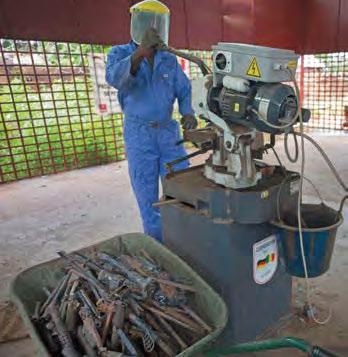
53 ISSUE 28.1 | WINTER/SPRING 2024
Personnel trained by MAG operating a weapons cutting machine. Courtesy of Sean Sutton/MAG.
WHY COLLABORATION BETWEEN LOCAL CIVIL SOCIETY AND COMMUNITIES SHOULD NOT BE OVERLOOKED
Civil society in West Africa is rich and the number of civil society organizations (CSOs) is growing exponentially.62 The effective policy shifts regarding SALW in West Africa can be largely attributed to the dedicated efforts of CSOs, which emerged as a key catalyst in evolving the non-binding ECOWAS moratorium into a legally enforceable convention.63 The regional network of International Action Network on Small Arms (IANSA), 64 known as the West Africa Network on Small Arms (WAANSA), 65 collaborated effectively to spearhead the movement for a more robust arms control framework in the region.
Today, the role of civil society in SALW control efforts is well recognized in the ECOWAS Convention, as well as in international instruments. In the complex landscape of weapons proliferation in coastal West Africa, regional CSOs—such as WANEP, 66 MALAO, 67 or WANSAA—and local organizations, have emerged as indispensable allies for the implementation of SALW control efforts:
Grassroot connections and access to populations: CSOs have strong connections at the community level. This allows them to effectively disseminate information about laws and raise awareness about the dangers of SALW proliferation within communities. Due to their understanding of regional contexts, CSOs can discern the most relevant resources and mobilize community leaders to advocate SALW control efforts and build local capacity. As an example, in December 2023, Ghana’s National Commission on Small Arms and Light Weapons (NACSA) embarked on an awareness campaign to address the growing threat of illicit trafficking of SALW in partnership with schools, bus companies, CSOs, and the Narcotic Control Commission.
Advocacy and lobbying: CSOs are skilled in advocacy and lobbying, enabling them to influence policy and legislative changes. They act as a bridge between communities and policymakers, voicing the concerns and needs of those most affected by SALW proliferation. The WANSAA network has been particularly active in recent years, especially in Cote d’Ivoire, around the implementation of the Arms Trade Treaty in national legislation.
Research and data collection: CSOs have also largely contributed to research and data collection in the subregion. Through their community connections and understanding of regional contexts, they can provide insights into the factors driving civilians to arm themselves, as well as the socioeconomic impact of this proliferation on local communities. This information is crucial for shaping effective control strategies at the national level.
Policy-making: Based on their insights and presence on the ground, CSOs are essential to inform evidence-based policies.
The inclusive processes of NAPs’ development and review are examples that show how states in the region consider CSOs as essential stakeholders for policy making and monitoring.
Representing diversity: Local organizations have the capacity to bring together a wide range of stakeholders, including marginalized and often overlooked communities. This is essential, as to be effective, SALW control initiatives should be inclusive of specific needs and experiences of all segments of the population.
Integration of SALW into local conflict resolution and peacebuilding initiatives: SALW practitioners should explore opportunities and tap into larger local or regional peacebuilding networks outside of the SALW community of practice. Incorporating SALW capacities into peacebuilding processes can more effectively address root causes and develop more context-specific solutions. Addressing the factors that lead to armed violence in the first place can help reduce the demand for weapons. This approach can also help bridge existing gaps between national agendas, such as SALW controls and the Women, Peace, and Security agenda. 68
A bridge between communities and security actors: Due to the nature of their work, CSOs working in the SALW sector will inevitably develop relations and trust with security sector actors. In regions where government presence is weakened or nonexistent, CSOs within the SALW community can also serve as vital conduits of trust and communication between local communities and government entities.69 For example, in 2021, WANSAA Cote
4.5 million small arms ammunition destroyed
33,011 small arms and light weapons destroyed
12,683 small arms and light weapons marked
204,000 small arms and light weapons secured
More than 3,000 male and female personnel trained in physical security and stockpile management standards
Over 50,000 women, men, girls, and boys received risk education on small arms and light weapons
THE JOURNAL OF CONVENTIONAL WEAPONS DESTRUCTION 54
Figure 1. West Africa 2014–present. Courtesy of MAG.
d’Ivoire conducted a study on security governance to inform policy makers about the risks of the widening gap between local communities and security sector actors, which has largely informed measures taken by the government.70
The growing expertise of civil society and grassroots connections are invaluable resources that national governments, ECOWAS, and the international community should invest in. In
2020, Ghana’s Executive Secretary of the NATCOM declared “CSOs could improve the quality of policy making by providing state agencies with a wider spectrum of information, views and suggestions on how to deal with illicit SALW and voice the concerns and needs of the minority groups who might otherwise not be heard, including women and youth.”71
MAG’s engagement and partnership approach with local CSOs in the region has greatly evolved in the past five years and continues to do so. We are working with a diverse range of local civil society actors who possess deep insights of local communities and contexts. Their presence and credibility enhance the acceptance and impact of all our initiatives, especially risk education activities, and help MAG ensure activities are sensitive to conflicts dynamics, whilst contributing to peace. They often establish networks that facilitate access to vulnerable populations, ensuring that life-saving information reaches those who need it most. In Mali, Niger, Burkina Faso, and Nigeria, we have witnessed the growth and development of our local partners, watching them become stronger, more influential, and increasingly professional in their technical capacities to deliver tailored and safe messaging. This not only reflects the efficacy of our partnership but also holds significant implications for our broader mission. MAG is currently expending this localization strategy to Coastal West African states.
WHY AN INTEGRATED AND COORDINATED REGIONAL RESPONSE IS ESSENTIAL
Given the intertwined nature of conflicts and trafficking dynamics in the region, effective SALW control efforts inevitably require an integrated and coordinated regional response.
The legally-binding ECOWAS Convention on SALW, adopted in 2006, was a progressive and innovative step to respond to a growing regional concern. The convention mandates member states to implement comprehensive SALW control measures, including establishing NATCOMs and developing action plans, while also encouraging public awareness and civil society engagement.
Under the Convention and ECOWAS’ leadership, an active SALW community of practice emerged in the region. Escalating insecurity in the past decade has spurred a multitude of initiatives aimed at addressing a multidimensional crisis. However, the risk of overlap or operating in isolation can limit effectiveness. Coordination and integrated response among the multiplicity of actors is needed in an environment where resources are ever more constrained. Following are a few nonexhaustive examples of regional initiatives and stakeholders that can foster collaboration and coordination of SALW control efforts:
ECOWAS and its SALW division play a vital role in coordinating efforts across member states to ensure a unified and effective approach to SALW control. The division supports the implementation of regional and national projects by working and liaising closely with NATCOMs and stakeholders implementing SALW activities in line with its WAM road map. But the multiplicity of challenges (trafficking, criminality, IEDs, violent extremism, climate) means that ECOWAS must ensure coordination between its own divisions and provide them with the required leadership.
The NATCOMs network operate under a common set of goals under the ECOWAS Convention. Although they operate within their national context, NATCOMs form a network that fosters collaboration, exchange of information, good practice, and streamlines approaches. Under ECOWAS leadership, NATCOMs meet annually to review the implementation of the Convention. This platform facilitates coordination between ECOWAS, NATCOMs, implementing organizations, and donors. However, political instability in recent years and the suspension of countries from ECOWAS poses a risk to the convention’s implementation, as it de facto limits regional cooperation and coordination. Although invited to the annual meeting in Dakar in December 2023, NATCOMs from Niger, Burkina Faso, Mali, and Guinea did not participate.
A pool of PSSM experts, in partnership with Bonn International Centre for Conflict Studies in Germany, ECOWAS has been developing national and regional PSSM capacities through the training of national focal points, as well as instructors able to design and deliver training across the region and the continent.
Similarly, the Centre de Perfectionnement aux Actions post-conflictuelles de Déminage et de Dépollution (CPADD)72 in Benin has established itself as a regional center of excellence, providing training and capacity-building in PSSM activities. As an Ecole Nationale a Vocation Regionale,73 CPADD serves not just Benin but also extends its expertise and training programs to other countries in the region. This fosters collaborative efforts, uniformity in skills and standards throughout the region, enhances stability and safety, and
55 ISSUE 28.1 | WINTER/SPRING 2024
ensures that training is relevant to the specific context. This fosters regional collaboration, consistency in skills and standards across the region, promotes regional stability and safety, and ensures trainings are contextually relevant.
Kofi Annan International Peace Training Centre (KAIPTC) builds upon Ghana’s experience supporting peacekeeping operations on the continent. KAIPTC runs training courses as well as academic programs on conflict, peace, and security, and provides a regional platform for projects and inter-agency collaboration. The center also has a research program and is strengthening its engagement with civil society organizations.
The multiple crises the region is facing have prompted
the development of a multitude of platforms, mechanisms, and programs to assist states in navigating difficult issues. However, despite the overlapping nature of these challenges, there's a tendency among stakeholders to address these issues in isolation, resulting in a significant gap in coordination and cross-sectoral collaboration. While there is potential to build upon past experiences and lessons learned, there is also a concrete risk of inordinate duplication of efforts. While strategies must be nationally and regionally owned, and the primary responsibility for a coordinated and effective response lies with the affected states and ECOWAS, the international community has a key role to play.
HOW THE INTERNATIONAL COMMUNITY CAN FURTHER SUPPORT
In resource-constrained contexts where there are competing national priorities, international support is not only crucial but required by international instruments. Beyond providing much needed funding and technical assistance, this community could play the role of facilitator by bringing diverse experiences, expertise, and perspectives to the table, enabling a more comprehensive response to the multifaceted aspects of armed violence.
Supporting affected states in taking part in policy formulation and norm setting. The international community has a key role in bringing the diverse experiences and voices of affected states and communities in the sub-region to the forefront, ensuring that their perspectives inform policy development at the international level. SALW fora must ensure inclusive policy development, integrating insights from those directly impacted by SALW proliferation to ensure that policies are both effective and reflective of the nuanced realities of affected regions.
Further integration of SALW into development frameworks and assistance. Over the years, growing understanding of the negative consequences of insecurity on development was accompanied by the recognition of the role played by the proliferation of SALW in fueling insecurity, conflict, and armed violence and, thus, impeding development.74 The 2030 Agenda for Sustainable Development provides the international policy community the opportunity to approach SALW control through a developmental lens. However, SALW control is still largely considered a matter of arms control or disarmament, and existing assistance mechanisms focus too often on the instrument of violence rather than on the violence itself. For western coastal countries, addressing SALW proliferation is not simply a matter of arms control, but is a critically important component that should be embedded within conflict prevention, peacebuilding, and development of national strategies. To more effectively address the issue of armed violence in the sub-region, it is imperative that the international community seeks to better
operationalize the link between conventional arms control and sustainable development within their assistance policies and funding decisions.
Cross-sector pollination. Addressing the multifaceted challenges of armed violence necessitates a multisectoral response. Too often, there is a tendency for experts to operate in isolation. Breaking down these silos is essential for developing coherent, evidence-based approaches to prevent and reduce armed violence. Integrating considerations of gender, age, diversity, human rights, and conflict dynamics into SALW control efforts is crucial. Programs must be more adaptive and better reflect the realities on the ground. By seeking to understand the drivers of armed conflict, the SALW community can better visualize contexts in which solutions may exist.
In the sub-region, MAG has joined forces with various partners under the Organized Crime: West African Response to Trafficking project led by ECOWAS. This project has been an opportunity for partners to learn from one another and to mutually reinforce each other. So has been the case with International Alert, another strategic actor MAG has developed a global partnership with to support and consolidate our progress made on gender75 and conflict sensitivity in the region.
Monitoring and reporting. Countries in the sub-region have been relatively successful with reporting with regards to their SALW international commitments. Reporting acts as a confidence-building measure, helps identify needs for international assistance, and reaffirms states’ commitment to its obligations. But the quality and accuracy of these reports differ. Given the complexity and often overlapping nature of reporting requirements, states have indicated reporting fatigue. NATCOMs in the region report difficulties monitoring and consolidating all data related to SALW control initiatives implemented on their territory. This lack of institutional
THE JOURNAL OF CONVENTIONAL WEAPONS DESTRUCTION 56
memory is partly due to the lack of institutional capacity within the NATCOMs, but also because of the scope of their mandate or how they are positioned within the government architecture. It’s important that the international community
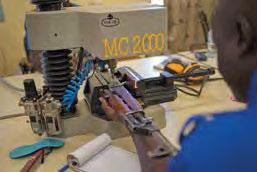
CONCLUSION
The escalation of violent incidents in the region is undeniably putting pressure on the resilience of coastal states and local communities. Lessons-learned from the Sahel, especially concerning states' responses to rising insecurity, are invaluable. In instances where a military and security response might be unavoidable in the short term, this should not lead to indiscriminate actions or violations of human rights and international humanitarian law.76
Coastal states recognize the recent conflicts in the subregion and the profound long-term effects that SALW have on societies. The significant progress achieved in SALW control, led by states and ECOWAS, needs to be sustained and advanced, especially with the increasing demand for weapons. Prioritizing SALW control measures is essential for policymakers at the highest political and military levels, necessitating political will, ownership, investment, and enhanced collaboration and coordination between states and ECOWAS. NATCOMs are key and strategic allies in these internal and external mobilization efforts.
However, in this context, the issue of SALW proliferation cannot be solely viewed through a security lens. SALW are both drivers and manifestations of violent conflict. The international and SALW communities' support for coastal states in their efforts to prevent and mitigate violence requires an understanding of the reasons behind weapon acquisition. The dynamics of SALW in the region are influenced by both demand and supply factors. Operating SALW activities in isolation will limit effectiveness; applying an armed violence reduction lens could deepen
maintains support to those states with their reporting practices while simplifying the reporting framework across various instruments to encourage more consistent and comprehensive compliance.
Forgotten fragile neighbors. The situation in the Sahel starkly illustrates the severe humanitarian costs of conflicts driven by the widespread proliferation of SALW and highlights the extensive efforts needed at all levels to mitigate their consequences. The recent power shifts in Mali, Guinea, Burkina Faso, and Niger are not only eroding democratic values but are also hindering international assistance. While it is critical to continue finding ways to support Sahelian states grappling with the impact of ongoing conflicts, the case of Coastal West Africa highlights the importance of not neglecting neighboring states. As the conflict spills southward, the international community should therefore ensure that it does not forget fragile neighbors in the region that are still working hard to prevent the spread of violence within their own borders.
our comprehension of the broader context of armed violence, facilitating the incorporation of SALW control into holistic development and peacebuilding frameworks.
See endnotes page 76
A very special thanks to Hélène Kuperman, Regional Head of Programmes for MAG Sahel and West Africa, for helping me in my reflections during the writing of the article. Many thanks to MAG’s Weapons and Ammunition technical experts Philippe Cima, Yacouba Kone, Arnaud Beyaert, and Brahima Coulibaly for bringing field experience to the article.
CLÉ MENT MEYNIER
Regional Programme Support Manager
Mines Advisory Group (MAG)

Clément Meynier is Regional Programme Support Manager at Mines Advisory Group (MAG) for Sahel and West Africa. He has fourteen years of experience working in the humanitarian and development sector in program management. Before joining MAG in 2019 as Country Director in Bosnia and Herzegovina, Clement worked for Humanity & Inclusion and the Danish Refugee Council in Morocco, Tajikistan, Kyrgyzstan, Libya, Myanmar, Nigeria, and the Sahel.
Serial numbers being engraved into weapons. Courtesy of Sean Sutton/MAG.
57 ISSUE 28.1 | WINTER/SPRING 2024
The Detection Problem: AN EIGHT-DECADE CHALLENGE.
The Difficulty of Practically Detecting and Discriminating Mines, Booby Traps, and Victim Operated Improvised Explosive Devices
By Roly Evans, Tracey Temple, PhD, and Lt Col (Retd) Liz Nelson [ Cranfield University ]
Reliably detecting and discriminating mines, booby traps, and victim operated improvised explosive devices (VOIEDs) remains a stubborn problem for both humanitarian demining organizations and the military. Since mines were widely used during the Second World War, much effort has been expended on the detection problem, with limited success. The aim of being able to positively identify a device first time remains elusive since the scientific challenge of positively identifying different substances in the ground is formidable. This article critically examines the detection problem and suggests that in the continued absence of a ‘silver bullet’ technological solution, the best means currently available to manage the risk of concealed explosive devices is the systematic collection and analysis of relevant operational data from the field.
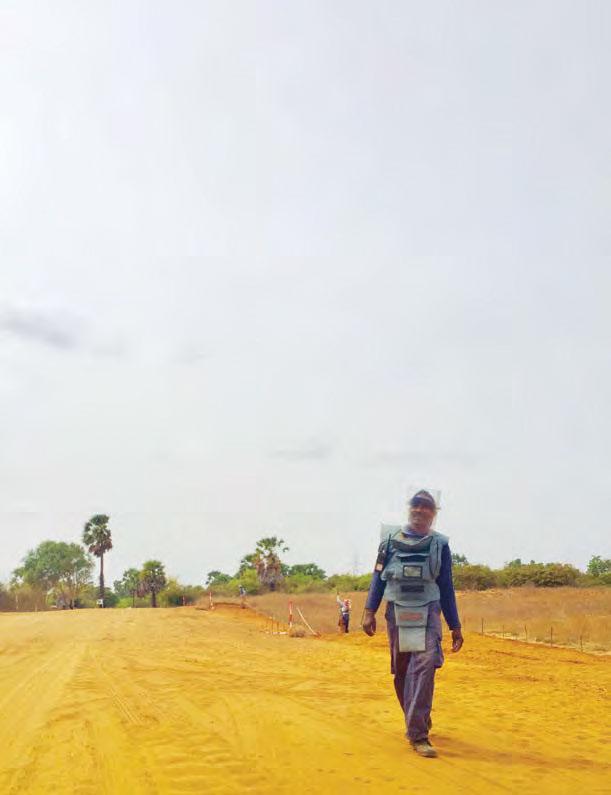
A deminer walks on an area fully excavated by means of raking and mechanical excavation. The area has been fully excavated due to a minimum metal mine threat and high levels of metal contamination. Courtesy of Roly Evans.
THE JOURNAL OF CONVENTIONAL WEAPONS DESTRUCTION 58
INTRODUCTION
Neither military nor humanitarian actors can reliably detect and discriminate mines and booby traps in operational environments. This has been the case since mines became a common feature of conflict during the Second World War.1 There have been many claims that a given sensor is the answer and can not only detect an item but discriminate it from everything else that is likely to be found, whether it is fragmentation from exploded ordnance (EO), other metal contamination, various soil types, or even rocks. 2,3,4,5,6,7,8 However, despite the assertions made over eight decades, military units and humanitarian demining organizations still struggle to reliably detect and discriminate victim operated explosive devices (VOEDs), including IEDs,9 anti-personnel (AP) mines,10 anti-vehicle (AV) mines,11 and booby traps.12 Mines or IEDs with minimum
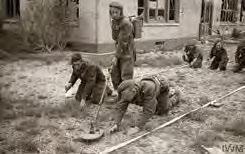
An older model Polish mine detector (PMD) being used to search the grounds of a hotel in Luc-SurMer, Normandy, July 1944. PMDs gave good service but struggled against low metal content mines or, as for modern EMI detectors, in areas of metal contamination. Note the lack of safety distances or personal protective equipment employed. Image IWM B 7342.
Courtesy of IWM, Imperial War Museums.
THE DETECTION PROBLEM
On 18 February 1946, a meeting took place in the Ministry of Supply in the Shell Building on the Strand in London, attended by senior military officers, civil servants, and research scientists. The purpose of the meeting was “research into the clearance and detection of landmines.” After years of various means of detection development, from early Soviet and Japanese efforts in the late 1930s, 32 and French efforts in 1940, 33 followed by extensive US 34 and British35 research before and throughout the war, General Sir Eustice Tickell, the British Army Engineer in Chief stated “that at present the Army had no answer to the mine
metal content provide an extra level of detection and discrimination difficulty. Even explosive remnants of war (ERW)13 with significant metal casings are hard to discriminate from false positives in metal contaminated ground and therefore effectively detect. Difficulty in detection and discrimination makes search and clearance painfully slow in both humanitarian and military contexts.
This article will critically analyze what has sometimes been referred to as the “detection problem.”14,15,16 The lack of a technological solution is naturally a key explanation as to why it has not been solved, but the reasons are more complex. Sometimes the problem has not been properly defined into a well-formed requirement that acknowledges the need for a reliable detection capability in operational conditions. Overly positive claims of solutions have been commonplace. Added to this has been an unwillingness, at least in military circles, to remain fully engaged with the problem except during times of conflict, and especially during counter insurgencies when its urgency means it can no longer be ignored.17 The technology might have fallen short in meeting the mine detection problem, but in some ways so has the military18,19,20 and humanitarian21,22,23,24 approach.
This is important because the detection problem matters. It matters since the progress of humanitarian efforts to clear land and enable development in postconflict environments is significantly impeded by the difficulty of practically detecting and discriminating VOEDs. 25,26 It matters since IEDs, many of them victim operated, are a key, possibly the key means of inflicting casualties during an insurgency, to the extent that their use was in 2006 deemed to have strategic significance. 27 It matters since mines and booby traps are still a significant aspect of modern conventional warfare. 28,29,30,31

problem.”36 A 1946 UK Signals Research and Development Establishment (SRDE) memorandum noted that “the mine was at times during the war the limiting factor in retarding mobility and came to be regarded as the Queen of the Battlefield.”37 Another Ministry of Supply letter noted that, “you will no doubt fully appreciate the vital nature of this problem so far as the Army is concerned.”38 In an infantry conference in Fort Benning in the United States in June 1946, it was recognized that despite claims of being able to detect at least mines with metallic content, “the means available during the past war for mine detection consisted
59 ISSUE 28.1 | WINTER/SPRING 2024
principally of manual probing and hand carried mine detectors.” The latter “had many deficiencies.”39
Six decades later in early 2006 the Joint Improvised Threat Defeat Organization (JIEDDO) was established with a recognition that to defeat IEDs, soldiers must first be able to detect them.40 In 2005, Lt General John Abizaid sent a memo to the Under-Secretary of Defence calling for a Manhattan Project-like effort to counter IEDs.41 In 2008, it was admitted that “in the absence of a reliable method to detect IEDs and prevent their use, Coalition Forces have dedicated significant efforts and resources to searching, clearing and securing roads and other vital areas.”42 In 2011, “after five years of work, hundreds of projects, and a blizzard of cash paid to some of America’s biggest defence contractors, JIEDDO has not found a high-tech way to detect” IEDs. “In fact, the rate at which soldiers are able to find IEDs before they explode has remained mostly steady, at roughly 50 percent, since JIEDDO was formed.”43 The then outgoing JIEDDO director, Lt. General Michael Oates, stated that “the best bomb detectors are still dogs working with handlers, local informants, and the trained
DETECTING WHAT?
What is available to be detected in a mine, booby trap, or victim operated IED? For the first mines, and even for many mines deployed today, the metal content was the obvious material, whether it was part of the casing or the fuzing system. As minimum metal mines developed during the Second World War, wooden, concrete, clay, tar, or even glass casings became common. Now the metal components can be as little as an aluminum cup for the detonator. In the 1980s, the US National Ground Intelligence Center defined a minimum metal mine as having 2.46g of metal. 50 This was the amount of metal in the M606 fuze assembly of the M-19 minimum metal mine. The only metal was a minimal part of the striker and the aluminum detonator capsule. 51 In some minimum metal mines, such as the Spanish P-4-B, even the striker is made of plastic, with the only metal being a chromium spring that acts as a holding device, and the detonator capsule with a foil cover for the primer. 52 Perhaps the only component of a blast mine that is still invariably metal is the detonator capsule or primer A minimum metal P4MK2 mine. The only metal content is a compressed cocked striker spring, a shear wire, a striker, and the casing for the detonator. While there are mines that are even more difficult to practically detect, the presence of this mine in metal contaminated ground will probably result in full excavation being employed. Courtesy of Roly Evans.
soldier’s eye.”44 The following year, after over a decade of counter insurgency in Afghanistan, it was observed that “despite spending billions of dollars on detection technologies, the United States has yet to develop an effective long range stand-off detection capability and the find rate prior to detonation has remained at around 50 percent. The best methods of detection remain mine detection dogs, humans and low-tech tools.”45
The last eight decades have seen significant progress in military technology. Some believe this represents a revolution in military affairs;46 however, one technological problem—the detection problem—has proved practically unsolvable. Tools that are available, such as metal detectors, have become more refined, to the point of being declared a “mature technology.”47 However, the fundamental problem of not only detecting VOEDs, but also discriminating them from many other false positives remains.48,49 Technology that might look promising in a laboratory or in favorable test conditions has consistently fallen short in an operational environment. The aim of positively identifying a VOED first time remains elusive.

cover (aluminum), 53 with it being viable to manufacture other components from non-metallic materials. Devices with an electrical means of initiation, such as many victim operated IEDs, will typically have a battery as a power source and this, depending on the depth it is buried, is as detectable as other significant metal components. Other objects associated with electrical devices, such as an aluminum detonator casing, are usually more detectable than the thin copper wiring used to connect the circuit.

THE JOURNAL OF CONVENTIONAL WEAPONS DESTRUCTION 60
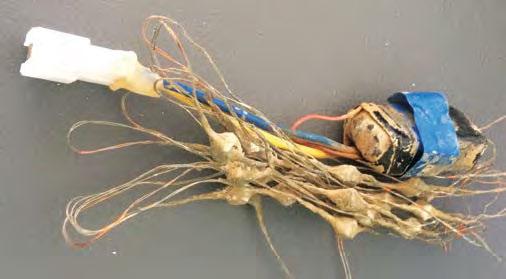
Mechanically initiated victim operated IEDs and booby traps can in theory have no metal content but in practice consistently do. 54
Many items of EO, whether found as ERW55 or employed as main charge components in an IED or booby trap, will have substantial metal content. A significant proportion of EO employs a metal casing not only to provide fragmentation but also to withstand the extreme forces applied on firing or dropping. If used as a main charge in a victim operated IED, it can make that device more detectable, although it is not always this simple. Such devices might be at a distance from the switch that initiates the device, which itself might not be easily found. There are mines that rely on primary fragmentation as their lethal mechanism, such as directional, omnidirectional, and bounding fragmentation mines. These, and booby traps that employ an explosive fragmentation munition such as a grenade, naturally have metal casings that are in theory more detectable but sometimes in practice can still present a challenge. 56,57 In all cases, in areas of metal contamination, all EO is very difficult to practically detect
A crush wire and a 9 volt battery recovered in Iraq. While not straightforward, the wire is detectable and the battery should be relatively easy to detect, but even this can be a challenge in metal-contaminated soil. Courtesy of Roly Evans.

since it is hard to discriminate from other metal clutter. This will result in searchers investigating a high proportion of false positive signals.
Alternatively, a detector can try to detect the explosive charge itself, especially for devices the size of an AV mine or equivalent IED, the charge represents sufficient material that can have an identifiable density different than the surrounding soil. Chemical detection of the explosive is also theoretically possible, especially if the case is ruptured. Mines may also be differentiated from the surrounding soil by a differing heat signature. The fundamentals of what components are common to all concealed explosive devices were identified during efforts to address these weapons during and after the Second World War. During the Ministry of Supply meeting in February 1946 it was “recognised that an explosive and detonator were the only inescapable components of any mine, and that any casing (metallic, magnetic or plastic) and any trip mechanism (operated by pressure, displacement, magnetism, electrical induction, delay, remote control etc.) were variable incidentals.”58
ELECTRO MAGNETIC INDUCTION DETECTORS
The Soviets can possibly lay claim to the first widescale operational use of a magnetic mine detector during the Winter War of 1939–1940. 59 For the United Kingdom, the first operational use of a ‘metal detector’ to detect mines was the deployment of the Goldak commercial metal
detector in 1941, soon to be replaced by the Polish mine detector (PMD) in the western desert by October 1942. Minefields are obstacles and warfare in the open desert proved a catalyst for the development and deployment of mines as a means of creating artificial obstacles.
61 ISSUE 28.1 | WINTER/SPRING 2024

An APOPO deminer in Zimbabwe in December 2023 using a Minelab F3 detector with a black endcap for high sensitivity. The detector has just indicated on a R2M2 minimum metal mine that was subsequently found to be a 7cm depth in sandy soil. Deminers may clear 25 m2 per day in such conditions.
Courtesy of APOPO.
Almost all mines in 1942 employed metal in both the casings and the fuzing system. The detector employed two coils connected to an oscillator, the current of which generated an oscillating acoustic frequency connected to headphones by means of an amplifier. The charge in each coil was balanced but this balance was altered when proximity to metal caused impedance. The detector went through three versions until the No.4A, which added a regenerative circuit. The No.4C became the standard for decades beyond end of the war. 60 These detectors were also widely used in the clearance of metallic mines in the United Kingdom and Europe. 61 Concurrent to this, the United States developed the Detector Set, Anti-tank Mine, Portable SCR-625 in early 1940. 62 This would become the standard US detector of the conflict. Similar in concept to the PMD, but with three coils rather than two, the SCR625 also operated on the principle of a “balanced mutual inductance bridge.”63
While electro magnetic induction (EMI) detectors became the standard means of searching for mines with sufficient metal content, they were not always the primary
means, due to their limitations. In 1962, over twenty years after detectors were first deployed, their practical limitations were well known to the Royal Engineers. While conceding that ‘electronic detectors’ can search ground far more rapidly than prodding, the official Detection and Clearance of Mines Pamphlet noted that the metal that may be found in mines was “not clearly distinguishable in the head-phones of a detector from other small metallic objects likely to be present in the ground, particularly on the battlefield. The use of detectors is therefore confined to following up prodders to search for deep buried metallic mines which are too deep for the prodders and any shallow metallic mines which they may have missed.”64 The same approach was also adopted by the US military. 65
In the decades since, EMI detectors have become increasingly refined and have remained the mainstay of efforts to detect explosive devices with at least some metal content, including some minimum metal landmines. Deemed a “mature technology” in 2006, they remained “the primary means of detection used in mine action programmes,”66 rather than a follow-up technique for prodding which even in 1962 was recognized as “not a safe method.”67 The fundamental design retains transmitter and receiver coils, with a time varying current creating a low frequency electromagnetic field that can induce eddy currents in a nearby metallic object. Modern metal detectors have been labelled “low frequency EM induction devices.”68 Some soils, such as laterite soils in Southeast Asia, can also induce current in the receiver coil. Much of the development in EMI detectors has been focused on the use of algorithms to discount such signals. Modern detectors might have a ground compensation feature that is activated in a clear piece of ground but enables the detector to register the electromagnetic signature of the soil in order to subsequently discount it. This is known as soil signature suppression. 69 No answer to significant metal contamination has yet been found. Fragmentation from detonated EO means many false positives, all of which have to be investigated by the deminer. Sometimes the density of false positives in an area invalidates the use of a detector and the only remaining option is full excavation of the entire topsoil to a given depth (typically 13–20cm). EMI detectors also struggle near large concentrations of metal, such as vehicles, power lines, fences, and even reinforcement bars in walls and floors. While such detectors therefore remain a useful tool to assist in the search for VOEDs, the practical inability to discriminate signals means such sensors cannot be deemed a reliable solution to the detection problem.

THE JOURNAL OF CONVENTIONAL WEAPONS DESTRUCTION 62
GROUND PENETRATING RADAR
Ground penetrating radar (GPR) makes use of the electro-magnetic spectrum, typically between 300 MHz70 and 2.6 GHz. The focused application of pulsed energy in this range, (more modern GPR may apply energy at around 1 GHz), is now common in GPR employed for demining purposes. Anomalies relative to the surrounding soil in the reflected signal can possibly indicate the presence of a mine but can also indicate the presence of a rock or a root. Electromagnetic waves can dissipate in saturated ground,71 and for this reason the effectiveness of GPR in such conditions is known to be very limited. As was recognized in February 1944 by a British scientist researching ultrahigh frequency (UHF) detection, “the problem of locating buried non-metallic mines is one of great difficulty mainly because of the low contrast which exists between the mine and the surrounding earth in respect to most properties.”72
Modern applications of GPR tend to employ it in combination with an EMI detector as the primary means of detection. While this combination cannot categorically detect or discriminate concealed explosive devices, and is limited to the initial EMI indications, it can potentially reduce the false positive rate significantly. The US Department of Defense Humanitarian Demining Research and Development Program employed this concept with its Handheld Standoff Mine Detection System (HSTAMIDS). Published operational evaluation results from March 2006 to July 2021 in Cambodia, Sri Lanka, and Kosovo suggest that out of 33,437,336 detections made by the EMI sensor, 95.04 percent were rejected by the GPR sensor. Of the remaining 1,816,199 signals that were investigated, 56,907 (3.13 percent) were found to be mines.73 Applications of GPR in dual sensors then may be best summarized as possibly reducing the false alarm rate (FAR) but not eliminating it. Deminers would still excavate thirty-two times for every mine found. Notably, even when part of a dual sensor, GPR is not the ‘silver bullet’ that can detect and discriminate landmines or other VOEDs. It might best be seen as another tool that can assist in the efforts to find concealed explosive devices in the field that can work alongside tools such as EMI detectors.
GPR for demining is often erroneously deemed to be new technology that was only applied to the problem of finding mines, especially minimum metal mines, from the 1990s onwards.74 This is mistaken. The use of the UHF section of the electromagnetic spectrum in the microwave
band to detect mines, specifically minimum metal mines, dates from the Second World War. Both the United Kingdom and the United States devoted considerable research efforts in this direction, with the United States fielding the AN/PRS-1 detector by April 1944.75 The AN/ PRS-1 applied radiation in a band of 280 to 350 MHz.76 The challenges of practically detecting mines were well understood with the technical manual stating that “best results are obtained over regular terrain and homogeneous ground. Numerous false indications are caused by ground irregularities, stones, air pockets, roots of trees, pools of water, and nonuniformity of soil.”77 While over 25,000 detectors were produced in 1944,78 quite quickly the AN/ PRS-1 had “not proved completely satisfactorily,”79 with “serious limitations"80 and ultimately, despite being “the only type of non-metallic mine detector which offers any possibility of meeting the War Office requirements and a very high priority,”81 its use was discontinued. One of the specific shortcomings identified was not the detection of the increasingly problematic minimum metal mines, but the difficulty the AN/PRS-1 had in detecting S-Mines, bounding fragmentation mines with a large metal content, especially below depths of 3 inches. The AN/PRS-1 did “not find S mines well.”82
The United Kingdom also looked closely at UHF to detect minimum metal mines. The detector operated at a frequency of 600 Mc/s (600 MHz), and used “CV90 valves in a well-designed microwave circuit.” 83 A July 1944 report noted that the prototype detector could, in test conditions, signal for smaller mines such as Schuminen at 2 inches depth, and larger minimum metal mines such as Topfminen at 2 inches, and metallic AV
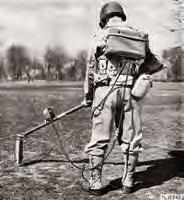

The ANS/PRS-1 mine detector was the first mass produced UHF detector. Over 29,000 sets were produced. Intended to overcome the increasing problem of low metal content mines, the detector was not a success and was soon withdrawn from operational service. Image TM 11-1151. Courtesy of War Department, US Government.
63 ISSUE 28.1 | WINTER/SPRING 2024

THE JOURNAL OF CONVENTIONAL WEAPONS DESTRUCTION 64

65 ISSUE 28.1 | WINTER/SPRING 2024
with a 2004 US military study stating that an MDD was a means to “produce a highly sophisticated and versatile extension of a soldier’s own senses.”111 Research in 1977 compared MDDs with searchers equipped with the AN/ PSS-11 EMI detector. The results were mixed. It was found that experienced soldiers with AN/PSS-11 outperformed MDDs when searching for M-15, M-16, and M-18 mines with high metallic content but that MDDs were superior when searching for minimum metal M-14 and M-19 mines. While the AN/PSS-11 detector notably outperformed MDDs during winter testing when there was snow on the ground, in general it also had “a false alarm rate much greater than that for the dogs.”112
Today, dogs are still used by both military and humanitarian demining and EOD teams. In 2011, Lt. General Michael Oates of JIEDDO still believed that dogs combined with handlers were amongst the best means of detection available to the US military113 High assurance search dogs became an important tool in the counter-IED
PRODDING AND FULL EXCAVATION
While rudimentary, the detection problem still leads to the most basic methods being employed, at least for mines: prodding and full excavation. Prodding was recently one of the first detection techniques used and was widely employed during post-war clearance, often resulting in significant casualties when clearing sensitive pressure devices such as AP Schumines.118 One 1946 US military review of metal detector technology stated that the “effectiveness” of prodding “was the major reason for discarding a number of mine detector developments” during the war.119 In an Infantry conference in Fort Benning in the same year it was stated that “the most satisfactory means of tactical mine removal presently available for infantry troops is probing, hand removal of mines.”120 Sixteen years later in 1962, a UK Royal Engineers pamphlet stated that “prodding is a slow and laborious process, but it is the only method capable of detecting all types of mine buried at normal depths; it has therefore become the standard method of detecting mines.”121
Prodding remained an accepted military detection technique for decades. In Bosnia and Herzegovina in 1994, the British Army taught prodding for shallow mines and
effort. Some demining organizations remained skeptical, with one claiming that in Herat, Afghanistan, in 2015, a number of accidents resulted from mines missed by dogs.114 “MDD have a poor record in Afghanistan for clearing AVM. They were used in Jebrail in Herat Province where minimum metal mines were missed. Although numerous reasons have been identified for the mines being missed, the environmental conditions in Afghanistan are challenging for MDD and tests have shown that their performance can be inconsistent.”115 For this reason, while MDDs are still deemed to have an important role, as in the 1940s, they are not the solution to the detection problem, but one more tool amongst others. As a US Army Engineer report concluded after a visit to the British War Dog Training Centre in March 1945, “no dog can guarantee to work perfectly at all times.”116 Six decades later in 2004 another US military report concluded that, “MDDs are not a stand-alone system for conducting mine clearance operations.”117

the employment of detectors only for mines suspected to be deeper.122 The technique can still be taught as a last resort for those who might inadvertently find themselves in a mined area. More recently prodding has been questioned as an advisable method due to the risk of inadvertently initiating pressure operated AP mines and the limited depth of effective search it provides.123 Stones and roots will provide frequent false positives. Prodding was used in the Falkland Islands for searching some AV only minefields. However, as a means of area clearance, it has largely been overtaken by full excavation, especially if the use of EMI detectors is not deemed practical due to high levels of metal contamination or laterite soil.124 It can also be used during individual target investigation. If the explosive hazard is relatively small, such as associated with AP mines, and the ground is sandy, rakes may be used to conduct full excavation. While there is a risk of initiating items during the process of raking, the distance between the deminer and any detonation, combined with personal protective equipment that conforms to standards, makes the consequences of such an AP blast mine detonation less severe.
VISUAL DETECTION
It might be argued that the best detector over the past eight decades has been the human eyeball combined with cognitive ability to interpret what is being seen.
Consistently, both anecdotal evidence and such limited data that has been collected tends to point to the enduring, albeit limited effectiveness of human vision combined
THE JOURNAL OF CONVENTIONAL WEAPONS DESTRUCTION 66

with knowledge of VOED indicators. Various electronic detectors such as EMI, GPR, or dual sensors have played a role, as have MDDs, but all rely on a combination of human vision and cognition. “Even with all the investments in detection technology, an observant human eye detects the vast majority of IEDs” (of those detected).125
The relative effectiveness of visual detection has been appreciated since the 1940s. In February 1945, No.2 Dogs Platoon Royal Engineers were tasked to search a suspected minefield in the Netherlands. Over three days, the platoon found 112 picric pots, (a German improvised mine). However, another 433 were visually identified by handlers or other sappers. While it was also true that the dogs had not been trained on picric scents, in the task report the Platoon Commander noted that “only signs, visible mines and knowledge of pattern saved handlers from treading on mines.”126 The officer commanding the attached Royal Engineers Field Company believed that the ability to recognize the pattern from visual cues made his men 50 percent more efficient than the dogs at finding mines.127 This was consistent with experience from earlier in the campaign.128 A 1963 US military manual stated that “visual detection is one of the best and most effective methods of locating mines embedded in most types of soils. Indications of buried mines are disturbed soil, piles of stones, debris from mine packaging, and often enemy minefield markers.”129
The primacy of visual detection was emphasized repeatedly during the Vietnam War. A 1969 US Marine Corps analysis stated that “although a great many detection means, ranging from intricate electronic devices to specially trained dogs, have been developed, experience has shown that an alert marine, aware of what to look for and where to look, is the most effective detection device.”130 A 1969 9th Infantry Division study of both mines and booby traps stated bluntly that “almost all of the booby traps are detected visually. Very few, less than one percent, have been detected as a result of informants or scout dogs. Therefore, men should be constantly on the alert, eyes focused and searching ahead of the line of march. In this respect training is of vital importance to new men in-country prior to gaining the experience that comes only with being in the rice paddies.”131 A 1974 post-war study estimated that 60 percent of mines and booby traps detected in Vietnam were “by visual or related means.”132 Another 1974 analysis claimed that “reliance on perceptual detection of mines
by man is empirical fact. Reports from South Vietnam and previous conflicts indicate that 70 to 80 percent of all mine detections are attributable to unaided personnel.”133 The British, analyzing the “urgent” problem of nuisance mining in Aden in the mid-1960s recognized that they relied on visual sweeps to initially detect mines on routes.134
Between 1973 and 1974, recognizing how during the Vietnam War mine and booby traps caused high casualties and limitations on how ground troops maneuvered,135 the US Army engaged the Human Resources Research Organization to research how troops found such devices using their own senses. Seventy-eight individuals were tested and it was believed that tests showed “detection expertise probably is an acquired skill rather than an aptitude-orientated skill.”136,137 Subjects indicated that while they would prefer other detection means such as metal detectors and MDDs, they would see these as “supplements rather than substitutes for visual detection.”138 Tests in 1974 indicated that color and shape, along with quality of camouflage, were important factors in determining the visual detection of devices.139 The US military conducted further tests in 2008 to try to understand what visual cues were perceived by subjects known to have a level of expertise concerning a mine threat. Of note was how “expert perceivers” noticed changes in soil structure.140
In October 2009, General Thomas Metz, the head of JIEDDO, testified to the US House of Representatives Committee on Armed Services that “both inherent traits and experience-related characteristics proved essential to IED detection performance. Our results suggest that IED detection is largely a cognitive task, relying on visual, attentional, and memory processes. One significant finding that emerged indicates certain hobbies are relevant to successful IED detection. Specifically, participation in hunting, puzzles, art, and music predicted superior performance, as did time in service, deployment experience, and age.”141 In 2011, the US military conducted research into “perceptual learning to improve the visual detection of IEDs.”142 How much such skills are related to natural aptitude and how much they can be acquired remains unclear. In any case, in November 2012, a US Army research laboratory article stated that “despite its investment in millions of dollars’ worth of sophisticated technology, U.S. Army’s researchers say visual detection is the primary means of discovering Improvised Explosive Devices.”143 In 2007, one
Essentially, visual detection combined with knowledge entails an individual making a form of qualitative risk assessment on the ground.
67 ISSUE 28.1 | WINTER/SPRING 2024
journalist claimed that “soldiers who once spotted few roadside bombs in Iraq now detect more than half before detonation. The ‘Mark 1 Human Eyeball,’ as troops sardonically call it, is more adept at finding IEDs than any machine.”144 Much of the training of those in threat environments concentrated on increasing their perception to improve visual detection of IEDs,145 often through courses such as Ground Sign Awareness.146 Even in 2020, one HMA organization stated that “visual detection is one of the primary techniques to identify IEDs in any environment.”147
It is possible that a sensor technology will prove to be a viable solution to the detection problem. Research to this end continues. However, if it is accepted that vision combined with cognition remains a significant albeit limited element of detecting some VOEDs, practically developing that cognition should be a priority. What this entails is better informed personnel on the ground who can more often successfully interpret what they see. This means equipping those individuals with contextual knowledge
based on evidence rather than intuition or anecdote. In order to provide that contextual knowledge as accurately as possible, it is necessary to actively gather as much relevant operational data as practicable. The significance of a given visual cue can be better calculated if the number of times it has previously indicated the presence of a VOED is recorded. Essentially, visual detection combined with knowledge entails an individual making a form of qualitative risk assessment on the ground. That risk assessment should not only be informed by personal experience, but also by quantitative data. For example, mines being frequently placed on verges or near culverts might be believed to be true due to personal experience or anecdote, but it is better if based on operational location data that has been carefully collected over time. As with other means of detection, routinely recording and analyzing how previous mines were found can better inform future efforts.
UNEXPLODED ORDNANCE DETECTION, DISCRIMINATION, AND CLASSIFICATION
Related to the problem of detecting VOEDs is the more general problem of detecting unexploded ordnance (UXO).148 The base closures in the United States at the end of the Cold War led to greater prominence of the issue of removing UXO.149 Detecting UXO with high metal content was possible depending on the size and depth of target. However, discriminating UXO from metal “clutter” and other issues such as the “geological noise originating from magnetic soils”150 meant that the number of false positives made clearance expensive and slow. Increasing the sensitivity of EMI sensors to find smaller items at greater depth also resulted in a greater FAR.151 Magnetometers were also widely employed and remain useful for large items that are deeply buried. However, the recorded magnetic data has limitations on measuring the size and shape of a target and therefore magnetometers are not suitable for most discrimination purposes.152
The inability to discriminate UXO from clutter and the clearance costs this entailed was referred to as “one of the Department of Defense’s (DOD) most pressing environmental problems.”153,154 Significant research and development efforts have enabled some degree of Advance Geophysical Classification (AGC) of UXO, dependent on multi-axis sensors rather than the single-axis sensors associated with demining.155 The former required a number of EMI sensors arranged in an array. These measured
A searcher uses a VMXC1 detector to search for explosive submunitions. Even explosive ordnance (EO) with high metal content is difficult to practically find in areas of high metal contamination, such as a cluster strike. Discrimination of EO from false positive signals is an ongoing challenge that often results in relatively slow clearance rates. Courtesy of Roly Evans.
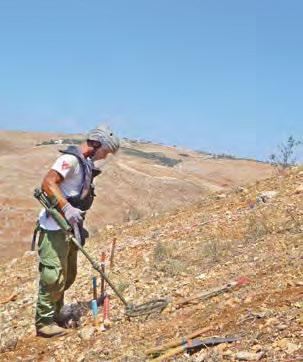

THE JOURNAL OF CONVENTIONAL WEAPONS DESTRUCTION 68
the polarizability of a target; that is the electric dipole moment in proportion to the electric field applied. This could be recorded and act as a reference for future comparison.156 To a degree this allowed discrimination between scrap metal and UXO although the results should not be overstated. The real result was a reduction in the number of false positive signals to be investigated157,158 in a way analogous to the use of dual sensors searching for AP mines in Cambodia.159 AGC is not applicable for mines with little or no metal content. The potential wider application to mined areas is also limited due to the need to remove excessive vegetation prior to the sensors covering the ground,160 even if the sensors are mounted on an unmanned aerial vehicle (UAV).
While AGC has assisted in the removal of UXO from contaminated sites in the United States, it should not be seen as a silver bullet. One impediment is the aging of EO causing change in the polarization of items to such an extent that they cannot be classified. Partial UXO fragments that don’t conform to a pre-recorded signature but nevertheless still represent an explosive

hazard are also a problem. Any artificial intelligence (AI) processing of signatures depends on comparison with a predefined library of polarizability signatures.161 Presently such databases are in their infancy. The creation of such databases for EO initially requires a human to excavate and confirm visually what each signal represents. For UXO in the United States, the lack of signature data to inform operators of what they are looking for on a given range, especially for munitions that did not graduate into production, remains a significant impediment.162 The need to develop a dataset of target signatures for comparison is clear. Any technological advances to enable discrimination and classification of targets, whether it is UXO or VOEDs such as AP mines, depends on developing such a dataset. This requires data entry by clearance operators to confirm not only the identity but also other relevant information about each item of EO. Progress on the longstanding detection problem, both in technological and operational risk management terms, may be said to depend on the collection of operational data.
OTHER ATTEMPTS AT TECHNOLOGICAL SOLUTIONS
Aside from EMI detectors, and use of GPR and MDDs, many research attempts at solving the detection problem have been attempted over the past eight decades. In the mid-1960s, the British Army conducted airborne trials in Salisbury Plain, Borneo, and Aden. The trials, known as Operation FRICTION, used infrared systems called Linescan and Side Looking Airborne Radar (SLAR). The trials showed that identifying individual mines was impracticable and identifying patterns was only possible in certain circumstances if a survey of the area prior to the emplacement of a minefield was available for comparison.163 Minefields that were overgrown by vegetation, as is often the case, could not be detected by these means.164 (Vegetation is a stubborn impediment for all sensors mounted on piloted aircraft or UAVs.) The trials were deemed urgent since “in South Arabia there is a persistent and serious threat from dissident mining” causing significant military and civilian casualties. The existing methods used were “handheld detectors or visual sweeps. These methods are slow, inaccurate and unsuitable for covering long distances.”165 Today, the military use a technique called Coherent Change Detection (CCD) that compares time lapsed high resolution satellite or UAV images to try to identify relevant change.166 While a useful tool, the technique applies more to a changing tactical environment rather than long-term contamination.
Use of thermal imaging as a tool to potentially indicate explosive devices concealed in the environment continues to the present, whether as a tool to try to identify IEDs on military operations,167 or as a means of identifying mines in desert environments.168,169 The use of thermal imaging, while having a degree of utility in certain environments, has yet to show potential as a reliable means of detection in all environments.
Use of acoustic waves was subject to research in the 1940s170 and in 1973, the need for a means of detection that “does not depend significantly on the materials from which the mines are constructed” was identified.171 Seismo-acoustic methods work by detecting vibrations in a device that are generated and received by a pair of transducers. Tests showed that a 3 KHz signal reflected from simulated mines down to 12 inches.172 More modern efforts use a frequency range of 50 Hz to 1KHz.173 However, the technology required a vehicle mounting, limiting its practical use. It has also been deemed more suited to AV mines rather than smaller AP mines.174 For a time, Nuclear Quadrupole Resonance techniques were deemed as having potential by means of directly identifying the nitrogen molecules used in common explosives such as RDX. Identifying TNT proved more difficult, as did metal encased mines.175 Development of this chemical analysis technique is still being attempted today in Colombia, but
69 ISSUE 28.1 | WINTER/SPRING 2024
even in test conditions the claimed range a substance can be detected is only 3cm.176 Recent efforts on the related magnetic resonance technology have not progressed to independently verified field trials.177
In the absence of reliable means to detect and discriminate devices, sometimes detection by detonation has been employed. Rollers have been used on routes since the Second World War,178 with limited success due to uneven ground and the potential orientation of the means of initiation of the VOED.179,180 Flail attachments have been deployed as a means of detection by detonation since 1942, but also depend on the orientation of the mine and the condition of its fuzing system. Flails can also struggle in uneven or steeper ground and can throw items rather than initiate them.181 Soldiers have also resorted to throwing drag weights on pull lines to try to detect trip wires in Vietnam.182 In both Iraq and Afghanistan, it was realized that it was easier to detect the human being emplacing a VOED than the device itself, and this became a recognized method of IED detection.183
THE APPROACH TO THE PROBLEM
In December 1978, the First Meeting of the Expert Working Group (EWG) on Minefield Detection was held in the United States. In attendance were the US Army’s Mobility Equipment Research and Development Command (MERADCOM), Environmental Research institute of Michigan (ERIM), and the defense company Braddock, Dunn, and McDonald (BDM). The participants recognized that “the function of the Expert Working Group is to provide broad technical and operational guidance on the mine detection research effort. The EWG should determine that the problem to be solved is realistically understood and assessed, that the effort is accurately directed toward this problem, and that no significant aspect of the problem is being overlooked.”190 The working group did not last, and the problem was not solved. Unfortunately, the approach outlined did not describe the overall approach to the problem over the last eight decades. Often it is not well defined, with much research wasted for lack of a true appreciation of realities in the field.191,192 For example, vehicle-based sensors limit the practical application of any system since even tracked vehicles have limited mobility over much of the terrain where landmines are found, and yet such sensors are still promoted as practical solutions.193
In 1996, the US General Accounting Office (GAO) identified significant failings with the US Army procurement of its mine detectors. After a process that considered
Sometimes means other than detection have been used to try to reduce the risk from potential contamination. In Vietnam, the US military routinely bombarded landing zones prior to infiltration to try to reduce the risks from mines and booby traps.184 Fuel Air Explosive was used to clear not only any vegetation, but also any pressure initiated VOEDs.185 Minefield breaching operations still use explosive line charges projected into an area to at least partially clear a path.186,187 These might be supplemented by a mine plough that shifts any potentially contaminated earth away from a breaching lane. Such charges were even used during counter insurgency operations in Sangin, Afghanistan, in 2010.188 During the post-conflict clearance in the Falkland Islands, such was the difficulty of the detection problem that consideration was given in late 1984 to the use of Fuel Air Explosive to clear areas of land and therefore bypass the difficulties of detecting minimum metal mines.189 Trials were conducted in Canada but the technique was never tried on the Falkland Islands.

twelve candidate pulse induction and continuous wave EMI devices, a model from the Austrian manufacturer Scheibel GmbH was selected in December 1991 and designated AN/PSS-12. The GAO subsequently remarked that Scheibel did not perform well during testing against low metallic targets but was selected on price considerations. The testing itself was deemed inadequate. Since no candidate detector could detect low metal targets, steel content was added to targets in order to pass the test.194 The remarkable aspects of this are not necessarily the questionable procurement process. What was notable was that the continuing “detection problem”195 was essentially ignored, partly, it might be assumed, because there was no real answer. The detector was fielded on the basis that it could detect a range of mines, including those with low metal content, but practically it could not. Ultimately the AN/PSS-12 would be the subject of significant redesigns to try to improve its performance. These included a new algorithm and hardware to try to increase discrimination performance to discern clutter from positive signals.196 Even today some EMI detectors are marketed as being “capable of detecting all currently deployed minimum metal AP and AT mines.”197,198
While there was an understandable focus on minimum metal mines, the truth was and remains that in conditions of metal contamination, which are inevitable in areas where
THE JOURNAL OF CONVENTIONAL WEAPONS DESTRUCTION 70
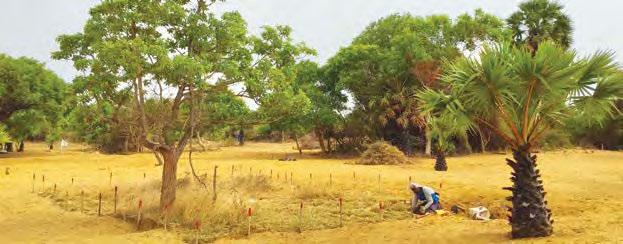
combat has taken place, reliably discriminating all items of EO, regardless of metal content, is not currently possible. This fundamental aspect of the problem has been known about for years but has not necessarily been appreciated when it came to detection research efforts. In Vietnam, booby traps incorporating significant metal content for explosive fragmentation effects were the biggest problem for US ground troops. A leaflet distributed to 9th Division Troops in May 1969 stated that “in April 1969, 41% of the 9th Division soldiers killed in action, and 63% of those wounded were casualties from booby traps. Booby traps are the single most important casualty producer in the 9th Division area.”199 Of the booby traps themselves, an earlier assessment noted that 71.3 percent used a grenade, and another 11.8 percent used an artillery projectile or mortar round, usually initiated by a tripwire. All these are items of EO with significant metal content. 200 This is not to say that minimum metal mines, referred to as plastic mines, were not a challenge. The same 9th Infantry Division noted in 1968 that “new enemy techniques encountered were the increased use of hard to detect plastic mines in place of metal mines and the construction of numerous small roadblocks in clusters. Within each cluster, several are booby trapped. Since any of them might be rigged, each one has to be painstakingly cleared which increases the time expended opening the road.”201 Regardless of metal content, detection of mine and booby traps remained a problem. For the calendar month of April 1969 in the 9th Division TAOI, 202 only 1.6 percent of mines and booby traps were detected by metal detectors. 203 The figure for May 1969 was even lower at 0.3 percent. 204 For a three-month period (March to June) in 1968, metal detectors found 3.9

percent of identified booby traps, whereas 40.9 percent were identified visually and 51.3 percent were identified through detonation, and hence too late. 205
The detection problem has been partially recognized, albeit perhaps obliquely, by international treaty. The 1996 Amended Protocol II of the Convention on the Use of Certain Conventional Weapons required that AP mines must be detectable using commonly available mine detection equipment, which effectively banned minimum metal mines. 206 The convention was only enforceable for states that were high contracting parties to it. Today this totals 106 countries. 207 While effectively trying to ban minimum metal mines, the overall problem of detecting all AP mines in operational conditions, regardless of metal content, would only be addressed by an outright ban of victim operated AP mines brought about by the 1997 Anti-Personnel Mine Ban Convention 208 One hundred and sixty-four states are party to the Convention. 209
In November 1996, Major General Clair Gill, commanding the Engineer Center at Fort Leonard Wood, stated to a symposium on technology and the mine problem that “in the very near future, anyone that would bury a container filled with explosives should have the absolute certainty that it will be found and neutralized with little effort and at no operational expense by U.S. ground forces. With detection and neutralization so easy and certain, I’m confident that the threat of the landmine will wither away.”210 Despite this optimistic prediction, the United States would begin the conflicts in Afghanistan and Iraq with “mine detection capabilities that are limited and largely unchanged since the Second World War.”211 In April 2001 it was again noted that not only did the detection problem persist but that
Full excavation of heavily contaminated ground in Sri Lanka. This slow, deliberate technique demonstrates that challenges to detect and discriminate AP mines remain an ongoing problem. Courtesy of Roly Evans.
71 ISSUE 28.1 | WINTER/SPRING 2024
the approach to the problem remained inadequate. A GAO report asserted that the Department of Defense lacked “an effective strategy for identifying and evaluating the most promising technologies.”212 Notably the report recommended that evaluation of “all applicable land mine detection technologies against a complete set of missionbased criteria, such as target signatures, operational requirements and expected environmental conditions.”213 In short, research should be applicable to the problem as it was experienced in the field. Despite this observation, a US military doctrine of assured mobility evolved over the 2000s. “Assured mobility is the framework of processes, actions, and capabilities that enable the joint force to deploy and manoeuvre where and when desired, without interruption or delay, to accomplish the mission.”214 When viewed through the lens of coalition experience in Afghanistan and Iraq, it is not clear whether such a doctrine was practically achievable, or based on a sufficient understanding of the problem, given the ongoing difficulty in detecting and discriminating victim operated IEDs.
While research and development (R&D) efforts to find a technological solution will and of course should continue,
POSSIBLE AREAS OF DEVELOPMENT
Many attempted detection research efforts have sought to remove the human from hazardous areas during the process of searching for mines, booby traps, and victim operated IEDs. Historically, armored vehicles were employed as platforms for sensors, and these vehicles progressively became remotely operated. More recently, UAVs have been widely employed, with increasing attempts to mount a range of sensors and analyze a fusion of the results. Unfortunately, these efforts have two fundamental impediments. Firstly, mined areas are often, at least in temperate or tropical environments, covered with vegetation that will be a key impediment for EMI, GPR, infrared and even LIDAR sensors. If the topography permits, such vegetation can be removed by a machine, although often it is removed by a deminer. The second impediment is that regardless of the sensor employed, and the means by which it is employed (UAV, armored vehicle, deminer), the identity of a sub-surface signal can only be ascertained by a deminer excavating it. A sensor might
CONCLUSION
In terms of detecting and discriminating VOEDs, the last eight decades may be seen as largely a history of failure, or at least one of insufficient success. 215,216 Many technological
the difficulty of the problem should always be clearly understood. To accurately identify different substances in the ground is more of a scientific challenge than many might realize. The real requirement is for a sensor that can not only reliably detect VOEDs and discriminate them from false positives, but also work in a range of environmental conditions, including levels of vegetation and soil types. For VOEDs, such sensors should be reliable down to typical search depths (perhaps 20–30cm). Those seeking to engage with the problem should understand that they are attempting to find a solution that has eluded considerable efforts over more than eight decades, including extremely well-funded efforts conducted as a very high priority during conflict. R&D projects should resist the temptation to overclaim perceived future success, even though the need to attract funding may explain such marketing. Any R&D project seeking funding should clearly outline how their technology will engage with the problem as it is experienced by clearance organizations in the field, and also why this particular technology has the potential to succeed where so many attempts in the past have come up short.
indicate the potential presence of an AP mine but only a deminer can excavate it to provide final confirmation. No sensor can categorically identify which signals may be ignored and which merit excavation; therefore, deminers will continue to be restricted to slow, deliberate searching of ground, even if the false positives investigated may to some extent be reduced by dual EMI and GPR detectors. What could overcome this problem is the development of a database of signatures of the range of VOEDs for a range of sensors. However, in order to develop such a database, clearance organizations will have to systematically record not only the signature of every hazard found for a given sensor, the settings of that sensor, the details of the explosive hazard, and the environment it was found in, but also the equivalent detail for false positive signatures. The road to AI rapidly discerning whether a given signal is a real device or not possibly runs through the laborious collection of signatures against which any new signal can be compared.

solutions have been proposed, but all have struggled to perform in operational conditions where the challenge is not only to detect an object by its metal content, differing
THE JOURNAL OF CONVENTIONAL WEAPONS DESTRUCTION 72
density to the surrounding soil, chemical composition, or heat signature, but also to discriminate it from other false positives that may be detectable, such as scrap metal, rocks, etc. The detection problem is not limited to mines with low metal content, although this is perhaps its most acute aspect. Even EO such as a mortar round with easily detectable metal content is often difficult to practically find when concealed beneath the surface, not because it is hard to detect, but because it is hard to discriminate from much else. In military scenarios, detection has remained a form of mitigation since it is only ever partially effective. In humanitarian scenarios, the lack of time constraints means that while detectors have a significant, arguably crucial role to play, their effectiveness remains limited to such an extent that clearance of land is slow and laborious, and often the clearance solution remains the least technological: full excavation of ground.
In 1971, the Assistant Division Commander of the 1st Marine Division concluded after their two-year deployment in Vietnam that “the 1st Marine Division’s strenuous efforts – including troop indoctrination, land mine warfare school, contact teams and mine and booby-trap dogs – did not solve the problem. The best we can conclude is that these efforts greatly reduced what might have been the casualty figures if they had not been vigorously pursued.”217 Today, as in 1971, mine detection technology, combined with


other procedural forms of mitigation such as training, can only achieve so much. Technological R&D might assist, but so far has produced no silver bullet. The detection rate for concealed IEDs in Afghanistan remained at approximately 50 percent, despite the huge investment by JIEDDO since 2006. 218 Until a technological solution can be found, the question remains how to make such mitigation as effective as possible. Finding and destroying concealed VOEDs is a risk activity, and conducting such activity with the limited detection capabilities currently available emphasizes the risk management characteristic further. If the ISO definition of risk as the effect of uncertainty on objectives is accepted, concealed VOEDs represent an acute uncertainty that has affected both military and humanitarian objectives. 219 Therefore, in the absence of a comprehensive technological detection solution, more effort may be placed on enhanced risk management approaches to mitigate the risk as best as practicable. Such approaches should inevitably be based on the collection of as much accurate operational data concerning VOEDs as practicable, including not only their identity and characteristics but also how and where they were found and destroyed. Such an approach does not represent any sort of a complete solution, but it is an available means of reducing uncertainty, and better managing risk.
See endnotes page 77
ROLY EVANS
Cranfield University
Roly Evans has worked in the fields of survey, clearance, EOD, and physical security and stockpile management in Africa, Europe, the Middle East, South Asia, and Southeast Asia and is conducting research on mine action operations. He holds an MSc in Explosive Ordnance Engineering.
TRACEY TEMPLE, Ph D
Cranfield University

Professor Tracey Temple began her career in the RAF and then went on to study as a mature student where she graduated from Queen's University, Belfast (2002) with an Honour’s degree in Geography (2002) and later a Master of Science in Rural Development and Project Management (2004). In 2017, Temple completed her PhD at Cranfield University in the fate and transport of explosives in the environment.
LIZ NELSON
Cranfield University

Lt Col (Retd) Liz Nelson is a lecturer in Explosives Technology and Safety at Cranfield Defence and Security, Defence Academy of the United Kingdom. She is also the CDS Explosives Safety Advisor. Lt Col Nelson has over thirty years’ experience related to ordnance, munitions, and explosives safety and technology from her time as an Ammunition Technical Officer in the British Army. She has a Master of Science from Lincoln University and joined Cranfield University in September 2022.
73 ISSUE 28.1 | WINTER/SPRING 2024
ENDNOTES
Localization in Mine Action: Where the Possible Meets the Necessary by Schindler [ from page 4 ]
1. Initiated at the World Humanitarian Summit (WHS) in Istanbul in 2016, the Grand Bargain “is a unique agreement between some of the largest donors and humanitarian organisations who have committed to get more means into the hands of people in need and to improve the effectiveness and efficiency of the humanitarian action.” Inter-Agency Standing Committee: About the Grand Bargain, https://interagencystandingcommittee.org/node/40190
2. “More Support and Funding Tools for Local and National Responders,” InterAgency Standing Committee, https://shorturl.at/atzG1.
3. Robillard, Sabina, Teddy Atim, Daniel Maxwell, “Localization: A ‘Landscape’ Report,” Feinstein International Center Tufts University, 2021, 13–14, https://shorturl.at/cgtFP
4. “Localisation Factsheet,” European Civil Protection and Humanitarian Aid Operations, https://shorturl.at/tvwBT
5. The 2016 Grand Bargain set the goal of providing 25 percent of global humanitarian funding to local and national responders. However, “direct funding to local and national actors, as a share of total humanitarian assistance, remained static at 1.2 percent in 2022.” Development Initiatives, 2023. Global Humanitarian Assistance Report 2023, p. 73. Available at: https://shorturl.at/gmvAX
6. Robillard, Sabina, Teddy Atim, Daniel Maxwell, “Localization: A ‘Landscape’ Report,” Feinstein International Center Tufts University, 2021, 22, https://shorturl.at/ABNQT
7. “Iraq Programme Report 2021,” UNMAS, 2021, 18, https://shorturl.at/lpIUV.
8. “Localization Examined: ICAV Briefing Paper,” September 2018), 9, https://shorturl.at/vOSXZ
9. “Oral statement to Parliament: Prime Minister’s statement to the House of Commons,” GOV.UK, June 2020, https://shorturl.at/ACLRV.
10. El Taraboulsi-McCarthy, Sherine, Victoria Metcalfe-Hough, and Barnaby Willitts-King, “Foreign Policy and Humanitarian Action: An Agenda for Inquiry,” Overseas Development Institute, November 2016, https://shorturl.at/CDFG3
11. Wilkinson, Mark, Albert Schevey, and Ahmed Al Zubaidi, “The Bigger Picture: Considerations Toward the Sustainable Localization of Mine Action,” The Journal of Conventional Weapons Destruction 27, no. 1 (2023): 47–48, https://shorturl.at/ikvTX
The Mine Action Trauma Care Collaborative:
Enhancing Coordination between Humanitarian Mine Action and the Emergency Health Response to Civilian Casualties of Explosive Ordnance by Wild, Loupforest, Persi, Hottentot, Kasack, Alizada, International Blast Injury Research Network, Kushner, and Stewart [ from page 12 ]
1. Wild, Hannah, Barclay T. Stewart, Christopher LeBoa, Christopher D. Stave, and Sherry M. Wren, “Epidemiology of Injuries Sustained by Civilians and Local Combatants in Contemporary Armed Conflict: An Appeal for a Shared Trauma Registry Among Humanitarian Actors,” World Journal of Surgery 44, no. 6 (2020): 1863–1873, http://tinyurl.com/yc8xhdtu
2. Young, Katherine, Chiara Torelli, Helen Buck, and Christina Wille, “2021–2022: Two Years of Harm to Civilians from the Use of Explosive Weapons,” Explosive Weapons Monitor, 24 April 2023, http://tinyurl.com/mawxyna3
3. Debarati, Guha-Sapir, Benjamin Schlüter, Jose Manuel Rodriguez-Llanes, Louis Lillywhite, and Madelyn Hsaio-Rei Hicks, “Patterns of Civilian and Child Deaths Due to War-Related Violence in Syria: A Comparative Analysis from the Violation Documentation Center Dataset, 2011–2016,” The Lancet Global Health 6, no. 1 (2018): 103–10, http://tinyurl.com/3nk4rbrh
4. United Nations General Assembly, Seventy-Eighth Session, 31 July 2023, http://tinyurl.com/mwhkzzwv
5. Oh, John S., Creighton C. Tubb, Thomas P. Poepping, Paul Ryan, Jonathan C. Clasper, Adrian R. Katschke, Caroline Tuman, and Michael J. Murray, “Dismounted Blast Injuries in Patients Treated at a Role 3 Military Hospital in Afghanistan: Patterns of Injury and Mortality,” Military Medicine 181, no. 9 (2016): 1069–1074, http://tinyurl.com/45eajrvn
6. Pizzino, Stacey, Michael Waller, Vivienne Tippett, and Jo Durham, “Mortality from Landmines and Explosive Hazards: Findings from a Global Epidemiological Analysis,” Prehospital and Disaster Medicine 38, no. S1 (2023): S191, http://tinyurl.com/55cnhdu5
7. Edwards, Mary J., Michael Lustik, Terri Carlson, Benjamin Tabak, Douglas Farmer, Kurt Edwards, and Martin Eichelberger, “Surgical Interventions for Pediatric Blast Injury: An Analysis from Afghanistan and Iraq 2002 to 2010,” The Journal of Trauma and Acute Care Surgery 76, no. 3 (2014): 854–8, http://tinyurl.com/ashk6683.
8. “Health and Protection Joint Operational Framework,” Health Cluster, 13 April 2023, http://tinyurl.com/39u2kw55
9. “13.10 Victim Assistance in Mine Action,” IMAS, 17 January 2023, http://tinyurl.com/bddbdjfz
10. Oslo Action Plan, Final Plenary Meeting, 29 November 2019, http://tinyurl.com/vacdxz2d
11. “A Guidance Document for Medical Teams Responding to Health Emergencies in Armed Conflicts and Other Insecure Environments,” World Health Organization, 2021, http://tinyurl.com/3jm5np3s
12. Tadesse, Lia, Noor Hisham Abdullah, Heitham Mohamed Ibrahim Awadalla,
Scott D’Amours, Ffion Davies, Niranjan Kissoon, Wayne Morriss, Bisola OnajinObembe, and Teri Reynolds, “A Global Mandate to Strengthen Emergency, Critical and Operative Care,” Bulletin of the World Health Organization 101, no. 4 (2023): 231–231A, http://tinyurl.com/yzuu4j6b
13. Wild, Hannah, Adam Kushner, Christelle Loupforest, and Barclay Stewart, “Lessons From Mine Action: Integrated Care for Civilians in Conflict,” The Lancet 402, no. 10411 (2023): 1416–17, http://tinyurl.com/mjcsw8fp
14. Reynolds, Teri A., Barclay Stewart, Isobel Drewett, Stacy Salerno, Hendry R. Sawe, Tamitza Toroyan, and Charkles Mock, “The Impact of Trauma Care Systems in Low- and Middle-Income Countries,” Annual Review of Public Health 38, (2017): 507–532, http://tinyurl.com/4ymamvhb
15. “The Trauma Pathway From A to Z,” World Health Organization, http://tinyurl.com/yyddzu3w
16. “WHO Emergency Care System Framework,” World Health Organization, 2 May 2018, http://tinyurl.com/ymxcfa2m
17. Merchant, Amina, Malena Outhay, Lazáro Gonzaléz-Calvo, Troy D. Moon, Mohsin Sidat, Catia Luciana Abdulfattáhe Taibo, and Kelly McQueen, “Training Laypersons and Hospital Personnel in Basic Resuscitation Techniques: An Approach to Impact the Global Trauma Burden in Mozambique,” World Journal of Surgery 39, (2015): 1433–37, http://tinyurl.com/5exr2wz8
18. Boeck, Marissa A., Tyler E. Callese, Sarah K. Nelson, Michael B. Shapiro, Nabil M. Issa, and Mamta Swaroop, “The Development and Implementation of a Layperson Trauma First Responder Course in La Paz, Bolivia: A Pilot Study,” International Journal of the Care of the Injured 49, no. 5 (2018): http://tinyurl.com/bdhajk37
19. Eisner, Zachary J., Peter G. Delaney, Alfred H. Thullah, Amanda J. Yu, Sallieu B. Timbo, Sylvester Koroma, Kpawuru Sandy, Abdulai Daniel Sesay, Patrick Turay, John W. Scott, Krishnan Raghavendran, “Evaluation of a Lay First Responder Program in Sierra Leone as a Scalable Model for Prehospital Trauma Care,” Injury 51, no. 11 (2020): 2565–2573, http://tinyurl.com/y3kc8nc4
20. Kushner, Adam, “The Mine Injury and Trauma Seminar: A Way to Save Lives,” The Journal of Conventional Weapons Destruction 11, no. 1 (2007): 61–3, http://tinyurl.com/bdhax5ar
21. Butler, Frank K, “Tactical Combat Casualty Care: Update 2009,” The Journal of Trauma and Acute Care Surgery 69, no. 1 (2010): S10–S13, http://tinyurl.com/bdws3mx6
22. Howard, Jeffrey T., Russ S. Kotwal, Caryn A. Stern, et al, “Use of Combat Casualty Care Data to Assess the US Military Trauma System During the Afghanistan and Iraq Conflicts, 2001-2017,” JAMA Surgery 154, no. 7 (2019): 600–608, http://tinyurl.com/pmp69zyx
23. 2Lei, Roy, Michael D. Swartz, John A. Harvin, Bryan A. Cotton, John B. Holcomb, Charles E. Wade, Sasha D. Adams, “Stop the Bleed Training Empowers Learners to Act to Prevent Unnecessary Hemorrhagic Death,” The American Journal of Surgery 217, no. 2 (2019): 368–72, http://tinyurl.com/au593ar7
24. Husum, Hans, Mads Gilbert, Torben Wisborg, Yang Van Heng, Mudhafar Murad, “Rural Prehospital Trauma Systems Improve Trauma Outcome in Low-Income Countries, A Prospective Study from North Iraq and Cambodia,” The Journal of Trauma and Acute Care Surgery 54, no. 6 (2003): 1188–1196, http://tinyurl.com/mtx9wbpb
25. Murad, Mudhafar Karim, and Hans Husum, “Trained Lay First Responders Reduce Trauma Mortality: A Controlled Study of Rural Trauma in Iraq,” Prehospital and Disaster Medicine 25, no. 6 (2010): 533–39, http://tinyurl.com/55jd7tpy
26. Husum, Hans, Mads Gilbert, Torben Wisborg, Yang Van Heng, and Mudhafar Murad, “Land Mine Injuries: A Study of 708 Victims in North Iraq and Cambodia,” Military Medicine 168, no. 11 (2003): 934–40, http://tinyurl.com/3hhsj94b
27. Wisborg, Torben, Mudhafar Murad, Odd Edvardsen, and Berit S. Brinchmann, “Life or Death. The Social Impact of Paramedics and First Responders in Landmine-Infested Villages in Northern Iraq,” Rural and Remote Health 8, no. 1 (2008): 816, http://tinyurl.com/y8x4x6zt
28. Eisner, Zachary J., Peter G. Delaney, Alfred H. Thullah, Amanda J. Yu, Sallieu B. Timbo, Sylvester Koroma, Kpawuru Sandy, Abdulai Daniel Sesay, Patrick Turay, John W. Scott, Krishnan Raghavendran, “Evaluation of a Lay First Responder Program in Sierra Leone as a Scalable Model for Prehospital Trauma Care,” Injury 51, no. 11 (2020): 2565–2573, http://tinyurl.com/y3kc8nc4
29. Mock, Charles, Michael Tiska, Martin Adu-Ampofo, and Gabriel Boakye, “Improvements in Prehospital Trauma Care in an African Country with No Formal Emergency Medical Services,” The Journal of Trauma and Acute Care Surgery 53, no. 1 (2002): 90–97, http://tinyurl.com/2wzk6x22
30. Olumide, Adesola O., Michael C. Asuzu, Oladele O. Kale, “Effect of First Aid Education on First Aid Knowledge and Skills of Commercial Drivers in South West Nigeria,” Prehospital and Disaster Medicine 30, no. 6 (2015): 579–85, http://tinyurl.com/yc7cenx9
31. “Public Health: Save Lives, Save Limbs: Life Support for Victims of Mines, Wars, and Accidents,” JAMA, 14 February 2001, http://tinyurl.com/yc8hzcr3
32. “Blast Trauma Care: Course Manual,” International Committee of the Red Cross, 13 November 2020, http://tinyurl.com/2e9yjxbe
33. Proctor, Enola, Hiie Silmere, Ramesh Raghavan, Peter Hovmand, Greg Aarons, Alicia Bunger, Richard Giffey, and Melissa Hensley. “Outcomes for Implementation Research: Conceptual Distinctions, Measurement Challenges, and Research Agenda,” Administration and Policy Mental Health and Mental Health Services Research 38, (2011): 65–76, http://tinyurl.com/57kxecxv
34. “05.10 Information Management for Mine Action,” IMAS, 6 March 2023, http://tinyurl.com/yckm9w8n
THE JOURNAL OF CONVENTIONAL WEAPONS DESTRUCTION 74
Surveying Eighty-Year-Old Battlefields in Solomon Islands by Conway [ from page 18 ]
1. Information provided to HALO by the RSIPF in October 2023.
2. Information provided to author by the RSPIF in August 2022.
Emergency Explosive Ordnance Risk Education: Lessons Learned from Ukraine by Vovk [ from page 24 ]
1. The EORE AG was launched in 2019 to draw on the expertise of over a dozen UN agencies, international organizations, international NGOs, and national mine action authorities to provide overall guidance to the sector and identify ways to improve the integration, effectiveness, efficiency, and relevance of EORE. The EORE AG is chaired by UNICEF and currently The HALO Trust. More information on the EORE AG can be found at: https://shorturl.at/nFRU7
2. “IMAS Mine Risk Education Best Practice Guidebook 9: Emergency Mine Risk Education,” UNICEF, November 2005, 8, https://shorturl.at/mFJ27
3. “Ukraine Response Protection Snapshot (2–5 March 2022),” Protection Cluster Ukraine, March 2022, 1, https://shorturl.at/iMU38.
4. “Ukraine: Humanitarian Impact Situation Report,” UN OCHA, April 2022, 2, https://shorturl.at/gqyV0
5. “Ukraine Response Protection Snapshot (10–16 March 2022),” Protection Cluster Ukraine, March 2022, 4, https://shorturl.at/gqyV0
6. “Rapid Needs Assessment: Explosive Ordnance Risk Education–Ukraine,” DRC, June 2022, 11–13, https://shorturl.at/knGKM
7. “12.10 Explosive Ordnance Risk Education (EORE),” IMAS, September 2020, p. 17–18, https://www.mineactionstandards.org/standards/12-10/
8. “IMAS Mine Risk Education Best Practice Guidebook 9: Emergency Mine Risk Education,” UNICEF, November 2005, 8, https://shorturl.at/mFJ27
9. “Emergency Mine Risk Education Toolkit: Emergency MRE Handbook,” UNICEF, July 2008, https://shorturl.at/tGOTZ
10. Laurelle, Matthieu, “What are the Links Between Education in Emergencies and Explosive Ordnance Risk Education?” Inter-Agency Network for Education in Emergencies (blog), August 28, 2023, https://shorturl.at/ikoE6
11. Jones, Abigail, and Edward Crowther, “Provision of Emergency Risk Education to IDPs and Returnees in Ukraine,” The Journal of Conventional Weapons Destruction 20, no. 1 (2016), https://shorturl.at/vxHQ3
12. “Questions & Answers on Explosive Ordnance Risk Education for Ukraine,” EORE AG, Mach 2022, https://shorturl.at/dhsG4
13. “Ukraine: Protection of Civilians in Armed Conflict December 2023 Update,” OHCHR, January 2024, 3, https://shorturl.at/jszDV
14. Colonel Ruslan Beregulia, “Introductory Remarks” (presentation, DRC Lessons Learned Workshop on Emergency EORE in Ukraine, Kyiv, Ukraine, August 2023).
15. “Implementation of Humanitarian Demining: Interactive Map,” NMAA, September 2023, https://shorturl.at/pMS03
16. “Explosive Ordnance Guide for Ukraine–Second Edition” GICHD, 2022, 10–219, https://shorturl.at/axHM5
17. Perederii, Lieutenant, Tony Salvo, and Drew Parker, “Ammunition Identification Guide for Ukraine: A Collaborative Project Amidst War,” The Journal of Conventional Weapons Destruction 27, no. 3 (2023): 30, https://shorturl.at/avGJ2
18. Mathewson, Andro, “Open-Source Research and Mapping of Explosive Ordnance Contamination in Ukraine,” The Journal of Conventional Weapons Destruction 26, no. 1 (2022): 41, https://shorturl.at/gpzM8
19. Schindler, Markus and Anthony Connell, “Mine Action and Food Security: The Complexities of Clearing Ukraine’s Agricultural Lands,” The Journal of Conventional Weapons Destruction 27, no. 2 (2023): 19, https://shorturl.at/zKY12
20. “Infographic–How the Russian Invasion of Ukraine has Further Aggravated the Global Food Crisis,” European Council and Council of the European Union, accessed October 2023, https://shorturl.at/ijkqS
21. Olga Arefeva. “Setting the Scene: Overview of EO Contamination in Ukraine” (presentation, DRC Lessons Learned Workshop on Emergency EORE in Ukraine, Kyiv, Ukraine, August 2023).
22. Oleksandr Riabtsev. “Setting the Scene: Overview of EO Contamination in Ukraine” (presentation, DRC Lessons Learned Workshop on Emergency EORE in Ukraine, Kyiv, Ukraine, August 2023).
23. DRC and HI, KABP Survey Report: Ukraine (Kyiv: DRC, 2023), 7.
24. Olga Arefeva. “Setting the Scene: Overview of EO Contamination in Ukraine” (presentation, DRC Lessons Learned Workshop on Emergency EORE in Ukraine, Kyiv, Ukraine, August 2023).
25. “Mine Action 5W Dashboard,” UN OCHA, last modified January 10, 2023, https://shorturl.at/oyzC9
26. “Coverage of Activities: Ukraine 2023 Humanitarian Response,” UN OCHA, last modified January 2024, https://shorturl.at/ltBV5
27. “Accreditation Status of MA Operators – January 2024,” UNDP, January 2024, 1, https://shorturl.at/awDW0
28. Oleksandr Solovey. “Setting the Scene: EORE Activities in Ukraine since February 2022” (presentation, DRC Lessons Learned Workshop on Emergency EORE in Ukraine, Kyiv, Ukraine, August 2023).
29. “Mine Action AoR – Ukraine: 5W Dashboard – 2023 Response,” MA AoR, accessed February 1, 2024, https://shorturl.at/adrx1
30. Financial Tracking Service,” UN OCHA, 2023, https://shorturl.at/imoBX
31. The recording of the entire DRC workshop in English, Ukrainian, and sign languages can be accessed via the following link: https://youtu.be/pL3DLH7ioa0
32. “Mine Action Review: Clearing the Mines 2022,” NPA, MAG, The HALO Trust, October 2022, 340, https://shorturl.at/nAKO0.
33. Major Bohdan Antoniuk. “Discussion 1: EORE Coordination and Monitoring” (presentation, DRC Lessons Learned Workshop on Emergency EORE in Ukraine, Kyiv, Ukraine, August 2023).
34. Patrick Haigis. “Discussion 4: Digital EORE During Emergencies” (presentation, DRC Lessons Learned Workshop on Emergency EORE in Ukraine, Kyiv, Ukraine, September 2023).
35. Svitlana Kisilova and Tetiana Kazanzhy. “Discussion 4: Digital EORE During Emergencies” (presentation, DRC Lessons Learned Workshop on Emergency EORE in Ukraine, Kyiv, Ukraine, September 1, 2023).
36. “IMAS Mine Risk Education Best Practice Guidebook 9: Emergency Mine Risk Education,” UNICEF, November 2005, 20, https://shorturl.at/mFJ27.
37. Cottrell, Linsey, Eoghan Darbyshire, and Kristin Holme Obrestad, “Explosive Weapons Use and the Environmental Consequences: Mapping Environmental Incidents in Ukraine,” The Journal of Conventional Weapons Destruction 26, no. 1 (2022): 49, https://shorturl.at/fqtDN
38. “Operational Data Portal: Ukraine Refugee Situation,” UNHCR, accessed February 1, 2024, https://shorturl.at/adHKN
39. “Registered IDP Area Baseline Assessment,” IOM UN Migration, January 2024, https://shorturl.at/eV135
40. Mihail Semionov. “Discussion 3: EORE for Persons-on-the-Move and Hard-toReach Areas” (presentation, DRC Lessons Learned Workshop on Emergency EORE in Ukraine, Kyiv, Ukraine, September 1, 2023).
41. “Annual Plan for Humanitarian Demining of Ukrainian Territories for 2024 Year,” NMAA, 2023, 2.
42. “12.10 Explosive Ordnance Risk Education (EORE),” IMAS, September 2020, 17, https://shorturl.at/qwPR6
43. “Questions & Answers on EORE in Ukraine,” EORE AG, Mach 2022, 11–12, https://shorturl.at/dhsG4
44. “Ukraine: Humanitarian Impact Situation Report (15 March 2022),” UN OCHA, 2022, 2, https://shorturl.at/blKLQ
45. DRC and HI, KABP Survey Report: Ukraine, 86.
46. Toal, Robin, “The Time Has Come for Digital Explosive Ordnance Risk Education,” The Journal of Conventional Weapons Destruction 26, no. 1 (2022): 96, https://shorturl.at/jCDR4
47. Toal, Robin, “MAG Emergency Response: Digital Explosive Ordnance Risk Education in Somalia,” The Journal of Conventional Weapons Destruction 27, no. 3 (2023): 48, https://shorturl.at/mOSVX
48. “01.10 Guide for the Application and Development of International Mine Action Standards (IMAS),” IMAS, 3, https://shorturl.at/hoxCQ
49. “Emergency Mine Risk Education Toolkit: Emergency MRE Handbook,” UNICEF, July 2008, 24, https://shorturl.at/tGOTZ
50. “IMAS Mine Risk Education Best Practice Guidebook 10: Coordination,” UNICEF, November 2005, 34–6, https://shorturl.at/pNW06
51. “Explosive Ordnance Risk Education (EORE) for Humanitarian Actors to Promote Staff Safety and Project Planning,” UNDP, September 2023, https://shorturl.at/gin18
52. Mykola Havrylets. “Discussion 5: Integration of EORE with Broader Humanitarian Response” (presentation, DRC Lessons Learned Workshop on Emergency EORE in Ukraine, Kyiv, Ukraine, September 2023).
Inclusive Data Management: Reporting, Storing, and Sharing of Information on Beneficiaries in the Mine Action Sector by Hajjaj, Burrows, Rogers, Lozano, Elias, and Seng [ from page [ from page 32 ]
1. Convention on the Prohibition of the Use, Stockpiling, Production and Transfer of Anti-Personnel Mines and on their Destruction, adopted on 18 September 1997, https://shorturl.at/dlqz7
2. Convention on Cluster Munitions, adopted on 30 May 2008, https://shorturl.at/ahpGL
3. Convention on Prohibitions or Restrictions on the Use of Certain Conventional Weapons which may be deemed to be Excessively Injurious or to have Indiscriminate Effects, adopted on 10 October 1980, as amended on 21 December 2001, https://shorturl.at/bnoI5
4. “The Five Pillars of Mine Action,” UNMAS, https://shorturl.at/gsBEZ
5. “Lausanne Action Plan,” CCM, 17–36, https://shorturl.at/gHU18
6. Oslo Action Plan, available at https://shorturl.at/jwEO0
7. “07.40 Monitoring of mine action organisations,” IMAS, https://shorturl.at/gnDY2
8. Ibid.
9. See Do No Harm principle in annex.
10. “Colombia Impact Report,” Landmine & Cluster Munition Monitor, 2022, https://shorturl.at/gilAB
11. Connell, Robert, “Understanding Men: Gender Sociology and the New International Research on Masculinities,” Social Thought & Research 24, no. 1&2 (2001): 173–198, http://www.jstor.org/stable/23250072
12. Mohanty, Chandra Talpade, “Under Western Eyes: Feminist Scholarship and Colonial Discourses,” Feminist Review, no. 30 (1988): 61–88, https://www.jstor.org/stable/1395054?origin=crossref
13. “Mine Action Gender Guidelines for Mine Action Programmes,” UNMAS, Third Edition 2019, https://shorturl.at/PQX02
14. Wosley, Domonic, and Laura Biscaglia, “Monitoring & Evaluation of Gender Equality and Inclusion in Explosive Ordnance Risk Reduction,” ASEAN Regional Mine Action Center, 2023, https://shorturl.at/bgIK1
15. “05.10 Information management for mine action,” IMAS, https://shorturl.at/bemp5
16. Ibid.
17. “TNMA 05.10/01 Measurement and reporting on beneficiaries in mine action,” UNMAS, First Edition October 2023, https://shorturl.at/mptR4.
18. “Do No Harm,” Inter-Agency Network for Education in Emergencies, https://inee.org/eie-glossary/do-no-harm
19. Crenshaw, Kimberly, “Demarginalizing the Intersection of Race and Sex: A Black Feminist Critique of Antidiscrimination Doctrine, Feminist Theory and
75 ISSUE 28.1 | WINTER/SPRING 2024
Antiracist Politics,” University of Chicago Legal Forum 1989, no. 1 (1989), https://shorturl.at/kvxHT
20. “13.10 Victim assistance in mine action,” IMAS, https://shorturl.at/uABQ9
21. Ibid.
22. “The Five Pillars of Mine Action,” UNMAS, https://shorturl.at/gsBEZ
Working to Prevent and Reduce the Impact of Armed Violence in Coastal West Africa by Meynier [ from page 47 ]
1. “Facts and Figures: Borders and Conflicts in North and West Africa,” OECD/ SWAC, 2022, https://bit.ly/49lkIlC
2. There is no universally accepted definition of the category of weapons known as Small Arms and Light Weapons (SALW). For the purpose of this article, SALW, or “weapons,” include portable arms designed to be used by several people working together in a team, as well as arms used by one person, including firearms and other destructive arms. The term SALW also includes SALW ammunition, such as the devices destined to be shot or projected through the means of firearms.
3. “A New Agenda for Peace,” United Nations, Political and Peacebuilding Affairs, https://bit.ly/48ey0id
4. For the purpose of this article, countries that are sometimes included in the definition of “coastal West Africa” such as Guinea, Sierra Leone, Liberia, and Nigeria will not be discussed due the differentiated nature of context dynamics in these countries.
5. “Average of violent incidents happening in Ivory Coast, Ghana, Togo, and Benin between data, 1 January 2018 and November 2023,” ACLED, https://bit.ly/3UFkO2E
6. Silla, Eric, “Preventing Conflict in Coastal West Africa,” Council on Foreign Relations, August 2022, https://bit.ly/42C0r8J
7. “A threat from the North of the Gulf of Guinea Countries – New Frontier for Jihadist Groups in West Africa?” Konrad Adenauer Stiftung, 2021, https://bit.ly/49geFyo
8. “Observatory of Illicit Economies in West Africa,” Global Initiative Against International Organized Crime, Issue 3, March 2022, WEA-Obs-RB3.pdf (globalinitiative.net).
9. Tarif, Kheira, “Climate Change and Violent Conflict in West Africa: Assessing the Evidence,” SIPRI, February 2022, https://bit.ly/3SWxjWy
10. Lyammouri, Rida, “Violence Spillover into the Coastal States,” Policy Center for the New South, March 2022, https://bit.ly/49uRqjU
11. Salau, Abdullatef, “ECOWAS: 10m Illegal Arms Circulate in W/Africa,” Sahara Reporters, September 2018, https://bit.ly/3UGSxZU
12. Florquin, Nicolas, Sigrid Lipott, and Francis Wairgau, “Weapons Compass: Mapping Illicit Small Arms Flows in Africa,” Small Arms Survey, https://shorturl.at/hnqO0,
13. Mangan, Fiona and Matthias Nowak, “The West Africa-Sahel Connection: Mapping Cross-border Arms Trafficking,” Small Arms Survey, December 2019, https://bit.ly/3we6WlP
14. Sanders, Laura, Rida Lyammouri, and Jordan Moss, “Militarized Border Security Will Not Stop the Spread of Extremism,” Policy Center for the New South, 9 August 2022, https://bit.ly/3wfay7g
15. Ricard, Philippe, “In Benin, Emmanuel Macron promises reinforced military aid,” Le Monde,
16. 28 July 2022, https://bit.ly/3T0bZ28
17. “Ivory Coast: Chinese defence giant Norinco set to land FACI armoured vehicle contract,” Africa Intelligence, 20 February 2023, https://bit.ly/49k00Cr
18. “In Focus: Togo: Lomé’s delicate bid for military and diplomatic balance between Moscow and the West,” Africa Intelligence, https://bit.ly/3wh9K1L
19. Defenceweb, “Super Pumas Join Benin’s Air Force,” AFP, 22 September 2023, https://bit.ly/49lxYqo
20. Seibt, Sebastian, “Friends at any price: China seeks allies, arms markets in West Africa as French influence wanes,” France 24, 26 August 2023, https://bit.ly/42DCGwO
21. In the case of Burkina Faso.
22. Pellerin, Matthieu, “Self-defense groups, the pyromanica firefighters of Sahel,” Ifri, December 2022, https://bit.ly/3SZ0Tuq
23. In Burkina Faso, self-defence groups such as the Dozo and Koglweogo have expanded considerably since 2015. In 2020, the state mobilized existing selfdefence groups into the state-controlled force Volontaires pour la Défense de la Patrie (VDP). In October 2022, the Traoré regime announced a massive expansion. The Malian state has historically funded, trained, and created militias organized along ethnic lines to support state security forces against insurgent groups (Ganda Koy, Ganda Iso, GATIA, Dan Na Ambassagou). Traditionally, Niger has been cautious in engaging with self-defence groups. Yet, self-defence groups have progressively emerged in Tillabéri, Tahoua, and Maradi., Kars de Bruijne, 2022; Delina Goxho, 2023. See: de Bruijne, Kers, “Self-defence Groups, Politics and the Sahelian State,” Clingendael, 14 December 2022, https://bit.ly/49v1ysW
24. Hellweg, Joseph and Nicolas Médevielle, “Zakaria Koné and the transformation of dozo hunters in Cote d’Ivoire,” Afrique Contemporaine, Vol 256–264, Issue 3-4, 2017, https://bit.ly/42HqsDv.
25. Moumouni, Issifou Abou, « Coproduction de la Sécurite publique dans le Nord-Bénin, » Open Edition Journals, 45/2017, https://bit.ly/49dNjJb.
26. Ibid.
27. Wisotzki, Simone, “Efforts to Curb the Proliferation of Small Arms and Light Weapons: From Persistent Crisis to Norm Failure,” ZeFKo 10, (2022): 247–271, https://rb.gy/zet6yv.
28. “Containing the Jihadist Insurgency in Park W in West Africa,” International Crisis Group, January 2023, https://rb.gy/0ltl8i.
29. Mangan, Fiona, and Matthias Nowak, “The West Africa-Sahel Connection:
Mapping Cross-Border Arms Trafficking,” Small Arms Survey, December 2019, https://rb.gy/3nia1c
30. “Global Firearms Holdings,” Small Arms Survey, accessed February 2024,
31. “Investigating Cross-Border Weapon Transfers in the Sahel,” Conflict Armament Research, November 2016, https://shorturl.at/klEI5
32. de Tessiéres, Savannah, “A National Survey of Small Arms and Light Weapons in Côte d’lvoire: Arms Control and Armed Violence Prevention before the Post-Electoral Crisis,” Small Arms Survey, April 2012, https://shorturl.at/hiEO6
33. Koné, Hassane, “Arms Trafficking from Libya to Niger is Back in Business,” Institute For Security Studies, July 2022, https://shorturl.at/wSW48
34. Joly, Julien, and Aline Shaban, “Between Tradition and the Law: Artisanal Firearm Production in West Africa,” Small Arms Survey, November 2023, https://shorturl.at/bmnoV
35. Ibid.
36. Ibid.
37. Nowak, Matthias, and André Gsell, “Handmade and Deadly: Craft Production of Small Arms in Nigeria,” Small Arms Survey, June 2018, https://shorturl.at/uwH09
38. Florquin, Nicolas, Sigrid Lipott, and Francis Wairagu, “Weapons Compass: Mapping Illicit Small Arms Flows in Africa,” Small Arms Survey, January 2019, https://shorturl.at/anqCX
39. Connell, Robert W, “Arms and the Man: Using the New Research on Masculinity to Understand Violence and Promote Peace in the Contemporary World,” in Male Roles, Masculinities and Violence: A Culture of Peace Perspective, (Paris: UNESCO Publishing, 2000), 21–33, https://shorturl.at/nHNQ5
40. Assanvo, William, “Are West Africa’s Gunsmiths Making Violence Cheap?” Institute For Security Studies, November 2017, https://shorturl.at/tBMW8
41. Ivor Fung. “Programme of Action on SALW International Tracing Instrument: Trends, Challenges and Opportunities” (presentation, UNODA Data from National Reports, June 2022), https://shorturl.at/iINZ9
42. Conflict Armament Research’s Diversion Digest presents a statistical analysis of how weapons diversion occurs: https://shorturl.at/cyzN1
43. Ibid.
44. “Firearms Trafficking in the Sahel,” UNODC, February 2023, https://shorturl.at/mowB5
45. Hamer, Ashley, “Tracing Illicit Weapons in the Sahel,” InkStick, September 2022, https://shorturl.at/uCOR3
46. “Weapon Supplies Fuelling Terrorism in The Lake Chad Crisis,” Conflict Armament Research, May 2022, https://shorturl.at/gBENV
47. “Investigating Cross-Border Weapon Transfers in the Sahel,” Conflict Armament Research, November 2016, https://shorturl.at/floxZ
48. Mangan, Fiona, and Matthias Nowak, “The West Africa-Sahel Connection: Mapping Cross-Border Arms Trafficking,” Small Arms Survey, December 2019, https://rb.gy/3nia1c
49. Interviews with MAG teams, November 2023.
50. “Out of Control: The Trafficking of Improvised Explosive Device Components and Commercial Explosives in West Africa,” Small Arms Survey, November 2023, https://shorturl.at/nADS5
51. Ibid.
52. Since 2015, UNIDIR’s Conventional Arms and Ammunition Programme (CAAP) has supported twelve African states to conduct a national WAM baseline assessment. These national processes have been guided by UNIDIR’s WAM Reference Methodology and generally supported by ECOWAS in the region.
53. Explosions at munition sites in Benin (2023), Ghana (2019), and Cote d’Ivoire (2011) are tragic reminders of this risk.
54. Small Arms Survey report for MAG, 2023.
55. “Programme of Action on Small Arms and its International Tracing Instrument,” UNODA, https://shorturl.at/iopBU
56. The latest incident took place on 1 May, 2023, in Tofo, Benin, resulting in ten casualties among the Beninese armed forces.
57. ADF staff, “Illegal Weapons Flowing Back Into Sahel,” Africa Defense Forum, 18 October 2022, https://shorturl.at/goAK5
58. In 2022 and 2023 respectively, Liberia and Sierra Leone expanded the mandate of their National Commission on Small Arms to enable coordination and effective implementation of all international commitments in conventional arms control, especially the Arms Trade Treaty (ATT).
59. It is important that NAPs are also developed in line with national regulations. In Togo, the validation of the NAP failed as its development did not follow guidance from the Ministry of Planning and Development.
60. Subject to the government’s architecture, it may include the Ministry of Finance, Planning, Development, Women etc.
61. Joly, Julien, and Aline Shaban, “Between Tradition and the Law: Artisanal Firearm Production in West Africa,” Small Arms Survey, November 2023, https://shorturl.at/bmnoV
62. Ibid.
63. Traoré, Oury, “Mapping of Civil Society Organizations in Peace & Security in West Africa,” ECOWAS, https://shorturl.at/luFR0
64. Ekyor, Thelma, “Le rôle de la société civile dans la prévention des conflits: les expériences ouest-africaines,” Forum du Désarmement 4, (2008): 29–37, https://shorturl.at/arEV0
65. International Action Network on Small Arms, https://iansa.org/.
66. RASALAO in French.
67. West Africa Network for Peacebuilding, https://wanep.org/wanep/.
68. Movement against Small Arms in West Africa (Mouvement contre les Armes Légères en Afrique de l’Ouest in French).
69. “Women, Peace and Security,” United Nations Political and Peacebuilding Affairs, https://dppa.un.org/en/women-peace-and-security
THE JOURNAL OF CONVENTIONAL WEAPONS DESTRUCTION 76
70. Ekyor, Thelma, “Le rôle de la société civile dans la prévention des conflits: les expériences ouest-africaines,” Forum du Désarmement 4, (2008): 29–37, https://shorturl.at/arEV0
71. “Keeping Jihasists Out of Nothern Côte d’lvoire,” International Crisis Group, August 2023, https://shorturl.at/lNOW6
72. “Small Arms Commission Organizes Capacity Building Workshop for Civil Society Organizations,” National Commission on Small Arms and Light Weapons, https://shorturl.at/nzGN5.
73. Centre de Perfectionnement aux Actions post-conflictuelles de Déminage et de Dépollution, https://www.cpadd.org/
74. Ecole Nationale a Vocation Regionale Présentation PowerPoint (diplomatie. gouv.fr)
75. Maletta, Giovanna, and Lucile Robin, “Supporting Small Arms and Light Weapons Controls Through Development Assistance: The Case of sub-Saharan Africa,” Stockholm International Peace Research Institute, February 2021, https://shorturl.at/bRW59
76. “Gender and Armed Violence Reduction in West Africa,” Mines Advisory Group, November 2022, https://shorturl.at/gBJLT
77. “Benin-Togo. The Fight Against Armed Groups Cannot in Any Way Justify Human Rights Violations,” Amnesty International, July 2022, https://bit.ly/3SGdEZr
The Detection Problem: An Eight-Decade Challenge.The Difficulty of Practically Detecting and Discriminating Mines, Booby Traps, and Victim Operated Improvised Explosive Devices by Evans, Temple, and Nelson [ from page 58 ]
1. H Hambric and W Schneck, The Antipersonnel Mine Threat, in Proceedings of the Technology and the Mine Problem Symposium. Defence Technical Information Center (DTIC). 18-21 September 1996: 3–11, 3–45.
2. J MacDonald et al, Alternatives for Landmine Detection, RAND (Arlington, 2003).
3. L Cardona et al, Landmine Detection Technologies to Face the Demining Problem in Antioquia, Dyna Volume 81, February 2014.
4. H Egghart, Report 2363. The MERADCOM In Vitro Biosensor Program, June 1982, DTIC: 1.
5. A Karem et al, Comparison of different classification algorithms for landmine detection using GPR, Detection and Sensing of Mines Proceedings Volume 7664, 29 April 2010, SPIE: 1.
6. Mistral Hound - Mine Detection Drone, https://shorturl.at/BDFV4
7. The European Space Agency, HOPE for detecting landmines, 29 May 2021.
8. P Heslop, Innovative technologies could rid Ukraine of landmines in 10 years, The New Voice of Ukraine, 11 October 2023.
9. International Ammunition Technical Guidelines, 01.40, Glossary of Terms, Definitions and Abbreviations. Second Edition. 01 February 2015: 16.
10. Convention on the Prohibition of the Use, Stockpiling, Production and Transfer of Anti-Personnel Mines and on Their Destruction. Article 2. December 1997.
11. “04.10 Glossary of Terms and Abbreviations,” IMAS, https://shorturl.at/lrF59
12. The Protocol on Prohibitions or Restrictions on the Use of Mines, booby-Traps and Other Devices as amended on 3 May 1996 (Amended Protocol II), Article 2.
13. Convention on Certain Conventional Weapons, Protocol V on Explosive Remnants of War, Article 2, 28 November 2003.
14. United States General Accounting Office, Report to ranking Minority Member, House Committee on International Relations. Mine Detection, Army Detector’s Ability to Find Low-Metal Mines Not Clearly Demonstrated, August 1996: 1.
15. E Hussein and E Waller, Landmine detection: the problem and the challenge, Applied Radiation and Isotopes, Vol 53, 15 November 2000: 557–567.
16. Egghart, Report 2363. The MERADCOM In Vitro Biosensor Program, June 1982, DTIC: 1.
17. H Hambric and W Schneck, The Antipersonnel Mine Threat, in Proceedings of the Technology and the Mine Problem Symposium. 18–21 September 1996, DTIC: 3–11 - 3–45.
18. P Cary and N Youssef, JIEDDO: The Manhatten Project that bombed. The Center for Public Integrity. 27 March 2011.
19. United States General Accounting Office, Report to ranking Minority Member, House Committee on International relations, Mine Detection, Army Detector’s Ability to Find Low-Metal Mines Not Clearly Demonstrated, August 1996: 3.
20. United States General Accounting Office, Report to the Chairman, Subcommittee on Military Research and Development, Committee on Armed Services, House of Representatives, Land Mine Detection, DOD’s research Program Needs a Comprehensive Evaluation Strategy, April 2001.
21. J Trevelyan, Landmine research: technology solutions looking for problems, Proc. SPIE 5415, Detection and Remediation Technologies for Mines and Minelike Targets IX, 21 September 2004.
22. A Craib, Demining Research and Development, J Trevelyan, Better Tools for Deminers, in Humanitarian Demining Information Center, Sustainable Humanitarian Demining: Trends, Techniques and Technologies. James Madison University 1997: 217–218.
23. Vrije Universiteit Brussel, Humanitarian Demining R&D Project Funding in Europe, 18 May 2007.
24. R Gasser, Technology for Humanitarian Landmine Clearance, (University of Warwick 2000): 3.
25. P Newnham and D Daniels, The Market for Advanced Humanitarian Mine Detectors, Proceedings of SPIE–The International Society for Optical Engineering 4394. October 2021.
26. J Macdonald et al, Alternatives for Landmine Detection, RAND (Santa Monica, 2003): xvi.
27. Department of Defense, Directive Number 2000.19E. Joint Improvised Explo-
sive Device Defeat Organisation (JIEDDO), 14 February 2006: 2.
28. Human Rights Watch, Background Briefing on Landmine Use in Ukraine. 15 June 2022.
29. D Klain, Russia is Seeding Ukraine’s Soil With Land Mines, Foreign Policy, 15 September 2022.
30. Clearing the Mines 2023, Mine Action Review: 359-376.
31. C Lamb, How Ukraine’s two million mines led to a lethal stalemate with Russia, The Times, 26 November 2023.
32. J Cockcroft, Notes on the Method of Operation of a Russian Anti-Tank Mine Detector, 15 May 1940, AVIA 22/861, The National Archives.
33. British Embassy, Paris to Ministry of Supply, 07 March 1940, AVIA 22/861, The National Archives.
34. National Defense Research Committee, Summary of Technical Report of Division 17, Detection of Land Mines and Sound Ranging, 1946, DTIC: 1–46.
35. Ministry of Supply, Table B–Methods of Land Mine Detection and Clearance, 18 February 1946, AVIA 22/3312, The National Archives.
36. Ministry of Supply, Meeting Minutes, Research into Clearance and Detection of Land Mines, 18 February 1946, AVIA 22/3312, The National Archives: 3.
37. Ministry of Supply Memorandum. The Detection of Non-Metallic Mines –Summary of the Problem and Methods so far considered. 1 July 1946. AVIA 74/15. The National Archives.
38. Ministry of Supply to Chief Superintendent, S.R.D.E. 01 July 1946. AVIA 74/15. The National Archives.
39. Mine Detecting and Disposal Equipment – Infantry Requirements. Report of Committee on Equipment and Supplies. The Infantry Conference, Fort Benning, Georgia. 13 June 1946. Combined Arms Research Digital Library: 4.
40. Department of Defense, Directive Number 2000.19E. Joint Improvised Explosive Device Defeat Organisation (JIEDDO), 14 February 2006: 2.
41. J Barry et al, Iraq’s Real WMD, Newsweek, 27 March 2006.
42. JIEDDO: DOD’s Fight Against IEDs Today and Tomorrow. U.S. House of Representatives, Committee on Armed Service. Subcommittee on Oversight and Investigations. November 2008: 13.
43. P Cary and N Youssef, JIEDDO: The Manhattan Project that bombed. The Center for Public Integrity. 27 March 2011.
44. Ibid.
45. C Benson, Detecting Improvised Explosive Devices: Enduring Threat Requires Enduring Solutions. United States Army War College. 20 March 2012: 23.
46. E Sloan, Revolution in Military Affairs, McGill-Queen’s University Press, 2002.
47. GICHD, Guidebook on Detection Technologies and Systems for Humanitarian Demining. March 2006: 9.
48. Office of the Undersecretary of Defense, Unexploded Ordnance Clearance: A Coordinated Approach to Requirement and Technology Development, Defence Technical Information Center, 25 March 1997: 25
49. L Cardona et al, Landmine Detection Technologies to Face the Demining Problem in Antioquia, Dyna Volume 81, February 2014: 115–125.
50. United States Government Accounting Office. Mine Detection. Army Detector’s Ability to Find Low-Metal Mines Not Clearly Demonstrated. 28 August 1996: 4.
51. C King, Janes Mines and EOD Operational Guide 2020-2021. Coulsdon 2020: 573.
52. C King, Janes Mines and EOD Operational Guide 2020-2021. Coulsdon 2020: 395.
53. One possible exception is the French MI AP DV 59 which is believed to have had some form of plastic detonator housing.
54. M Wilkinson, IED Threat Consistency and Predictability in Fallujah: A ‘Simple’ Model for Clearance. The Journal of Conventional Weapons Destruction. Issue 23.2. July 2019: 7–12.
55. Article 2. Protocol V. Convention on Certain Conventional Weapons
56. Major J. Sewell. Booby Trap Trends and Countermeasures. Headquarters. 9th Infantry Division. 16 February 1969: 7.
57. G Lockhart, The Minefield. An Australian Tragedy in Vietnam. (Crows Nest NSW, 2007): 237–238.
58. Department of Chief Scientific Officer. Report of Meeting. 18 February 1946. Ministry of Supply. AVIA 22/3312. The National Archives: 1.
59. Anti Tank Mine Detectors–Inspection of Russian and French Models at D.3.R Offices on 16.5.40, AVIA 22/861, The National Archives.
60. Department of the Army, TM 5-280, Foreign Mine Warfare Equipment, Volume 1, 15 April 1963: 947.
61. Minefield Clearance Certificates, 1 October 1944–30 June 1945. WO 199/98. The National Archives.
62. G Rote. Development of Portable Anti-Tank Non-Metallic Mine Detectors. Corps of Engineers. U.S. Army. 25 July 1942. AVIA 22/3312. The National Archives: 1.
63. War Department. Technical Manual 11-1122. Detector SCR-625. 06 April 1943: 21.
64. The War Office, Field Engineering and Mine Warfare. Pamphlet No.6. Detection and Clearance of Mines. 02 October 1962: 25.
65. Department of the Army, TM 5-280, Foreign Mine Warfare Equipment, Volume 1, 15 April 1963: 11.
66. GICHD, Guidebook on Detection Technologies and Systems for Humanitarian Demining. March 2006: 9.
67. The War Office, Field Engineering and Mine Warfare. Pamphlet No.6. Detection and Clearance of Mines. 02 October 1962: 25.
68. C Bruschini, A Multidisciplinary Analysis of Frequency Domain Metal Detectors for Humanitarian Demining, Brussels 2002: 229.
69. GICHD, Guidebook on Detection Technologies and Systems for Humanitarian Demining. March 2006: 10.
70. A Lewis, Tests and Evaluation of Dual Mine Detectors (TEDS), Directorate-
77 ISSUE 28.1 | WINTER/SPRING 2024
General Joint Research Centre, European Commission. 6 October 2006: 6.
71. O Tellez and B Scheers, Ground-Penetrating Radar for Close-in Mine Detection, in C Beumier, Mine Action–The Research Experience of the Royal Military Academy of Belgium. 30 August 2017: 53.
72. CB Bazzoin, Preliminary Report on RCA–UHF Detector. 04 February 1944. AVIA 74/15. The National Archives.
73. Humanitarian Demining R&D Program, HSTAMIDS, United States Department of Defense, 17 September 2017.
74. O Tellez and B Scheers, Ground-Penetrating Radar for Close-in Mine Detection, in C Beumier, Mine Action–The Research Experience of the Royal Military Academy of Belgium. 30 August 2017: 52.
75. War Department, Technical Manual 11–1151, Detector Set AN/PRS-1. 15 April 1944:1.
76. E Walsh, Minute 18 to War Office. Permission to transmit pulses on about 300 m/cs. 20 May 1944. AVIA 74/15. The National Archives.
77. War Department, Technical Manual 11-1151, Detector Set AN/PRS-1. 15 April 1944:15.
78. E Walsh, Minute 18 to War Office. Permission to transmit pulses on about 300 m/cs. 20 May 1944. AVIA 74/15. The National Archives.
79. S.R.D.E. Minute. Attention Captain Clarke. Extract from monthly Liaison Letter No.3 for March, 1944, by R.E. (G). B.A.S., Washington. 22 April 1944. AVIA 74/15. The National Archives.
80. Director of Intelligence ASF, Special Technical Intelligence Bulletin, Detection and Clearance of Japanese Mines. 25 May 1945. ISCARLDL: 12.
81. E Walsh, Minute 18 to War Office. Permission to transmit pulses on about 300 m/cs. 20 May 1944. AVIA 74/15. The National Archives.
82. Detection of Non-Metallic Mines. 01 July 1944. AVIA 74/15. The National Archives.
83. Major L.S. Russell to D.A.D./S.R.10(d), U.H.F. Mine Detector, 600 Mc/s. 02 June 1945. AVIA 74/15. The National Archives.
84. Major L.S. Russell to D.A.D./S.R.10(d), U.H.F. Mine Detector, 600 Mc/s. 02 June 1945. AVIA 74/15. The National Archives.
85. Headquarters, Department of the Army. Army Research and Development. Volume 5, No.4. April 1964: 19.
86. M Greer, J Kirk and A Miller, R.A.R.D.E. MEMORANDUM 31/71. The detection of non-metallic anti-tank mines using sub-nanosecond pulse radar principles. Fort Halstead. September 1971: 1.
87. M Greer, J Kirk and A Miller, R.A.R.D.E. MEMORANDUM 31/71. The detection of non-metallic anti-tank mines using sub-nanosecond pulse radar principles. Fort Halstead. September 1971: 9.
88. D Hewitson and G Marot, Applying “All Reasonable Effort” in the Falkland Islands Mine Clearance Programme, The Journal of Conventional Weapons Destruction. 17 September 2021.
89. G Weston (Lt Col), Falkland Islands Mine Clearance. 23 November 1985. DEFE 70/845. The National Archives.
90. A Cox, The Weiss Proposal for Mine Detection in the Falklands, Fort Halsted, 28 September 1984. DEFE 70/845. The National Archives.
91. D Arnold-Forster, Loose Minute. Parliamentary Under-Secretary of State for the Armed Forces. Mine Clearance in the Falklands. 03 February 1983. DEFE 70/845. The National Archives.
92. J Robertson Maj RE, SITREP ON FALKLAND ISLANDS (FI) MINE DETECTION. 20 September 1984. DEFE 70/756. The National Archives.
93. Statement by John K. Reingruber, Research and Development Subcommittee, Response to Land Mine Threat in Bosnia, 24 January 1996.
94. A Schoon et al, Validation of technical survey dogs in Cambodian mine fields, Applied Animal Behaviour Science, Volume 251, June 2022.
95. R Fjellanger, General learning principles for training REST dogs, in GICHD Mine Detection Dogs: Training, Operations and Odour Detection, Geneva, 2003:16.
96. K Brice O’Donnell, Doing Their Bit: The British Employment of Military and Civil Defence Dogs in the Second World War, 28 February 2019: 119.
97. Major R Cawthorne, Military Operational Research Report, Interim Report No.2. On the Detection of Mines by Dogs. April 1947. WO 291/1048. The National Archives: 3–9.
98. International Mine Action Standards 09.40. Animal Detection Systems–Principles, Requirements and Guidelines.
99. Notes on a Discussion on Mine detectors at Berkeley Court. 26 March 1943. AVIA 22/861. The National Archives: 2.
100. TRADESMEN: General (Code 87(A)): Trade Test for Dog Handlers. Minutes of Meeting Held on 24 April 1944 to Consider the Provision of Dog Units for 21st Army Group. 25 April 1944. WO 32/11100. The National Archives.
101. Report on the Employment of No.1 Dog Platoon, Royal Engineers at Carpiquet Airfield. 31 July 1944. WO 205/1173. The National Archives.
102. War Department, Technical Bulletin 10-396-1. Mine Detection Dog (M-Dog), Washington D.C. 04 August 1944. WO 203/3126. The National Archives.
103. Ibid.
104. Headquarters, Department of the Army. Field Manual 7-41. Mine and Tunnel Dog Training and Employment. March 1973: 3.
105. J Pettit and R Hughes, Engineer Mine Detection Dogs. Engineer. U.S. Army Engineer School. Fort Leonard Wood. July-September 2004: 18.
106. R Kirk, In Dogs We Trust? Intersubjectivity, Response-Able Relations and the Making of Mine Detector Dogs. Journal of the History of the Behavioural Sciences. Volume 50. Winter 2014: 24.
107. Captain R Johnston, Mine Dog Successes and Failures. Dog Training Detachment. USARV. 11 June 1971:2.
108. Headquarters, Department of the Army. Field Manual 7–41. Mine and Tunnel Dog Training and Employment. March 1973.
109. J Romba, A Study in Training Methodology of Mine Dogs. Army Land Warfare
Laboratory. Army Mobility Equipment Research and Development Command. June 1974. Defence Technical Information Center: 5.
110. D Mitchell, User’s Guide: Land Mine and Booby Trap Detector Dogs. Final Technical Report. Volume III. September 1976. United States Army Mobility Equipment Research and Development Command: 19.
111. J Pettit and R Hughes, Engineer Mine Detection Dogs. Engineer. U.S. Army Engineer School. Fort Leonard Wood. July-September 2004: 18.
112. R Nolan and D Gravitte, Mine-Detecting Canines. Report 2217. U.S Army Mobility Equipment Research and Development Command. Fort Belvoir. September 1977: 68–71.
113. P Cary and N Youssef, JIEDDO: The Manhattan Project that bombed. The Centre for Public Integrity. 27 March 2011.
114. The HALO Trust. Technical Challenges in Humanitarian Clearance of AntiVehicle Mines: A Field Perspective. Geneva. 09 April 2015.
115. R Roberts. Anti-Vehicle Mine Contamination in Afghanistan. Impact and MAPA Response. 09 November 2018: 13.
116. U.S. Army Engineers. Note on Visit to British Was Dog Training Centre. 13th March 1945WO 205/1173. The National Archives: 1.
117. J Pettit and R Hughes. Engineer Mine Detection Dogs. Engineer. U.S. Army Engineer School. Fort Leonard Wood. July-September 2004: 19.
118. Department of the Scientific Advisor to the Army Council. Military Operational Research Unit Report No.7. Battle Study. Minefield Clearance and Casualties. 03 May 1946. CAB 106/1023. The National Archives: 25-26.
119. National Defence Research Committee, Detection of Land Mines and Sound Ranging, Washington D.C. 1946, The Defence Technical Information Center: 3.
120. Mine Detecting and Disposal Equipment – Infantry Requirements. Report of Committee on Equipment and Supplies. The Infantry Conference, Fort Benning, Georgia. 13 June 1946. Combined Arms Research Digital Library: 5.
121. The War Office, Field Engineering and Mine Warfare. Pamphlet No.6. Detection and Clearance of Mines. 02 October 1962: 25.
122. P Buttery, Minefield Clearance in Central Bosnia, The Royal Engineers Journal, Volume 108, Issue 3, December 1994: 262.
123. A Smith, “Understanding the Use of Prodders in Mine Detection,” The Journal of Conventional Weapons Destruction (2015), https://shorturl.at/qAMQX.
124. A Smith, Generic SOPS Chapter 6: Manual Demining. Available at: https://shorturl.at/ILRSW
125. J Bokel, An Asymmetric Threat Invokes Strategic Leader Initiative: The Joint Improvised Explosive Device Defeat Organization. National Defence University, 2007: 76.
126. OC No 2 Dog Platoon RE to OC 19 Field Company RE. Report on Mine Clearance by Dogs. 28 February 1956. WO 205/1173. The National Archives.
127. OC 19 Field Company, Summary of Comparison made during the past 3 days, 26, 27 and 28 Feb 45 of Sappers working with No 2 Dog Pls. 28 February 1945. WO 205/1173, The National Archives.
128. No.2 Dogs Platoon, Royal Engineers, War Diary, 18–20 September 1944, WO 171/1824, The National Archives.
129. Department of the Army, TM 5-280, Foreign Mine Warfare Equipment, Volume 1, 15 April 1963: 11.
130. Professional Knowledge Gained from Operational Experience in Vietnam, 1969. Special Issue. Mines and Boobytraps. Fleet Marine Force Reference Publication (FMFRP 12-43). Washington 1989: 2.
131. L Hunt, Monthly Mine and Booby Trap Report. April 1969. Headquarters. 9th Infantry Division. 09 May 1969: 1.
132. J Maxey and G Magner, A Study of Factors Affecting Mine and Boobytrap
Detection: Subject Variables and Operational Considerations. June 1973.
Defence Technical Information Centre: 3.
133. R Kanda, Man: Key to Countermine Warfare, The Engineer, Spring 1974: 17.
134. Middle East Command. Report on Mine Detection by Infra-Red Linescan (OP FRICTION). 02 May 1965. WO 23/20829. The National Archives.
135. J Maxey and G Magner, A Study of Factors Affecting Mine and Boobytrap
Detection: Subject Variables and Operational Considerations. June 1973. Defence Technical Information Centre: 3.
136. J Maxey and G Magner, A Study of Factors Affecting Mine and Boobytrap
Detection: Subject Variables and Operational Considerations. June 1973.
Defence Technical Information Centre: 33.
137. R Kanda, Man: Key to Countermine Warfare, The Engineer, Spring 1974: 16–18.
138. J Maxey and G Magner, A Study of Factors Affecting Mine and Boobytrap
Detection: Subject Variables and Operational Considerations. June 1973.
Defence Technical Information Centre: 35.
139. J Maxey et al, Investigation of the Human Factors Involved in Mine Detection in Varying Operational Environments, August 1974, The Defence Technical Information Center: 50.
140. J Staszewski et al, Using Expert Knowledge to Identify Visual Cues for Landmine Detection, Proceedings of the Human Factors and Ergonomics Society Annual Meeting, Volume 52, Issue 4, 01 September 2008.
141. Lieutenant General F Metz, Hearing Before the Oversight and Investigations Subcommittee of the Committee on Armed Services, House of Representatives, 111th Congress. 29 October 2009. US Government Printing Office: 108.
142. J Alt et al, Perceptual Learning to Improve Visual Detection of IEDs. 12 July 2011. Naval Postgraduate School.
143. T Gibson, ARL-led studies underway to improve IED visual detection, 13 November 2012.
144. R Atkinson, Plan to deter bombings in Iraq a mixed blessing. The Washington Post. 03 October 2007.
145. LTC J Alt et al, Perceptual learning to Improve Visual Detection of IEDs, Naval Postgraduate Institute, 12 July 2011.
THE JOURNAL OF CONVENTIONAL WEAPONS DESTRUCTION 78
146. Marine Corps Training Command, Improvised Explosive Device (IED) B3L0487XQ-DM Student Handout.
147. GICHD, Improvised Explosive Device Clearance Good Practice Guide, (Geneva, 2020): 94.
148. UXO is defined differently depending on whether it results from an armed conflict or from military training. In the United States and the United Kingdom UXO is used as a general term for all ordnance left behind on military sites. For signatories of Protocol V of the Convention on Certain Conventional Weapons, in a post conflict context, UXO is defined as an Explosive Remnant of War (ERW) and is distinct from Abandoned Explosive Ordnance (AXO).
149. UXO in the United States is a catch all term for all ordnance left behind after military activity such as training. Since such ordnance does not directly result from an armed conflict, the definition differs from that used in Article II of the Protocol V of the Convention on Certain Conventional Weapons, November 2003, and is not deemed a sub-category of Explosive Remnants of War.
150. Y Li et al, Final Report. Improving UXO Detection and Discrimination in Magnetic Environments, Colorado School of Mines, May 2010: 7.
151. D Etter and B Delaney, Report of the Defense Science Board Task Force on Unexploded Ordnance, Department of Defense, November 2003: 11.
152. S Billings, Discrimination and Classification of Buried Unexploded Ordnance using Magnetometry, IEEE Transactions on Geoscience and Remote Sensing 42, 16 June 2004: 1241–1251.
153. Y Li et al, Final Report. Improving UXO Detection and Discrimination in Magnetic Environments, Colorado School of Mines, May 2010: 7.
154. W Schneider, Memorandum for the Acting Secretary of Defense, 24 October 2003.
155. K Kingdon et al, Practical UXO Classification: Enhanced Data Processing Strategies for Technology Transition, ESTCP, June 2020: 1.
156. F Shubitidze et al, UXO classification procedures applied to advanced EMI sensors and models, XXIst International Seminar/Workshop on Direct and Inverse Problems of Electromagnetic and Acoustic Wave Theory (DIPED), September 2016.
157. L Beran, B Zelt and S Billings, Detecting and Classifying UXO, The Journal of ERW and Mine Action, Volume 17.1, Spring 2013: 57.
158. K Kingdon et al, Practical UXO Classification: Enhanced Data Processing Strategies for Technology Transition, ESTCP, June 2020: 73.
159. D Daniels et al, Using MINEHOUND in Cambodia and Afghanistan, The Journal of Conventional Weapons Destruction. Volume 18.2. 14 July 2014: 49.
160. L Beran, B Zelt and S Billings, Detecting and Classifying UXO, The Journal of ERW and Mine Action, Volume 17.1, Spring 2013: 57.
161. K Kingdon et al, Practical UXO Classification: Enhanced Data Processing Strategies for Technology Transition, ESTCP, June 2020: 1.
162. D Etter and B Delaney, Report of the Defense Science Board Task Force on Unexploded Ordnance, Department of Defense, November 2003: 4.
163. D Young, RRE Memorandum No.2211. Trials of High Resolution Infra-Red Linescan in Middle and Far East–April/May 1965. 01 July 1965. WO 23/20829. The National Archives.
164. Notes on SLAR and LINESCAN and in Particular its Application to Mine Warfare. February 1964. WO 23/20829. The National Archives.
165. Middle East Command. Report on Mine Detection by Infra-Red Linescan (OP FRICTION). 02 May 1965. WO 23/20829. The National Archives.
166. M Preiss and N Stacy, Coherent Change Detection: Theoretical Description and Experimental Results, Australian Government Department of Defence, 01 August 2006.
167. P Saponaro, Concealed Target Detection with Fusion of Visible and Infrared, Advances in Visual Computing, Las Vegas 8-10 December 2014: 568-577.
168. J Fardoulis et al, Proof: How Small Drones Can Find Buried Landmines in the Desert Using Airborne IR Thermography, The Journal of Conventional Weapons Destruction, Volume 24, Issue 2, December 2020.
169. M Jebens et al, To What Extent Could the Development of an Airborne Thermal Imaging Detection System Contribute to Enhance Detection? The Journal of Conventional Weapons Destruction, Volume 24, Issue 1, July 2020.
170. G Rote. Development of Portable Anti-Tank Non-Metallic Mine Detectors. Corps of Engineers. U.S. Army. 25 July 1942. AVIA 22/3312. The National Archives: 3–4.
171. A Morita, Land Mine Detection System, Final Report. 23 February 1973. DTIC.
172. Ibid.
173. J Sabatier, Advances in Acoustic Landmine Detection, NATO, 1 October 2006: 1.
174. GICHD, Guidebook on Detection Technologies and Systems for Humanitarian Demining. March 2006: 117–119.
175. J MacDonald et al, Alternatives for Landmine Detection, RAND (Arlington, 2003): 41–42.
176. L Cardona et al, Design of a radio-frequency transceiver coil for landmine detection in Colombia by nuclear quadrupole resonance. Heliyon. 2020: 8.
177. MRead Accurate Detection Technology, https://www.mread.com.au/technology
178. Report on the Employment of No.1 Dog Platoon, Royal Engineers at Carpiquet Airfield. 31 July 1944. WO 205/1173. The National Archives.
179. General D. Starry. Vietnam Studies. Mounted Combat in Vietnam. Washington 2002: 82.
180. J Elise Van Pool. Mine roller designed to blow up, save lives. 13 December 2011. DVIDS.
181. GICHD, A Handbook of Mechanical Demining, (Geneva, 2009): 44–42.
182. Major J. Sewell. Booby Trap Trends and Countermeasures. Headquarters. 9th Infantry Division. 16 February 1969: 2.
183. N Rowe et al, Networks of simple sensors for detecting emplacement of improvised explosive devices, in F. Flammini (Ed.), Critical Infrastructure Protection, WIT Press, 09 February 2012, pp. 241-254.
184. Department of Army. Operations Report. Lessons Learned. Summary of Lessons Learned. 1-68. 01 February 1968: 79.
185. Hearings before a Subcommittee of the Committee on Appropriations of the House of Representatives. Subcommittee on Department of Defense. Department of Defense Appropriations for Fiscal Year 1972. Tuesday 01 June 1971: 80.
186. U.S. Army Engineer Center and School, Handbook of Employment Concepts for Mine Warfare Systems, 1986.
187. Headquarters, Department of the Army, FM 20-32. Mine/Countermine Operations, 02 February 2004.
188. J McCall, 1st CEB, Coalition forces complete Outlaw Wrath, destroy more than 50 IEDs. Defence Visual Information Distribution Service. 12 July 2010.
189. Falkland Islands Mine Clearance – Trial of Fuel/Air Explosive (FAE) at the Canadian Defence Research Establishment, Suffield. Headquarters Engineer in Chief. 17 September 1984. DEFE 70/756. The National Archives.
190. Record of First Meeting of Expert Working Group on Minefield Detection Technology. 07–08 December 1978, DTIC:7.
191. C King, The Myths and Realities of Demining, U.S. Foreign Policy Agenda, Volume 9, Number 1, January 2004.
192. J Trevelyan, Landmine research: technology solutions looking for problems, Proc. SPIE 5415, Detection and Remediation Technologies for Mines and Minelike Targets IX, 21 September 2004.
193. U.S. Army CCDC Army Research Laboratory Public Affairs, New landmine detection method to reduce false alarm rates. 18 August 2020.
194. United States General Accounting Office, Report to Ranking Minority Member, House Committee on International relations. Mine Detection. Army Detector’s Ability to Find Low-Metal Mines Not Clearly Demonstrated. August 1996: 3.
195. United States General Accounting Office, Report to ranking Minority Member, House Committee on International relations. Mine Detection. Army Detector’s Ability to Fin Low-Metal Mines Not Clearly Demonstrated. August 1996: 1.
196. L Lowe et al, Improvement to the U.S. Army’s AN/PSS-12 metal detector to enhance landmine discrimination capabilities, SPIE, 18 October 2001.
197. Guartel Technologies Limited, MD8+, https://guartel.com/wp2023/wp-content/uploads/2023/05/Guartel-Data-Sheet-MD8.pdf
198. F3 Landmine Detector by MineLab, https://shorturl.at/kmGN1
199. 9th Infantry Division. The Story of a Booby Trap Casualty. Inclosure 7. Monthly Mine and Booby Trap report. 09 May 1969.
200. Major J. Sewell. Booby Trap Trends and Countermeasures. Headquarters. 9th Infantry Division. 16 February 1969:3.
201. Headquarters. 9th Infantry Division. Operational Report. Lessons Learned. Period Ending 31 July 1968. 27 November 1968: 38.
202. Tactical Area of Interest.
203. Headquarters 9th Infantry Division. Monthly Mine and Booby Trap Report. 09 May 1969. Inclosure 2.
204. Headquarters 9th Infantry Division. Monthly Mine and Booby Trap Report. 13 June 1969. Inclosure 1.
205. Major J. Sewell. Booby Trap Trends and Countermeasures. Headquarters. 9th Infantry Division. 16 February 1969:3.
206. Amended Protocol II. Convention on the Use of Certain Conventional Weapons. Geneva 03 May 1996.
207. High Contracting Parties and Signatories CCW, United Nations, https://shorturl.at/gsPV1
208. Convention on the Prohibition of the Use, Stockpiling, Production and Transfer of Anti-Personnel Mines and on their Destruction. Ottawa. 03 December 1997.
209. The Ottawa Convention: Signatories and State-Parties, Arms Control Association, https://shorturl.at/nyGKW
210. Proceedings of the Technology and Mine Problem Symposium. Naval Postgraduate School, California. 18–21 November 1996: 2–5.
211. United States General Accounting Office, Report to the Chairman, Subcommittee on Military Research and Development, Committee on Armed Services, House of Representatives. Land Mine Detection. DOD’s research Program Needs a Comprehensive Evaluation Strategy. 17 April 2001: 1.
212. United States General Accounting Office, Report to the Chairman, Subcommittee on Military Research and Development, Committee on Armed Services, House of Representatives. Land Mine Detection. DOD’s research Program Needs a Comprehensive Evaluation Strategy. 17 April 2001: 2.
213. Ibid.
214. Joint Publication 3–15. Barriers, Obstacles, and Mine Warfare for Joint Operations. 06 September 2016: I–3.
215. C King, The Demining Toolkit, in GICHD, Mine Action: Lessons and Challenges. (Geneva, 2005): 17–35.
216. P Blagden, Landmine Detection and Destruction Technologies, in GICHD, Mine Action: Lessons and Challenges. (Geneva, 2005): 39–62.
217. G Cosmas and Lieutenant Colonel T. Murray (USMC), U.S. Marines In Vietnam. Vietnamization and Redeployment. 1970–1971. History and Museums Division. Headquarters, U.S. Marine Corps. Washington D.C. 1986: 262.
218. P Cary and N Youssef, JIEDDO: The Manhattan Project that bombed. The Center for Public Integrity. 27 March 2011.
219. ISO Guide 73:2009. Risk management–Vocabulary.
79 ISSUE 28.1 | WINTER/SPRING 2024

Accessibility, Diversity, and Gender
• Digital Accessibility
• Gender & Culture
• Gender and Peace and Security
• Reshaping the Lens: Language and Imagery in Mine Action
Clearance and Technology
• Area Preparation & Clearance
• Future of Drones in Mine Action
• Legacy Minefields and Path Toward Completion
• Liability and Land Release
• Mine Action and Clearance of Heritage Sites
• Underwater Clearance
Countries and Regions
• Pacific Islands: Solomon Islands and Palau
• South Sudan: Legacy and New Contamination
• Myanmar, Syria, Ukraine, & Yemen
Environmental Mitigation
• Environmental Mitigation in Mine Action
• Extreme Weather and Disaster Mitigation
• Mine Action, Conservation, and Wildlife
Funding and Sustainability
• Innovative Finance in Mine Action
• Funding for the Environment
Health and Safety
• First-Aid Training in Mine Action
• Occupational Safety and Health in Mine Action
Physical Security and Stockpile Management
• PSSM of State-controlled Stockpiles in Coastal West Africa
• Helping Mitigate Illicit Diversion















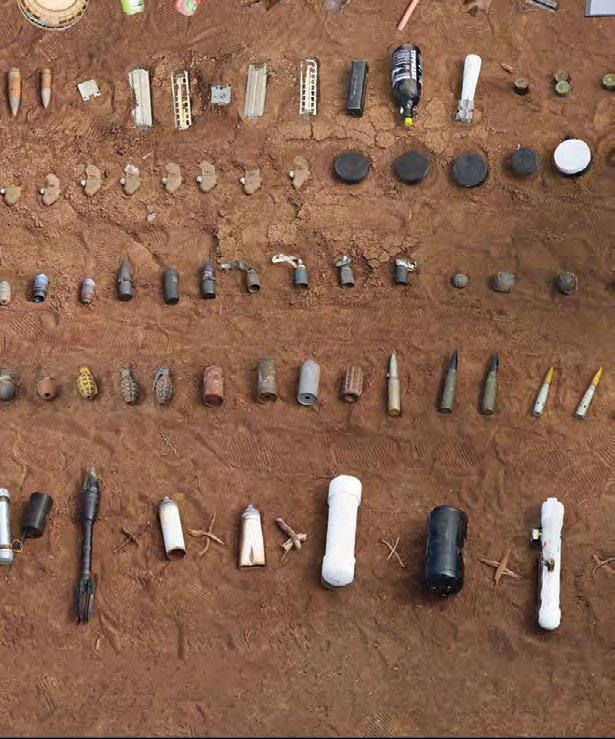
•
• Emergency Risk
PAPERS FOR CALLS Volume 28 JOURNAL Join the conversation. Submissions to cisr-journal@jmu.edu Center for International Stabilization and Recovery James Madison University, MSC 4902 Harrisonburg, VA 22807 / USA www.jmu.edu/cisr
Risk Education and Victim Assistance
Lasting Change
Broadening Victim Assistance to Enact
Education
courtesy of Jasper Baur, Gabriel Steinberg, John Frucci, Anthony Brinkley, and the Demining Research Community.
Image










 FSD Technical Advisor conducting capacity development activity on render safe procedures for SHO staff, Iraq, January 2021.
FSD Technical Advisor conducting capacity development activity on render safe procedures for SHO staff, Iraq, January 2021.

















 Doreen Noda’s son Charley, an accountant, died in 2021 at a church fundraising event alongside his friend Rasif Hilly, a mechanical engineer who worked at the airport. An eighty-year-old artillery shell exploded beneath a barbecue pit they were tending. The absence of accident data in Solomon Islands means that it is difficult to gauge the true impact of EO contamination. Courtesy of Simon Conway/The HALO Trust.
Doreen Noda’s son Charley, an accountant, died in 2021 at a church fundraising event alongside his friend Rasif Hilly, a mechanical engineer who worked at the airport. An eighty-year-old artillery shell exploded beneath a barbecue pit they were tending. The absence of accident data in Solomon Islands means that it is difficult to gauge the true impact of EO contamination. Courtesy of Simon Conway/The HALO Trust.












































































